The post The Top 50 Travel Blogs (2nd Half: 2018) appeared first on The Expeditioner Travel Site.
]]>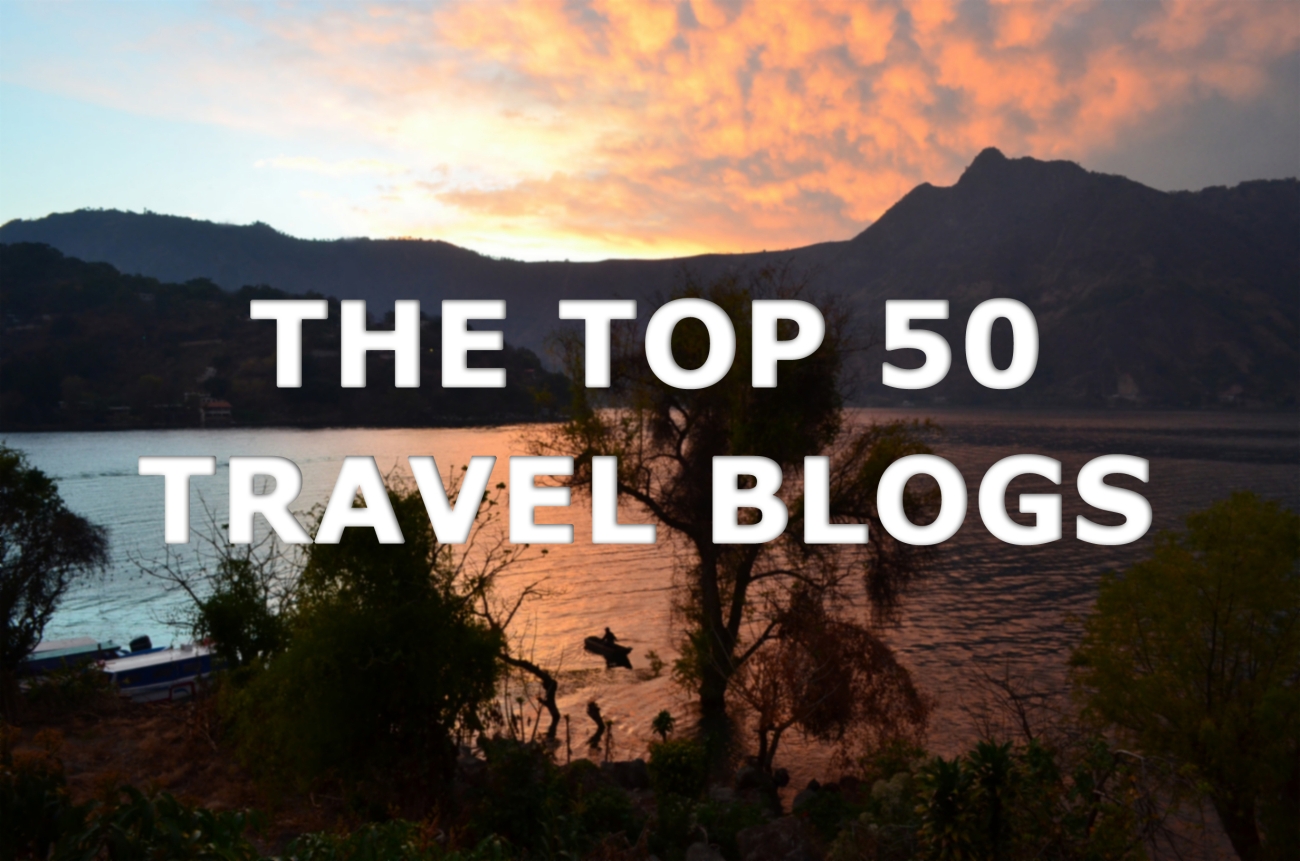
Below is a list of the top 50 travel blogs for the 2nd half (July — December) of 2018 ranked by visitor traffic.
There are a few other sites that have put together their own lists of the “top” travel blogs.
However, each has their own subjective means of ranking sites, using everything from Alexa scores, Twitter followers, Facebook likes, estimated traffic, inbound Google links and even subjective design criteria.
My intention was to create the most objective and accurate list of the most popular travel blogs.
Therefore, this list is based solely on the number of visitors a travel blog receives. To read more about how this list was put together, please read below.
I reached out to a large sampling of travel bloggers and asked that they provide me with a screenshot of their Google Analytics page reflecting their site’s visitor statistics over the most recent quarters. The reasoning behind this method was that I wanted to obtain a rolling average to compensate for monthly spikes that may have occurred. Further, utilizing Google Analytics as the uniform measure of traffic helped to ensure uniformity of data across all sampling.
Of course, due to this method of collecting data, only those site owners that submitted their statistics were included for consideration in the rankings. Those that did not submit were not considered. Further, in an effort to maximize the number of participants and to protect specific traffic numbers that some site owners regard as sensitive and private, I agreed to keep all specific data confidential and not include those numbers in the rankings.
Why This Metric?
Simple, it’s the most accurate, best picture of a site’s traffic. As everyone knows, Alexa is not very accurate and can be easily manipulated. Inbound links are a great sign of SEO, but just because a site does well with Google doesn’t mean it has a lot of visitors. Twitter followers are great, but that doesn’t necessarily translate into site readers.
Quite simply, unique visitors is the one metric that most accurately reflects a site’s readership.
Who Cares?
I understand that just because a site gets a high number of unique visitors doesn’t mean it’s the highest quality site. There are plenty of excellently written, well-designed, engaging sites that may not have high traffic numbers.
My intention was not to create a list of the best, or the most useful, or the most professional travel blogs. I simply wanted to create the most accurate list of the most visited blogs. Just as the movie weekend box office results are reported every week, I simply wanted to create an unbiased, objective list of the most visited travel blogs for research purposes.
Finally, I hope this list will serve as a useful guide and a good starting point for travelers and readers around the world looking to explore the vibrant and eclectic travel blogging community, and expose them to some great travel blogs that they otherwise may not be reading.
*
If you are a travel blogger who would like to be considered for inclusion in the 2019 1st half list, please e-mail me a screenshot of your Google Analytics page reflecting your site’s traffic including the number of unique visitors (click on “Audience” then “Overview”) from January 1 — June 30 to: Matt@TheExpeditioner.com.
*
Click Here to Read the Complete Past Lists of The Top 50 Travel Blogs

/
 Matt Stabile is the Founder and Editor-in-Chief of The Expeditioner. The Expeditioner began in 2008 and is headquartered in New York City. You can read his writings, watch his travel videos or contact him at any time at TheExpeditioner.com.
Matt Stabile is the Founder and Editor-in-Chief of The Expeditioner. The Expeditioner began in 2008 and is headquartered in New York City. You can read his writings, watch his travel videos or contact him at any time at TheExpeditioner.com.
The post The Top 50 Travel Blogs (2nd Half: 2018) appeared first on The Expeditioner Travel Site.
]]>The post Top 11 Free Things To Do In New York City This December appeared first on The Expeditioner Travel Site.
]]>
Everyone knows New York City is an expensive town, especially in December around the holidays. To save some money, try these tips for free things to do this December during your visit.

1) 9/11 Memorial
The 9/11 Memorial, on the site of the former Twin Towers, opened on September 12, 2011, in time for the 10th anniversary of 9/11, and was easily the most anticipated new project in the city for years. The memorial features two reflecting pools nearly an acre in size each, each filled with the largest man-made waterfalls in North America. Surrounding the imposing structures are the names of the nearly 3,000 victims inscribed on bronze parapets surrounding the pools.
Though entrance is free to the park is free, access to the new 9/11 Memorial and Museum must be purchased in advance. It takes about two hours to visit the museum, and you can purchase tickets in advance here.
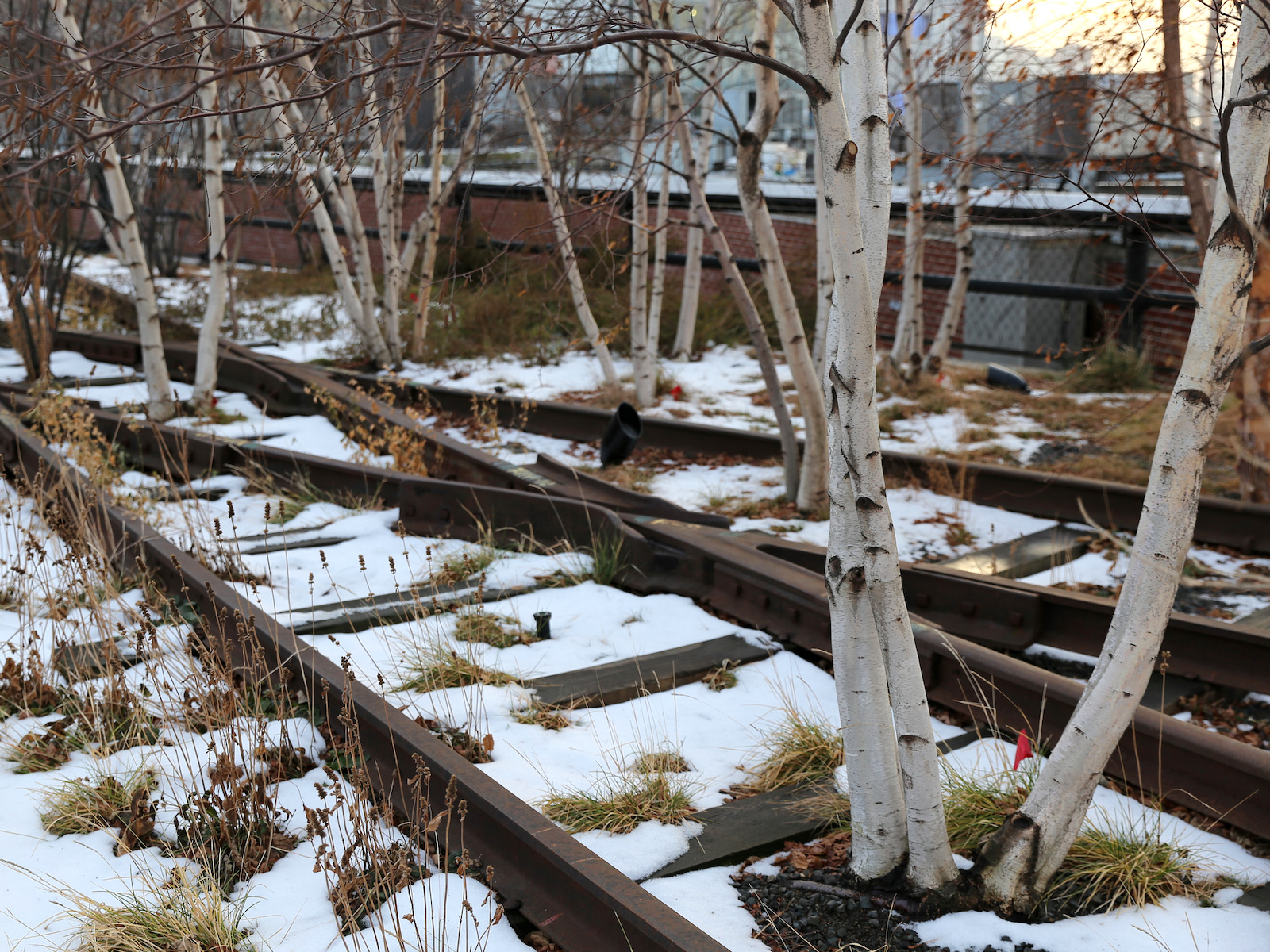
2) The High Line
One of the world’s premier examples of urban preservation, the High Line is an elevated train line located on Manhattan’s West Side that has been transformed into a public park featuring Hudson River views, natural landscaping and a rotating collection of public art projects. Popular among city-dwellers and visitors alike, the park has become a major draw to a neighborhood once only populated in the evening hours.
The High Line is a perfect way to spend the afternoon with a coffee in hand, taking in the sights of New York in one of the most unique ways possible. Click here for dining options and things to do in the area.
For the High Line hours and directions click here.
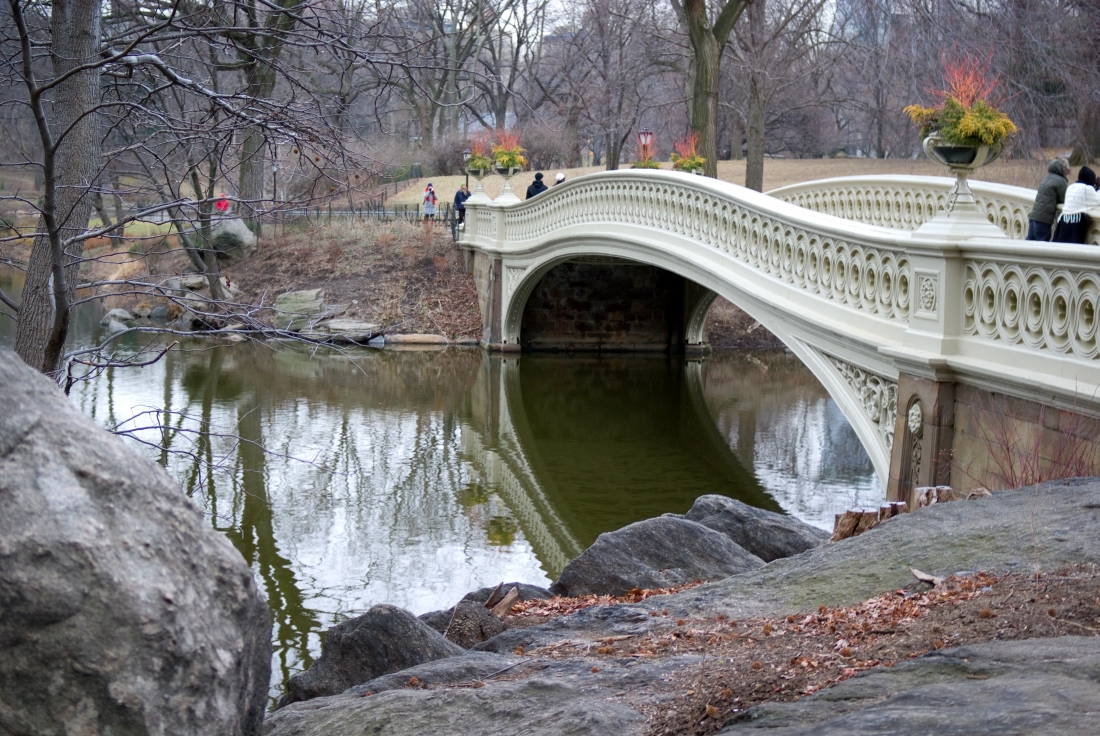
3) Free Central Park Tours
Central Park, one of the world’s most iconic parks, not only offers hundreds of free ways to explore its 843 acres (which makes up 6% of Manhattan if you were wondering), but is also home to daily free tours led by park representatives.
For example, the Ramble Tour will take you over streams, under arches and through the woods along a maze of pathways in the secluded 36-acre woodland section of the park. The Iconic Views of Central Park Tour will take you to the park’s most iconic landmarks including, the Dairy, Sheep Meadow, Cherry Hill, the Lake, Bow Bridge, Bethesda Terrace, the Mall, and Literary Walk.
For a full schedule of all of the park’s ticketed and free tours, visit the Central Park tour calendar.
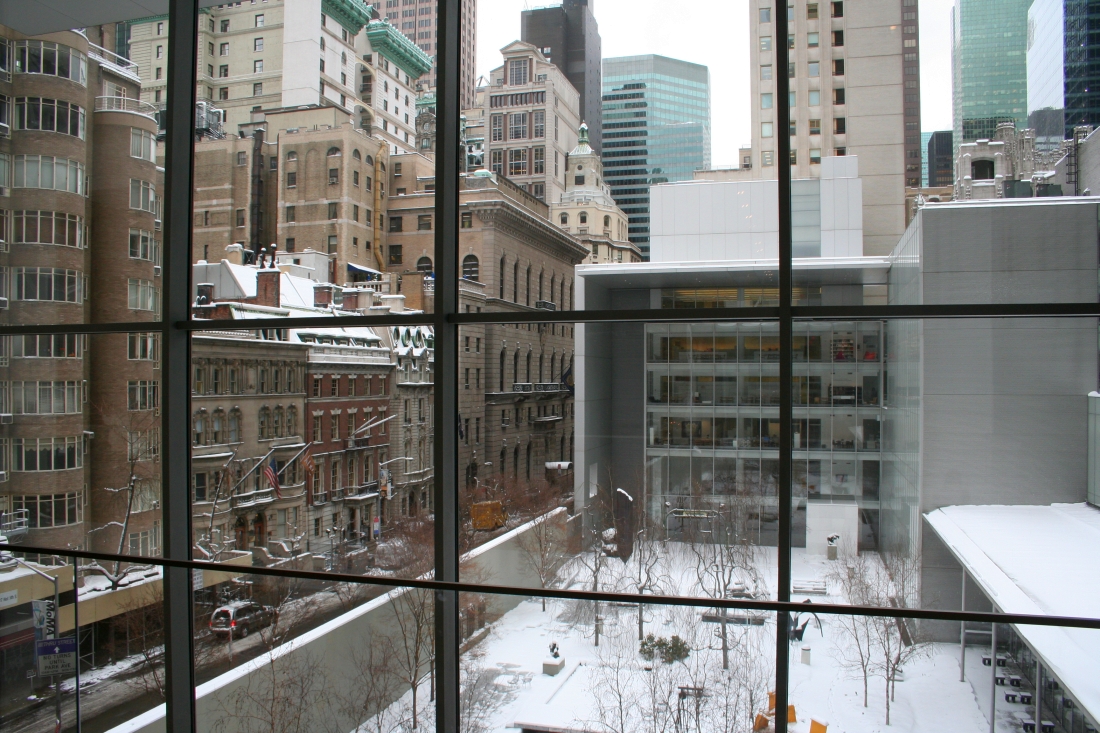
4) MoMA For Free
It’s nearly impossible to visit New York without spending at least one morning or afternoon visiting one of the world’s greatest collections of art at MoMA (the Museum of Modern Art). If you’re visiting over the weekend, MoMA has free admission every Friday from 4:00 p.m. until closing at 8:00 p.m. Lines form quickly, especially during the holidays, so be sure to get there early to leave plenty of time to take it all in.
For hours and information about MoMA click here.
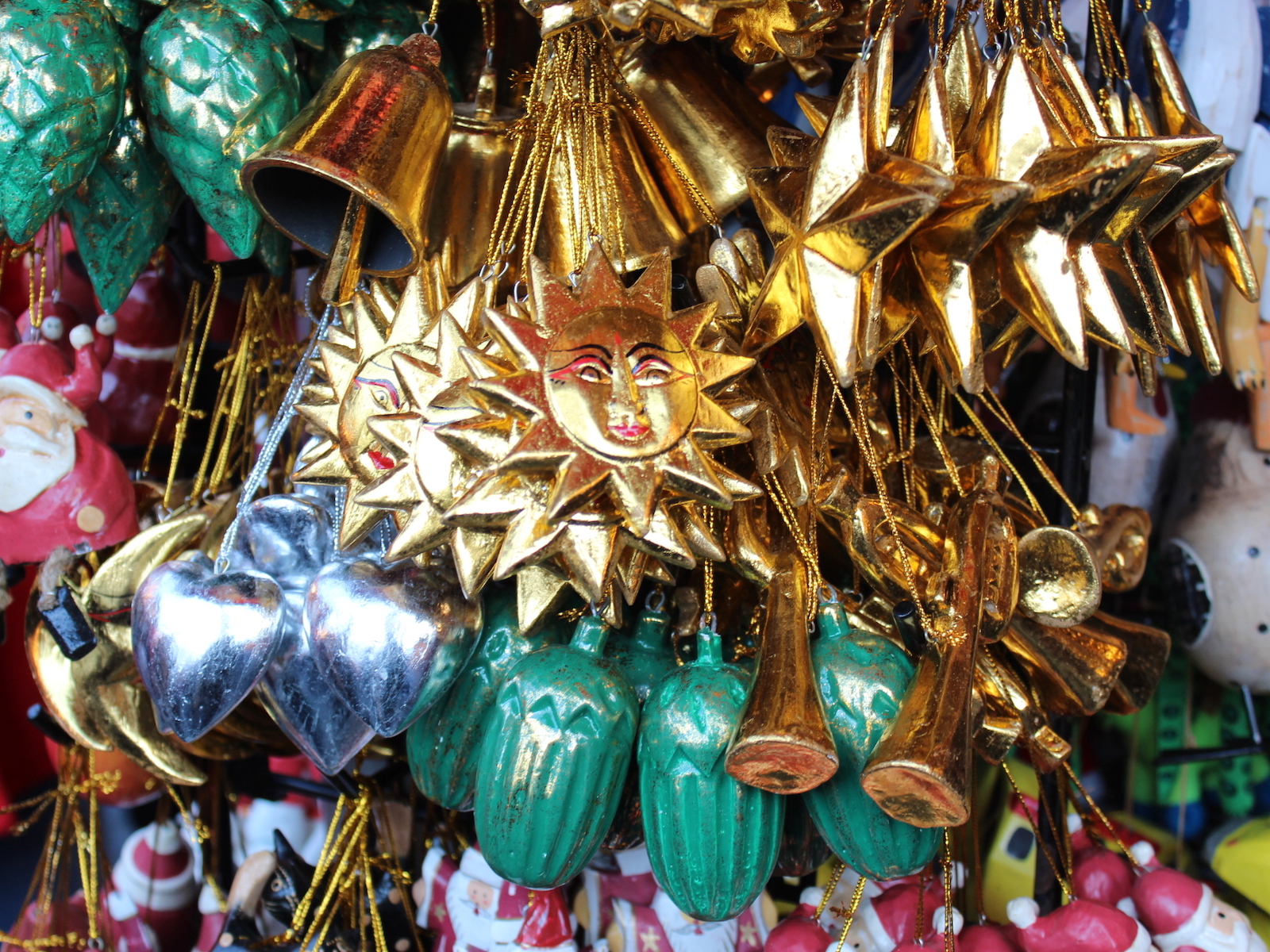
5) Christmas Markets
Remember when Harry Potter and the crew visited Hogsmeade Village and found themselves in a Dickensian Christmas wonderland? Well, this might be a stretch, but if you happen to go at night after some snow has just fallen to one of the various holiday markets that spring up around Manhattan every December, you just may get the same experience. I know, it’s a stretch, but it’s still a great experience to help get you in the holiday mood.
Head to the Union Square Holiday Market for the city’s largest holiday market with nearly 100 vendors selling everything from German chocolate to decorative socks. Nearby, on Broadway between 13th and 14th street, is Max Brenner, where you can pick up the granddaddy of hot chocolate drinks.
Visit here or a list of 10 of the best holiday markets around New York.
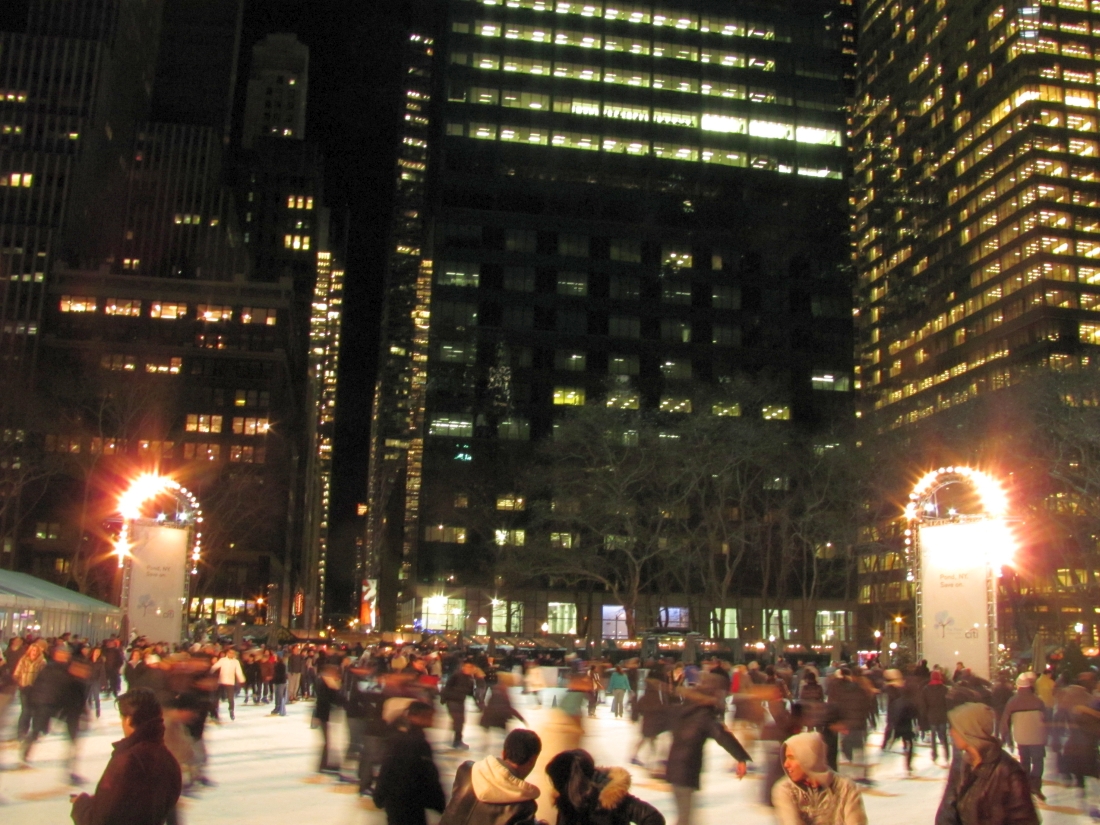
6) Ice Skating In Bryant Park
It may not be as well known as the one at nearby Rockefeller Center, but the free ice skating rink (or Citi Pond for you corporate-minded folks) at Bryant Park is a full $28 cheaper, saving you much-needed cash for the inevitable trip to the emergency room (come on, you haven’t done this since you were 10, you think you’re not going to take a few spills?).
However, take note that the skate rentals are $20 if you don’t bring your own pair.
For more information about the rink click here.
7) Christmas in Midtown
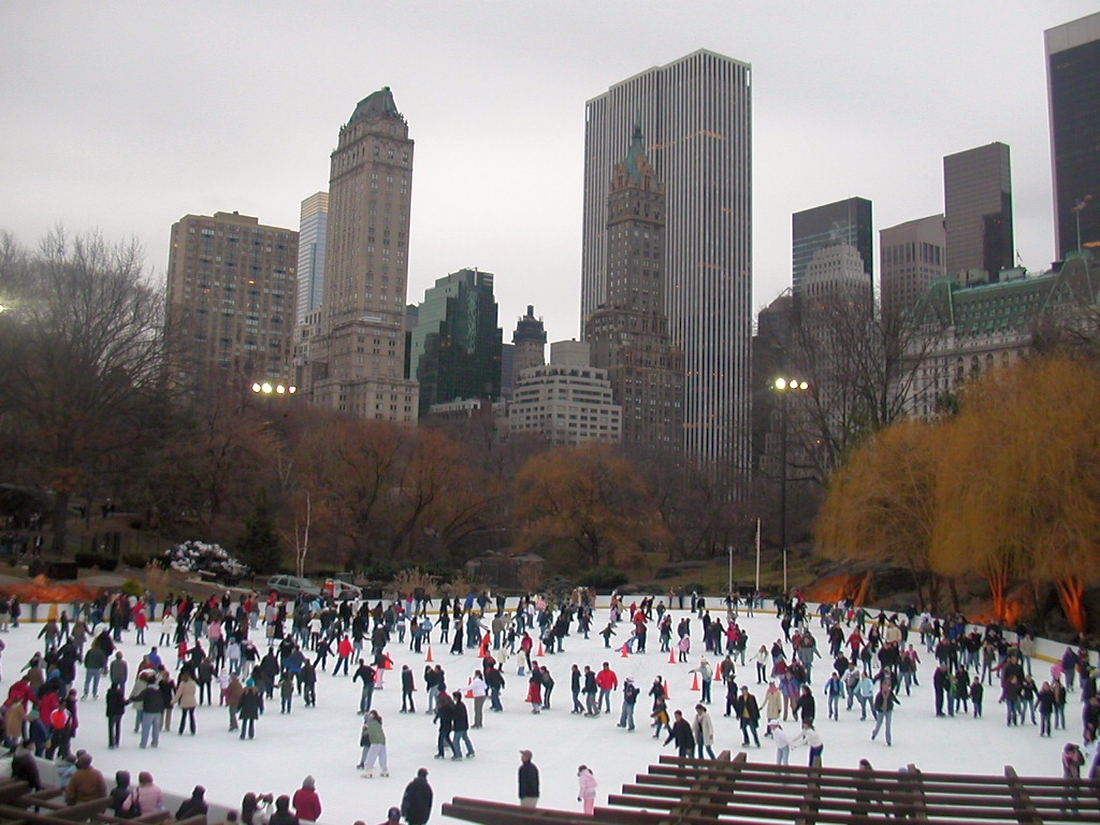
I wouldn’t normally advise anyone to spend too much time in Midtown in December given the throngs of tourists and exorbitant prices charged for everything from coffee to street pretzels. But, from Thanksgiving through New Year’s, a large swath of the neighborhood transforms into some the city’s most iconic holiday sights that even a travel snob/Scrooge would have trouble staying away from.
Start at the corner of Sixth Avenue and 50th Street to see Radio City Music Hall with its giant Christmas tree and tin soldiers decorating its marquee, then make your way down 50th Street and through the massive crowds to catch a glimpse of the ice skaters and Christmas tree at Rockefeller Center (last year’s tree was an 80-foot Norway spruce hailing from Flanders, New Jersey).
Across the street on Fifth Avenue are the iconic holiday window displays at Saks Fifth Avenue. After walking by them, head north on Fifth Avenue to see some of the country’s most expensive shops along the famed stretch of Fifth Avenue leading to Central Park. Here you’ll also see some of the most expensively decorated shops as well, including the Cartier Building with its red ribbon wrapping the entire facade and the window displays at Bergdorf Goodman.
Finally, eight blocks north at 58th Street, you’ll come to FAO Schwartz, the world’s most famous toy store (and site of some massive lines come Christmas). To wrap things up, take in the glitzy Plaza Hotel across the street (and grab a bite to eat at the new The Plaza Food Hall), then make your way through the 59th Street entrance of Central Park and stroll down to Wollman Rink and watch the ice skaters underneath one of the world’s most famous skylines.
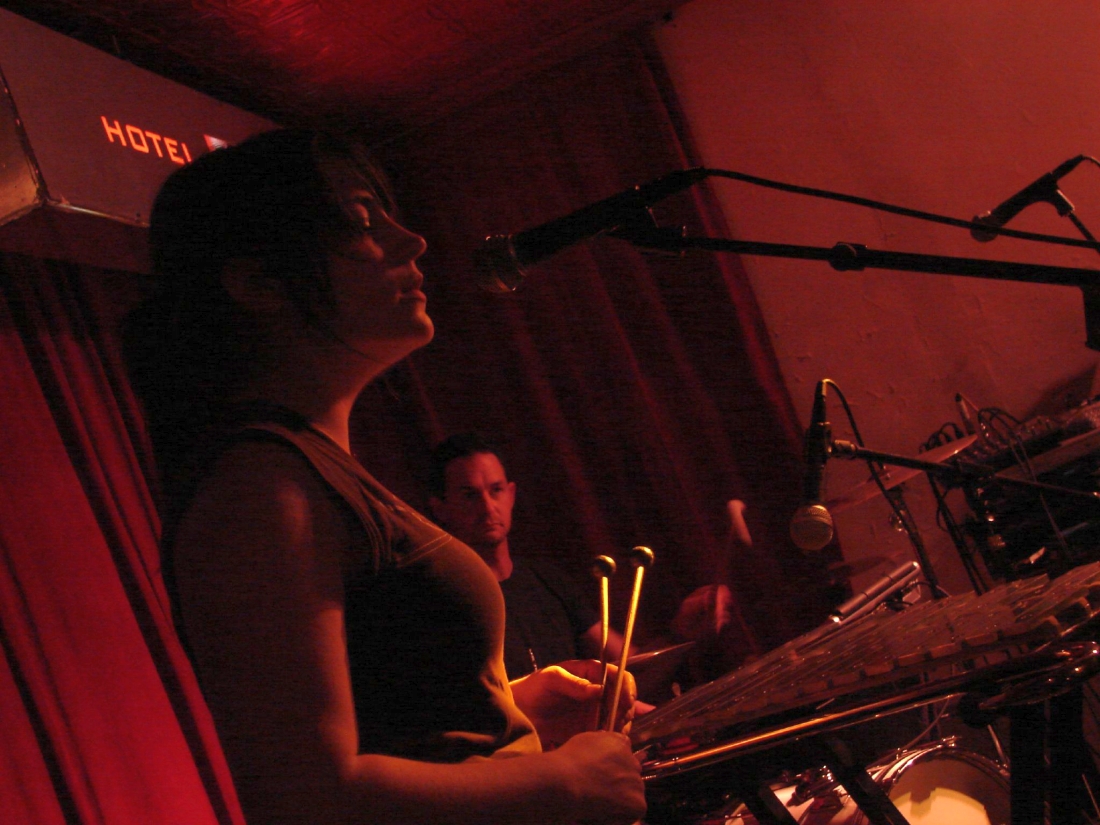
8) Barbes
From accordion-playing divas to Slavic soul, Barbes in Brooklyn’s Park Slope offers some of the city’s best and most eclectic variety of free music every night. Drinks are standard price and collection hats are usually passed around after the performances.
If you’re staying in Manhattan, don’t worry about getting lost just because you’re leaving the island. Barbes is literally across the street from the F stop, a 20-minute ride from Midtown.
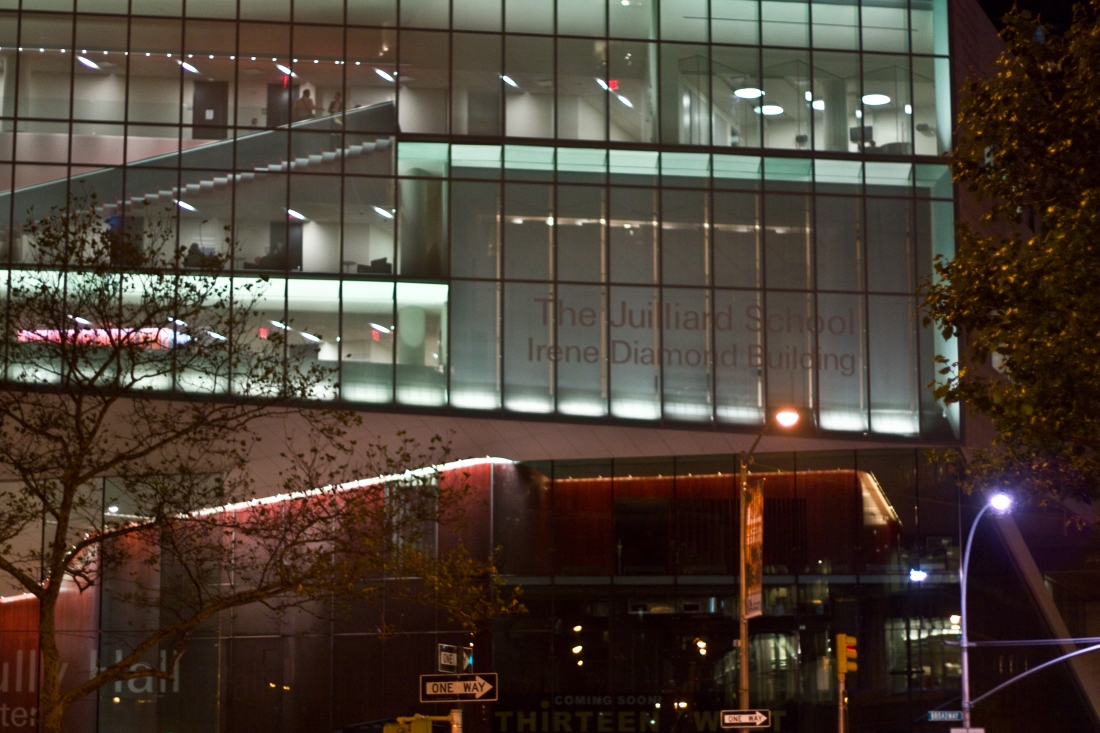
9) Free Juilliard Performances
Heading to Lincoln Center for world-class performing arts? Good news for you, many of the performers you’re paying to see started out just next door at Juilliard, and all of them spent a good chunk of their time performing for free at recitals open to the public. These free performances range from Jazz, Chamber Music, Orchestral, Solos, Dance, Opera and Drama.
For a full schedule of the wide variety of performances, click here to visit Juilliard’s calendar of events.
When you’re at Lincoln Center, stick around for a free performance by the new fountain in the center of the plaza. Designed by the same people who brought you the waterworks at Vegas’ Bellagio, the fountain’s 353 nozzles are able to shoot water 40 feet in the air to create an “aquatic ballet.”
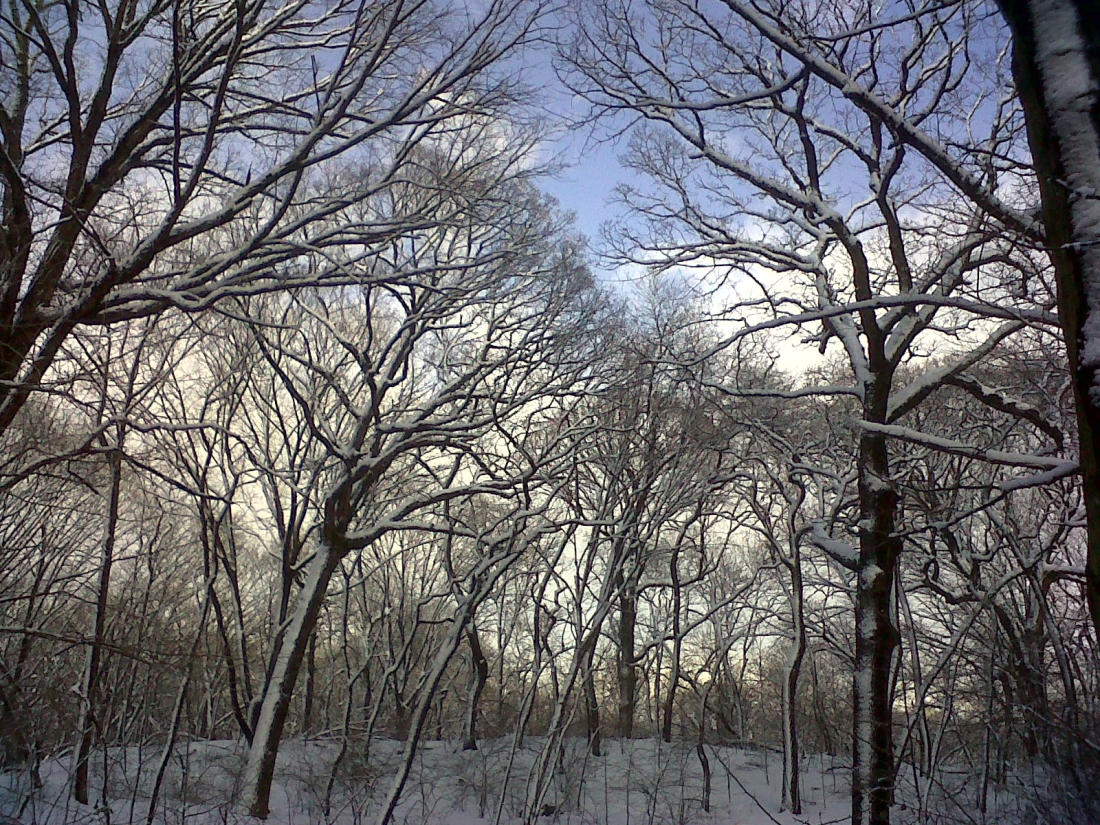
10) A New England Winter In New York
A good majority of visitors to New York this time of year are from far-flung and usually much warmer locations, and for many of them, this whole northeast United States thing is a novelty to them. Why not try fitting in a whole other region, all while staying in New York?
Stay with me here. Take a short subway ride to Prospect Park, in the heart of Brooklyn, and get your Thoreau on by making your way to one of the four nature trails that meander through the woods — a spectacular sight in the summer, and simply magical in the winter. Snow-draped pines, squirrels foraging in the fallen leaves, a rastafarian drummer playing for loose change: just like a Frost poem.
Finish up with a stroll through scenic Park Slope (like Hogsmeade, but with strollers), and cozy up with a warm drink in front of a roaring fire at nearby Union Hall, New York’s preeminent winter bar.
For information about Prospect Park click here.
For information about Union Hall click here.

11) Arthur Avenue
Sure, Manhattan has Little Italy, Brooklyn has, well, Brooklyn, but many visitors don’t know that the Bronx has New York’s most intact, most authentic Little Italy this side of the Mediterranean: Arthur Avenue.
Head north to the outer reaches of the outer boroughs to this five-block stretch for the afternoon and wander in and out of the many delis, bakeries, and coffee shops, all with nary a tourist in sight. And dont’ worry, you can be sure every business will be decked-out for the holidays.
Visit here for directions and a list of businesses.
Miscellaneous Resources
For more ideas for free things to do in New York, check out these resources:
• NYCGO (New York City’s official marketing, tourism and partnership organization)
• Time Out’s Guide to Free Things to Do in NYC

/
 Matt Stabile is the Founder and Editor-in-Chief of The Expeditioner. The Expeditioner began in 2008 and is headquartered in New York City. You can read his writings, watch his travel videos or contact him at any time at TheExpeditioner.com.
Matt Stabile is the Founder and Editor-in-Chief of The Expeditioner. The Expeditioner began in 2008 and is headquartered in New York City. You can read his writings, watch his travel videos or contact him at any time at TheExpeditioner.com.
The post Top 11 Free Things To Do In New York City This December appeared first on The Expeditioner Travel Site.
]]>The post The Top 50 Travel Blogs (2nd Quarter: 2018) appeared first on The Expeditioner Travel Site.
]]>
Below is a list of the top 50 travel blogs for the 2nd quarter (April — June) of 2018 ranked by visitor traffic.
There are a few other sites that have put together their own lists of the “top” travel blogs.
However, each has their own subjective means of ranking sites, using everything from Alexa scores, Twitter followers, Facebook likes, estimated traffic, inbound Google links and even subjective design criteria.
My intention was to create the most objective and accurate list of the most popular travel blogs.
Therefore, this list is based solely on the number of visitors a travel blog receives. To read more about how this list was put together, please read below.
I reached out to a large sampling of travel bloggers and asked that they provide me with a screenshot of their Google Analytics page reflecting their site’s visitor statistics over the most recent quarter. The reasoning behind this method was that I wanted to obtain a rolling average to compensate for monthly spikes that may have occurred. Further, utilizing Google Analytics as the uniform measure of traffic helped to ensure uniformity of data across all sampling.
Of course, due to this method of collecting data, only those site owners that submitted their statistics were included for consideration in the rankings. Those that did not submit were not considered. Further, in an effort to maximize the number of participants and to protect specific traffic numbers that some site owners regard as sensitive and private, I agreed to keep all specific data confidential and not include those numbers in the rankings.
Why This Metric?
Simple, it’s the most accurate, best picture of a site’s traffic. As everyone knows, Alexa is not very accurate and can be easily manipulated. Inbound links are a great sign of SEO, but just because a site does well with Google doesn’t mean it has a lot of visitors. Twitter followers are great, but that doesn’t necessarily translate into site readers.
Quite simply, unique visitors is the one metric that most accurately reflects a site’s readership.
Who Cares?
I understand that just because a site gets a high number of unique visitors doesn’t mean it’s the highest quality site. There are plenty of excellently written, well-designed, engaging sites that may not have high traffic numbers.
My intention was not to create a list of the best, or the most useful, or the most professional travel blogs. I simply wanted to create the most accurate list of the most visited blogs. Just as the movie weekend box office results are reported every week, I simply wanted to create an unbiased, objective list of the most visited travel blogs for research purposes.
Finally, I hope this list will serve as a useful guide and a good starting point for travelers and readers around the world looking to explore the vibrant and eclectic travel blogging community, and expose them to some great travel blogs that they otherwise may not be reading.
*
Click Here to Read the Complete Past Lists of The Top 50 Travel Blogs

/
 Matt Stabile is the Founder and Editor-in-Chief of The Expeditioner. The Expeditioner began in 2008 and is headquartered in New York City. You can read his writings, watch his travel videos or contact him at any time at TheExpeditioner.com.
Matt Stabile is the Founder and Editor-in-Chief of The Expeditioner. The Expeditioner began in 2008 and is headquartered in New York City. You can read his writings, watch his travel videos or contact him at any time at TheExpeditioner.com.
The post The Top 50 Travel Blogs (2nd Quarter: 2018) appeared first on The Expeditioner Travel Site.
]]>The post The Top 50 Travel Blogs (1st Quarter: 2018) appeared first on The Expeditioner Travel Site.
]]>
Below is a list of the top 50 travel blogs for the 1st quarter (January — March) of 2018 ranked by visitor traffic.
There are a few other sites that have put together their own lists of the “top” travel blogs.
However, each has their own subjective means of ranking sites, using everything from Alexa scores, Twitter followers, Facebook likes, estimated traffic, inbound Google links and even subjective design criteria.
My intention was to create the most objective and accurate list of the most popular travel blogs.
Therefore, this list is based solely on the number of visitors a travel blog receives. To read more about how this list was put together, please read below.
I reached out to a large sampling of travel bloggers and asked that they provide me with a screenshot of their Google Analytics page reflecting their site’s visitor statistics over the most recent quarter. The reasoning behind this method was that I wanted to obtain a rolling average to compensate for monthly spikes that may have occurred. Further, utilizing Google Analytics as the uniform measure of traffic helped to ensure uniformity of data across all sampling.
Of course, due to this method of collecting data, only those site owners that submitted their statistics were included for consideration in the rankings. Those that did not submit were not considered. Further, in an effort to maximize the number of participants and to protect specific traffic numbers that some site owners regard as sensitive and private, I agreed to keep all specific data confidential and not include those numbers in the rankings.
Why This Metric?
Simple, it’s the most accurate, best picture of a site’s traffic. As everyone knows, Alexa is not very accurate and can be easily manipulated. Inbound links are a great sign of SEO, but just because a site does well with Google doesn’t mean it has a lot of visitors. Twitter followers are great, but that doesn’t necessarily translate into site readers.
Quite simply, unique visitors is the one metric that most accurately reflects a site’s readership.
Who Cares?
I understand that just because a site gets a high number of unique visitors doesn’t mean it’s the highest quality site. There are plenty of excellently written, well-designed, engaging sites that may not have high traffic numbers.
My intention was not to create a list of the best, or the most useful, or the most professional travel blogs. I simply wanted to create the most accurate list of the most visited blogs. Just as the movie weekend box office results are reported every week, I simply wanted to create an unbiased, objective list of the most visited travel blogs for research purposes.
Finally, I hope this list will serve as a useful guide and a good starting point for travelers and readers around the world looking to explore the vibrant and eclectic travel blogging community, and expose them to some great travel blogs that they otherwise may not be reading.
*
Click Here to Read the Complete Past Lists of The Top 50 Travel Blogs

/
 Matt Stabile is the Founder and Editor-in-Chief of The Expeditioner. The Expeditioner began in 2008 and is headquartered in New York City. You can read his writings, watch his travel videos or contact him at any time at TheExpeditioner.com.
Matt Stabile is the Founder and Editor-in-Chief of The Expeditioner. The Expeditioner began in 2008 and is headquartered in New York City. You can read his writings, watch his travel videos or contact him at any time at TheExpeditioner.com.
The post The Top 50 Travel Blogs (1st Quarter: 2018) appeared first on The Expeditioner Travel Site.
]]>The post Scottsdale Travel Guide appeared first on The Expeditioner Travel Site.
]]>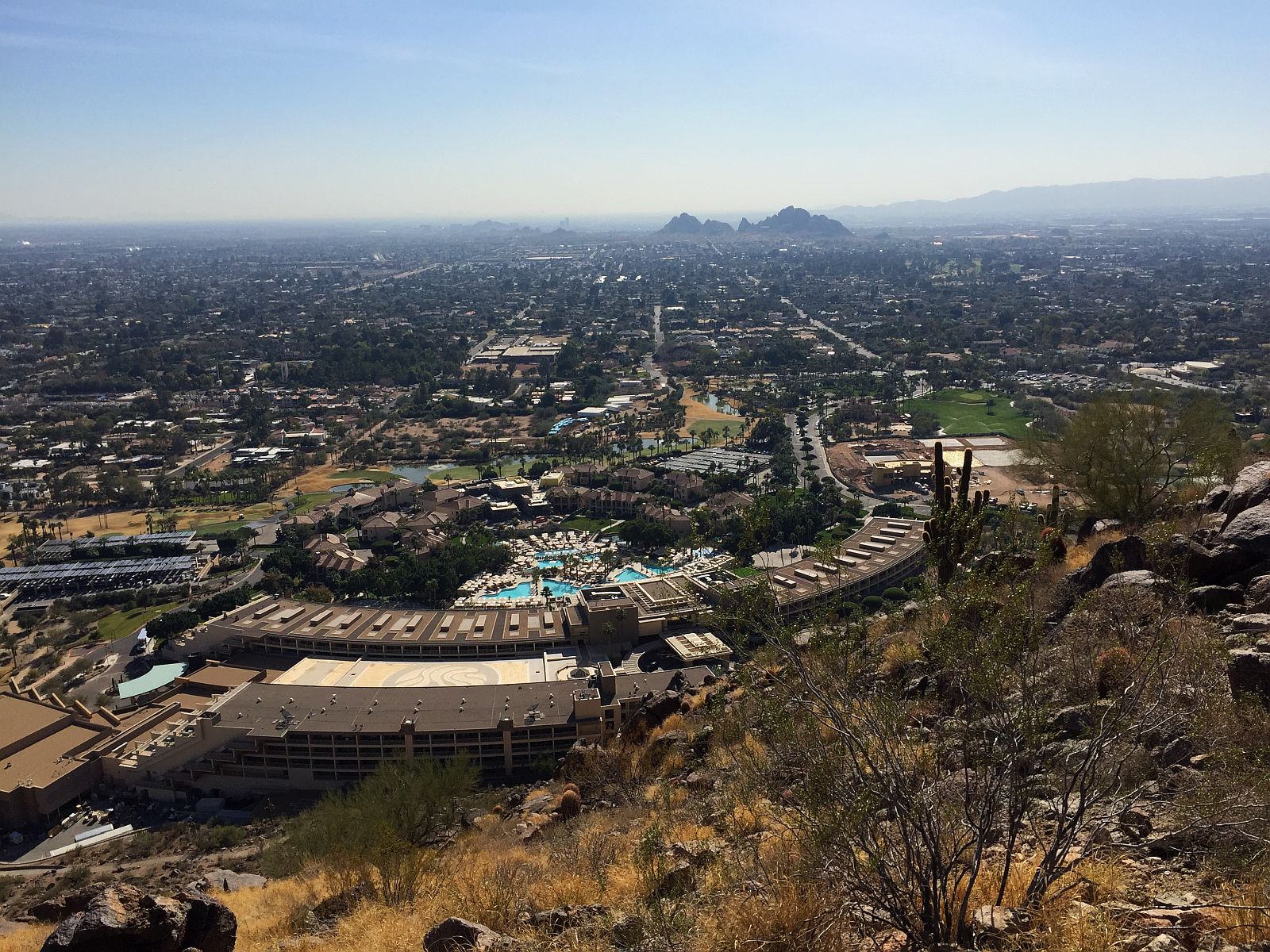
Scottsdale, Arizona, is one of my favorite places to visit any time of year. Why do I love coming here so much? The real question is: Where to start? Located adjacent to Phoenix and in the heart of the Sonoran Desert, Scottsdale’s weather is warm and sunny all year long, so you can take advantage of outdoor activities from swimming, hiking, horseback riding and golf no matter what season you visit. The restaurants, bolstered by the support of millions of visitors and supplied by local, fresh ingredients, are fantastic, and the number of hotels and resorts here means you can find a property for whatever mood you’re in, whether it’s ultra-luxury to young and hip.
On top of all that, Scottsdale has more spas per capita here than anywhere else in the country, it’s hard to drive more than 5 minutes in any direction without coming across a golf course, and the people that have chosen to live in this desert paradise are welcoming and friendly. It’s no surprise that over 4.5 million visitors travel to Scottsdale every year to experience all that the city has to offer.
It would be impossible to list every place to stay, pamper yourself, or eat at in Scottsdale. But with so many options to decide from, I’ve put together a travel guide to help you find some of the best hotels, spas, and restaurants you should visit during your next trip to Scottsdale.
Hotels
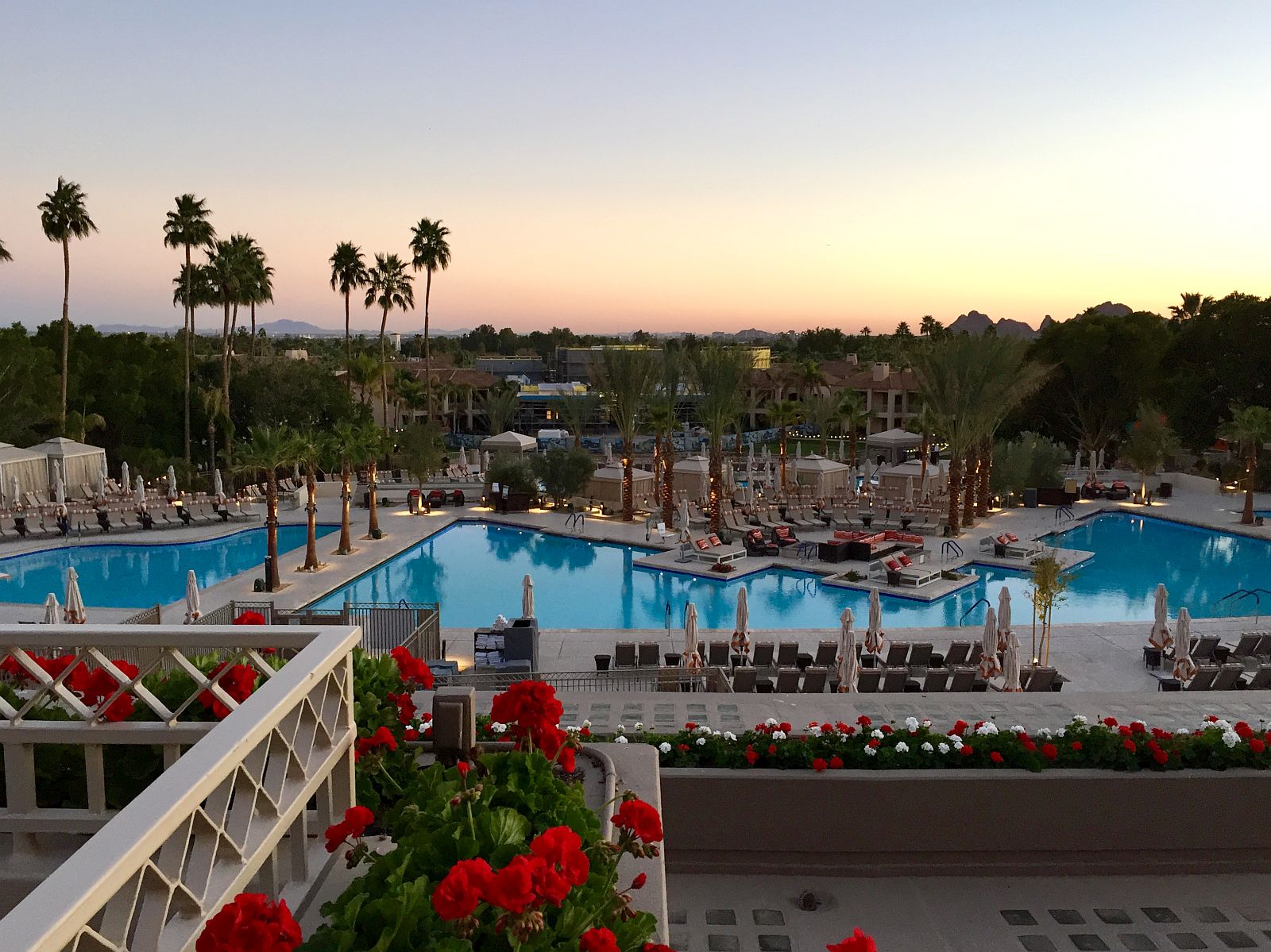
The Phoenician
The Phoenician is one of Scottsdale’s best known hotels, and there’s good news for visitors who haven’t stayed there in a while: it’s currently in the tail-end of a three-year, major makeover. Located at the foot of Camelback Mountain and only a short drive from Old Town, The Phoenician is one of the best situated resorts in Scottsdale. We made sure to get up early one morning and make the short drive to Cholla trailhead, the most popular gateway to hiking iconic Camelback Mountain.
The most noticeable change that long-time guests will notice is the lobby, which has been completely renovated, giving it a contemporary, Southwest feel featuring a color scheme reflecting the colors of the desert, and including a collection of art from local artists in the region. They’ve also given the bar, The Thirsty Camel Lounge, a makeover, including a new menu and a new location that provides panoramic views over the valley. For happy hour, my recommendation is to head to the bar around sunset and order the flavorful El Dorado, which features Herradura Reposado tequila, jalapeño, pineapple and lemon Juice, Grapefruit Zest, Agave Nectar and grapefruit bitters.

Mountain Shadows
Mountain Shadows is part of a wave of new hotels in Scottsdale making a play for the younger, hipper visitors that are frequenting the city now more than ever. Built on the site of the former Mountain Shadows — one of the area’s first major hotels, and which was a favorite destination for the Hollywood jet-set circa the 1960’s — the hotel has maintained its cool, Mid-Century vibe. The long, narrow pool offers amazing views of Camelback Mountain for sunbathers, and The Short Course, the new par-3 course, is a fun way to get in a round of golf without too much time commitment.
Thought retro in style, the rooms have a distinctly contemporary, urban feel: think exposed concrete ceilings and open bathroom layout. When you’re ready for dinner, the new Hearth ’61 features an open kitchen and a menu from Chef Charles Wiley inspired from local flavors and fresh, organic ingredients. And when you’re ready for drinks, head to the lively bar adjacent to the restaurant for live music on the weekends and plenty of people-watching as visitors stroll in for date night.
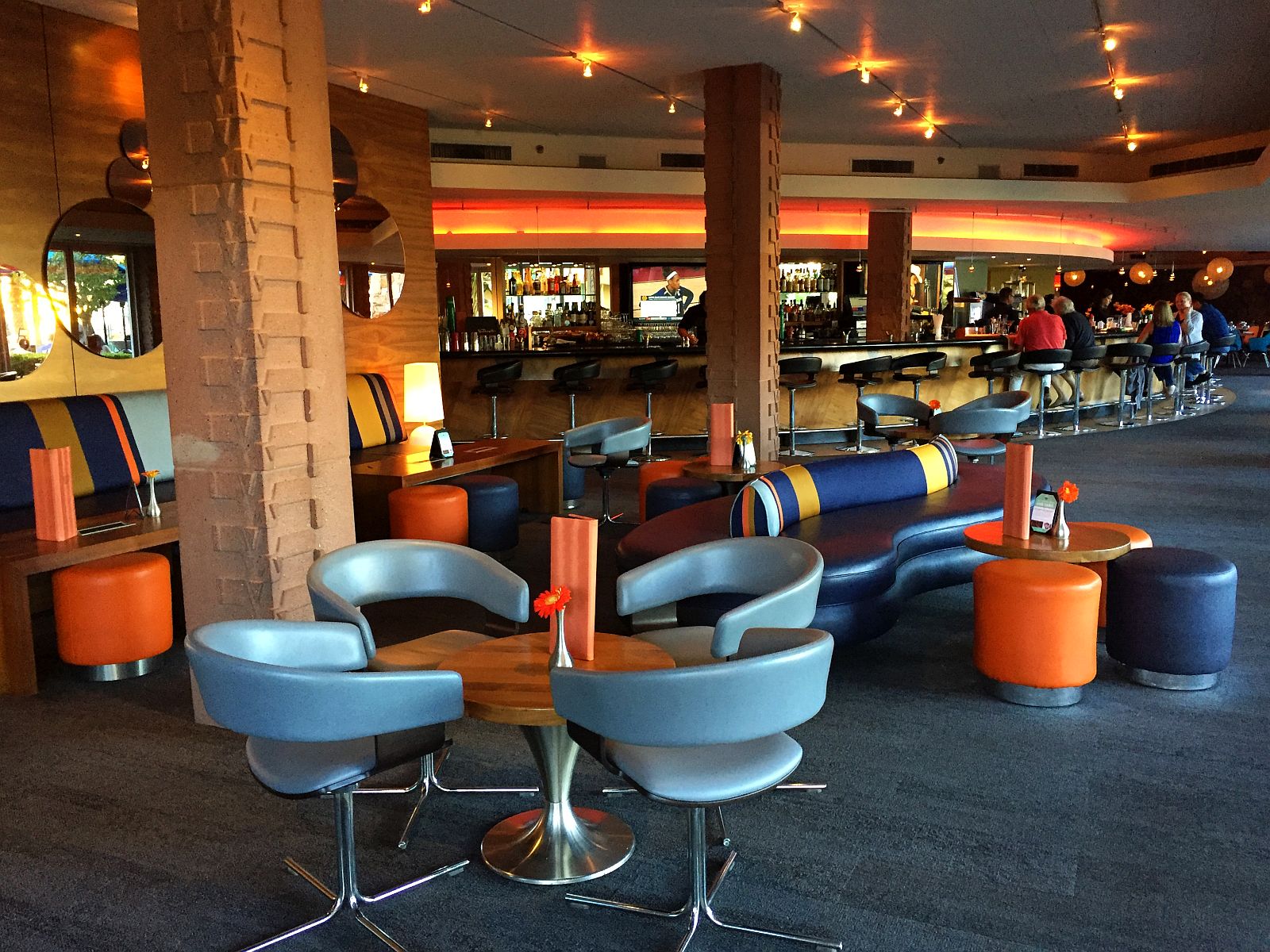
Hotel Valley Ho
Hotel Valley Ho is located just a short walk from Old Town, Scottsdale, and is one of the best-situated hotels if you are looking to explore the area by foot. It’s also one of Scottsdale’s most fun hotels. The property was originally built in the 1950’s, and was the place to visit for Hollywood stars ranging from Bing Crosby to Zsa Zsa Gabor. For those looking for some fun on the weekends, the The OH Pool hosts pool parties throughout the summer featuring a live DJ and rentable cabanas.
A few years back the hotel was expanded, most notably with the addition of the multi-story Tower, which features roomy suites and amazing views in all directions. If you’re really looking to make the most out of your stay, be sure to book one of the many suites that include a full kitchen, comfy living room with walk-out deck, and enough room to host a gathering of all of the new friends you make at the pool.
Spas
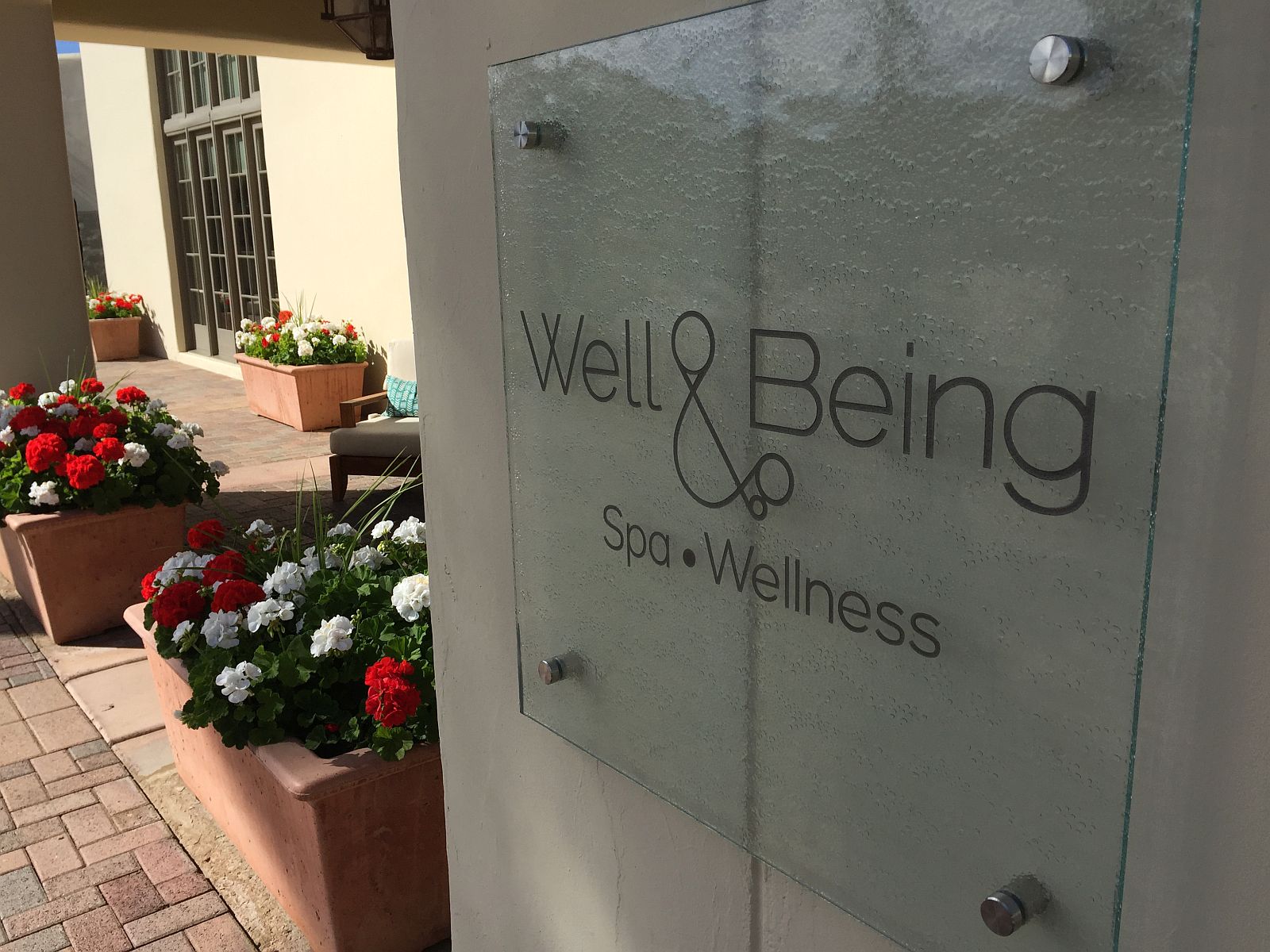
Well & Being Spa at Fairmont
The Well & Being Spa is located at the Fairmont Scottsdale Princess, one of the largest and best-known resorts in Scottsdale. The property itself is huge (it’s spread out over 65 acres), and the spa is no different. Inspired by Havasupai, a hidden oasis deep in the Grand Canyon, the spa features a gift shop, full gym, and yoga and workout studios — and that’s just the start of it. Follow the set of stairs down, and you will enter an expansive space featuring a roomy locker room, pre-massage lounge area, outdoor waterfall hot tub, and access to their exclusive rooftop pool to relax at after your treatment.
I arrived an hour before my visit in order to try out all of the options the spa offers. I started off with the Swedish dry sauna to get the sweat flowing, followed by the steam room, hot therapeutic whirlpool, a refreshing dip in the cold plunge pool, then finally the Swiss shower. I decided to give the Himalayan Salt Stone treatment a try. Featuring warm stones, the masseuse works your entire body delivering salty minerals to your body, with the goal of really working your muscles while also removing toxins.
Thoroughly relaxed and with little motivation to do much else for the rest of the day, I made my way outside and up a set of stairs to the pool where I whittled away the rest of the afternoon under the desert sun having lunch and trying out a few cocktails, including the Arizona Fire & Ice, made with vodka, lemonade, prickly pear and jalapeno.
Well & Being Spa at the Fairmont Scottsdale Princess

Sanctuary on Camelback Mountain
Sanctuary Resort Spa has been a famous destination spa resort for years due to its reputation (even Jay-Z and Beyonce stayed here during their honeymoon). If you’re not lucky enough to have booked a room here, you can still visit the spa, which has an Asian-chic vibe and a laundry list of treatment options. Bamboo shrouds its understated entrance, and the spa features a Zen meditation garden and reflection pool. Though smaller than some of the newer, bigger spas in the area, Sanctuary has a boutique feel. Before my treatment, I spent an extended visit to the eucalyptus steam room to refresh my skin after several days in the dry, desert air.
Known for their highly skilled staff, I chose a classic Swedish massage. The rooms are situated to look out over the garden, and the peaceful spa music and the aroma of the berry-infused lotion used on my skin had me working hard not to nod off and miss everything. My masseuse even paid special attention to my neck which was sore form a vacation-related neck strain from a night spent sleeping on large hotel pillows (there are worse minor injuries to endure).
Sanctuary on Camelback Mountain

We Do Men
For many men, the idea of visiting a traditional spa is out of the question. For those guys, there’s We Do Men, the boutique spa experience tailored just for men. The brainchild of Stacey Grondahl, We Do Men caters to men looking for skin treatments without all the normal fuss. The decor inside is part tattoo parlor, part cigar bar, with leather upholstery, pictures of male icons such as Johnny Cash and Frank Sinatra on the wall, and a faux-diamond encrusted skull that greets you at the entrance.
A look at the names of the treatments here will let you know you’re not in your girlfriend’s spa. The Sake Bomber, Not Another Prick, and Holy Mother Prick(er) are just a few of the options you can choose. With a rockabilly soundtrack on the stereo and a coffee and tobacco-scented candle filling the room with its scent, I had my face worked over for better part of an hour. Despite my beard (something they are very used to working with here), I had my skin treated with blue agave extract, menthol and a pair of metal balls (yes, really) to make me look glowing like I had never glowed before.
Restaurants
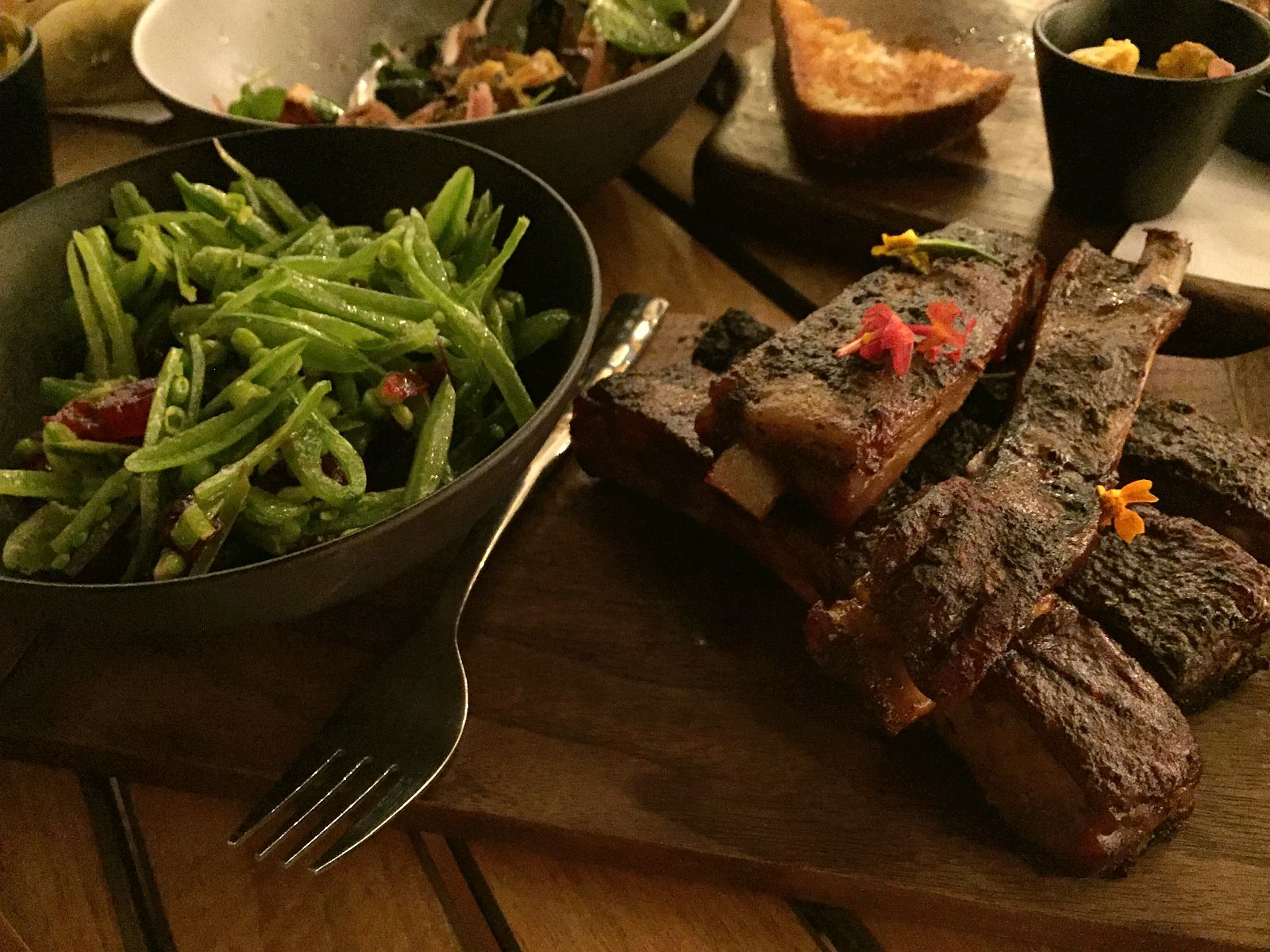
Mowry and Cotton
Newly opened at The Phoenician, Mowry and Cotton takes high-end cuisine and serves it in a comfortable, relaxed atmosphere. With its exposed wood interior, Edison bulbs and mason jar aesthetic, Mowry and Cotton is clearly taking a cue from contemporary dining trends (the bearded waiters in their jeans and cooking aprons would be just at home at many of the restaurants back home in Brooklyn). The menu is a mix of Old West favorites and newer creations, and is attracting new visitors curious to see what all the buzz is about (Chef Tandy Peterson and Mowry & Cotton were recently named one of the three best chefs and restaurants, respectively, by Phoenix Magazine).
We started with the charred brussel sprouts served with bonito and chicory kimchee, and a heaping order of the buttermil buns sprinkled with citrus sea salt butter and glazed with duck fat fig butter. On a tip from the front desk, we followed this up with an order of lamb tacos made with harissa braised lamb and seasoned with pickles and herb quark, as well an order of the smoked spare ribs served with cranberry snap pea slaw and covered in a honey chipotle barbecue sauce. With little room to spare, we finished with the peanut butter bar for dessert, a concoction of soft caramel, mousse, and chocolate croquant.
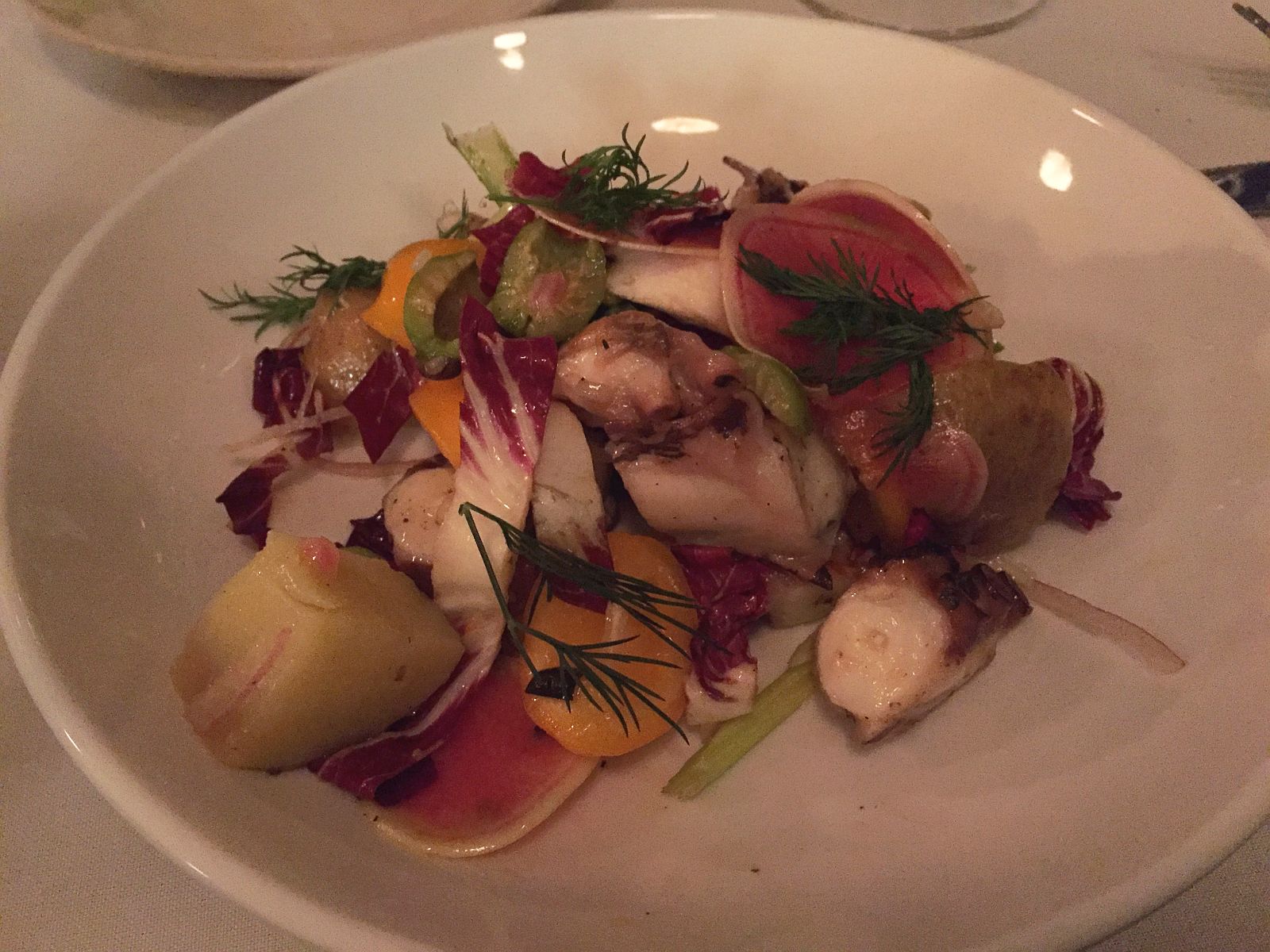
FnB
FnB is fast approaching its 10-year birthday, and this storied restaurant hasn’t let off the gas pedal since opening to acclaim. Located in Old Town, FnB (which stands for Food and Beverage) obsessively focuses on seasonal, local ingredients prepared with the type of care and and attention to detail normally found in much stuffier restaurants. Stuffy FnB is not: diners are seated close to each other in one of three small dining rooms, and decoration is kept to a minimum to avoid distracting you from your meal. The table next to ours struck up a conversation with us when they caught us gawking at one of their dishes — it’s one of those places where everyone is excited to talk to each other about their meals.
On the night we visited, we were served by part-owner Pavle Milic, credited for bringing attention to the Arizona wine scene. Back in the kitchen, co-owner Chef Charleen Badman, a James Beard award semifinalist (affectionately known as the “vegetable whisperer”), was working her magic. We began with the savory peruvian chicken spring rolls, served with pecans and aji amarillo quark, followed by a flavorful beet and chickpea salad. We then opted for the Creekstone Farms ribeye steak served with tepary beans, poblano peppers, roasted tomato and a tomatillo salsa, and a side of brussel sprouts and broccoli. After our third glass of wine and their signature butterscotch pudding served in a highball glass and topped with whipped cream, we were already planning our return visit.

La Hacienda
Located at the Fairmont Scottsdale Princess, La Hacienda is a great high-end take on the traditional Mexican restaurant (which the Greater Phoenix area has plenty of). Boasting a selection of over 200 tequilas and an eclectic take on Mexican favorites from Chef Richard Sandoval (dubbed the Father of Modern Mexican Cuisine), La Hacienda is a reliable favorite. Inside, the restaurant is inspired by traditional Spanish architecture with beehive fireplaces and exposed wood-beam ceilings, and outside you can eat al fresco beneath strings of white lights strewn across the airy patio.
I started my meal off with their signature drink, La Hacienda, made with reposada tequila, cointreau, grand marnier and sour, and an order of chips and guacamole prepared fresh at our table. For starters we had chorizo and potato empanadas covered in tomatillo salsa and crema cotija cheese, and for dinner we shared the costilla de res, braised short ribs served over ancho chile mashed potatoes, baby carrots, herb-heirloom tomato salad, and smothered in a cherry chipotle mole.

Elements
If you’ve spent any time watching the Food Network during the past decade, chances are you’re already familiar with Elements’s Head Chef, Beau MacMillan, the New England transplant who opened Sanctuary back in 2001 and quickly rose to become one of Scottsdale’s most famous chefs. Located at Sanctuary Camelback Mountain Resort, Elements boasts enviable views over Paradise Valley. MacMillan’s menu is Far East meets local Southwest flavors, and features seasonal, local produce, sustainable seafood and hormone-free meat.
If you can, call ahead and reserve a seat out on the balcony overlooking the pool. The quiet, peaceful atmosphere is perfect for devoting your attention to what really matters here: the food. With fond memories of eating them during my last visit, the first thing I ordered as soon as we sat down was their signature shishito peppers, served gooey and a bit sweet. On a recommendation from our knowledgeable waiter, we followed this up with the fiery calamari, a spicy take on the classic dish prepared with a miso scallion vinaigrette. For our dinner we shared our giant portions of chilean seabass, served with a kimchee coconut broth, and the braised short ribs accented with a tangy hoisin sauce. With barely any room left in our stomachs, we couldn’t pass up the deconstructed s’more, a fitting dessert as the air became brisk and the campfire-like heat lamps were turned up.
Elements – Sanctuary Camelback Mountain

/
 Matt Stabile is based in New York City, and is the founder and Editor-in-Chief of The Expeditioner which was founded in 2008. You can read his writings, watch his travel videos or contact him via email at any time at TheExpeditioner.com.
Matt Stabile is based in New York City, and is the founder and Editor-in-Chief of The Expeditioner which was founded in 2008. You can read his writings, watch his travel videos or contact him via email at any time at TheExpeditioner.com.
The post Scottsdale Travel Guide appeared first on The Expeditioner Travel Site.
]]>The post Watch What It’s Like to Visit Japan’s Cat Island appeared first on The Expeditioner Travel Site.
]]>Because one can never get enough of cats on the internet, I present to you a travel video coming from Expeditioner reader Eric Testroete about the island of Tashirojima, Japan, otherwise known as “Cat Island.”
With a population of only about 100 residents, the island is home to six times that number in cats, or for those good at math, 600 cats.
As you can see in the above video, as soon as you step off the ferry, you are greeted by the island’s many furry inhabitants who make this island a popular draw for tourists. And it looks like the residents really play up their cat association: the toilets are outfitted with cat toilet dispensers, the docks are decorated with cat-themed buoys, and you can even stay in a guest house shaped like a cat.
Why so many cats in Tashirojima? It turns out, the island was a hub for silk production during the Edo Period, which meant that rodents were very interested in dining on the silkworms used to produce the silk. So the islanders bred a large population of cats to keep the mice in control, and today you can see their ancestors up close and personal.

/
 Matt Stabile is based in New York City, and is the founder and Editor-in-Chief of The Expeditioner which was founded in 2008. You can read his writings, watch his travel videos or contact him via email at any time at TheExpeditioner.com.
Matt Stabile is based in New York City, and is the founder and Editor-in-Chief of The Expeditioner which was founded in 2008. You can read his writings, watch his travel videos or contact him via email at any time at TheExpeditioner.com.
The post Watch What It’s Like to Visit Japan’s Cat Island appeared first on The Expeditioner Travel Site.
]]>The post Sailing the Greek Islands (Yoga, Hiking and Wine Included) appeared first on The Expeditioner Travel Site.
]]>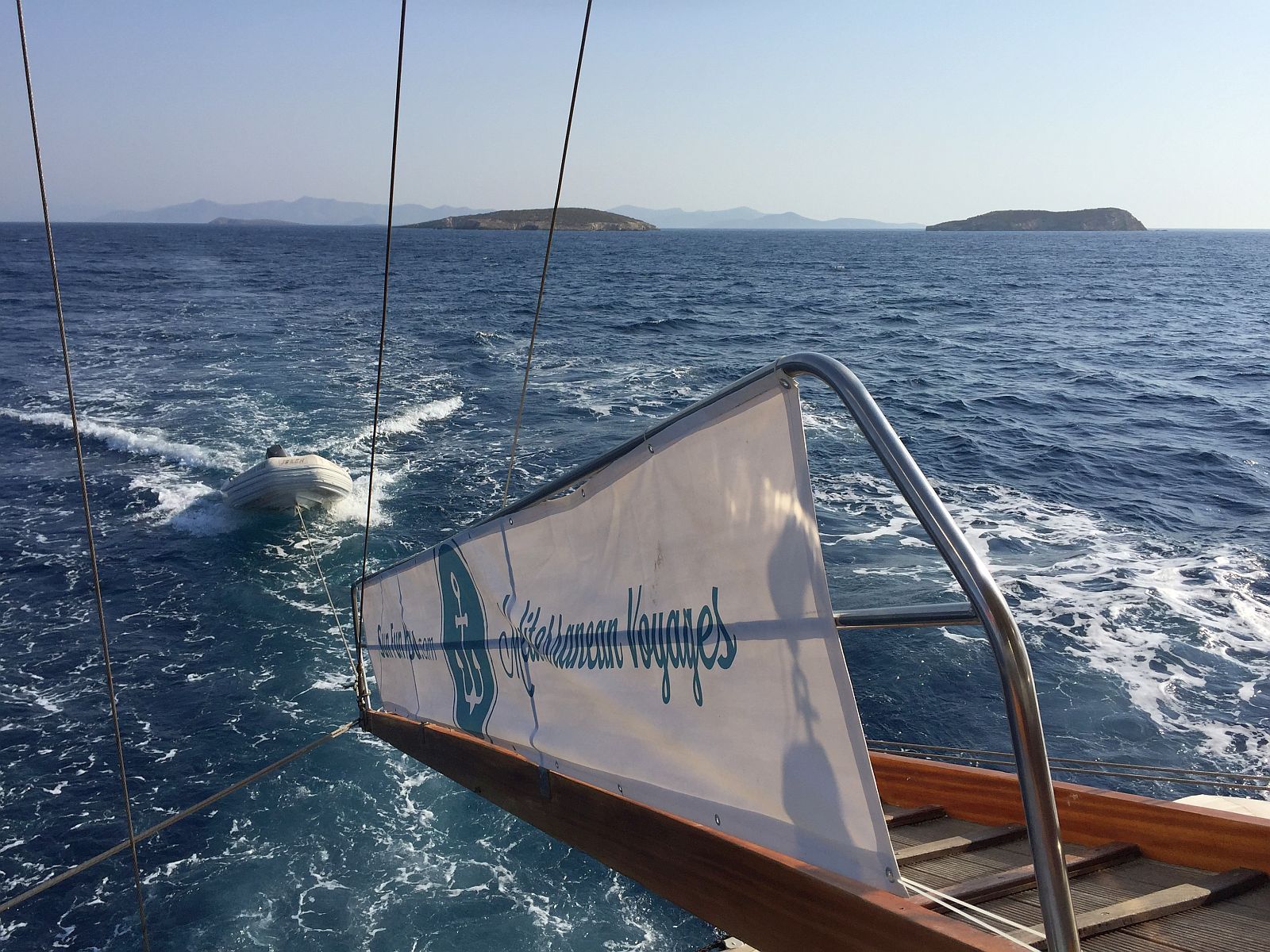
As our boat sailed out of the ancient Greek island harbor of Kos, our group of 10, mostly strangers, sat in a circle around a long, wooden table, studying a map spread out before us depicting the Dodecanese, the group of islands clustered together in the southeastern Aegean Sea. Our tour guide for the trip, Ali, was pointing out the various islands we were to visit over the next week.
“Today will be the longest sail,” he explained in a slow cadence, something we would get used to hearing after breakfast every morning as he announced the forthcoming day’s itinerary. “We are heading north to Patmos. From there we will turn around and visit many islands along the way until we come back to Kos. Of course, we will be doing many hikes and other physical activities along the way.”
My eyes wandered along the names of islands he was pointing to: Pserimos, Kampos, Patmos, Lipsi, Leros, Kalimnos. These were not the names of islands one sees on the cover of glossy brochures luring tourists to the Greek Islands or hears about over holiday dinners from distant relatives when discussing their summer trip.
No, this is officially off-the-beaten-path territory when it comes to the Greek Islands — at least for most tourists. For those who have spent time in the country, partying it up in Mykonos or wandering shoulder-to-shoulder with the crowds through the streets of Santorini, these are the islands one visits to see the other side of Greece. These are the islands where fisherman outnumber tourists on most days, where you’re more likely to run into a stray sheep than a stag party, and where traditions have continued uninterrupted for many millennia. This was the part of Greece I was most excited to see.
After finishing his introduction, Aislyn, our physical trainer for the week, introduced herself. After learning a bit about each of our fitness levels, she then announced that our first workout of the trip would be commencing shortly at the bow of the boat. “Don’t forget to bring your resistance bands that were in your welcome bag when you arrived!”
It goes without saying, this was not going to be your typical Greek island cruise.
It was the middle of September, and we had signed up with Sun Fun You for their active 7-day Greek Islands Voyage trip. The plan was to start from Kos, head north to Patmos, then island-hop south until we arrived back in Kos, sleeping in various coves, ports and docks along the way.
Not one for sitting around idly during my travels (especially on a boat), I was particularly interested in the fact that Sun Fun You places a large emphasis on physical activities. Not only would each day include a morning and afternoon fitness session, but there were also half-day hikes planned for each island we would be visiting. This means rarely a day would go by without some sort of workout to get the juices flowing (and to work off the large amount of feta one tends to consume here).
Our boat for the week, the Muhtesem, was technically a gulet, the term for the two-masted wooden boats typically found in this part of the world. Gulets are known for their ornamental, dark-wood exteriors and long, flat decks. Most are hand-built in nearby Turkey, just as ours was. I later learned our Captain personally oversaw the construction of the particular gulet we were on.
On deck there was a large, flat expanse at the bow where most of the workouts took place, and at the stern was large table used for group meals and which was surrounded by padded seating, perfect for afternoon naps. Below deck were eight cabins with adjoining private bathrooms and a cozy living room/den with a library stocked with Mediterranean-themed books and DVDs (I was inspired to pick up a copy of Zorba the Greek toward the end of the week).
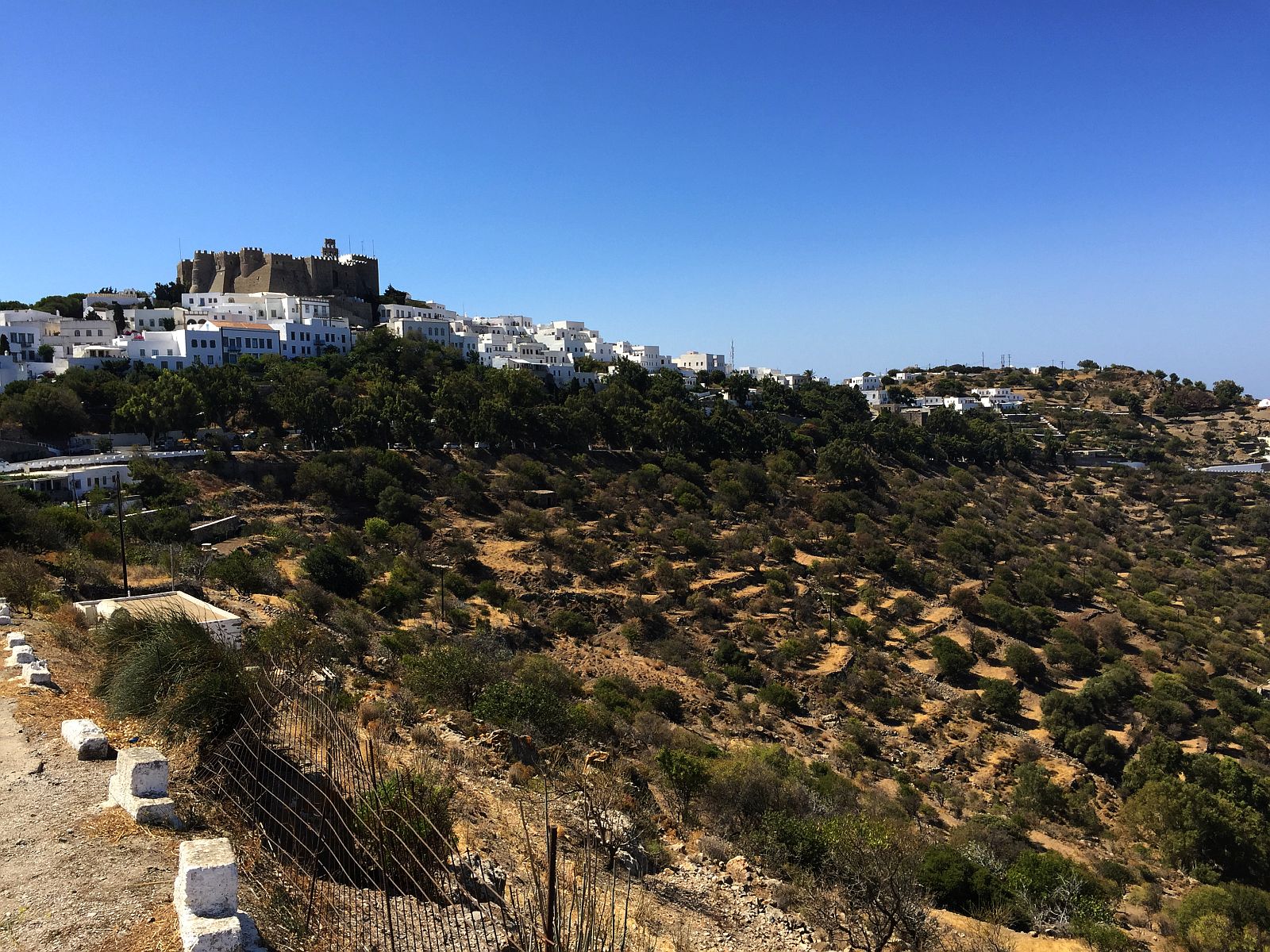
After our first humid night at sea, which resulted in half of the group taking their pillows and blanket outside to sleep, we arrived at our first stop, Patmos. Located on the northern tip of the Dodecanese, the island has a population of less than 3,000 and is well known in the Christian and Greek Orthodox religions as home to the Monastery of Saint John the Divine, the castle-like structure on a hilltop that is a pilgrimage site for many Christians.
After a short walk through the winding backroads of the town of Skala, Ali gathered our group at the base of the hill we would be ascending. “We are going to first visit the Cave of the Apocoloyps, the cave where it is believed John of Patmos — hidden away to avoid the detection of those hunting Christians throughout the region — wrote the Book of Revelation. Then we will head further uphill to the monastery. Please drink lots of water and don’t forget to put on your sunscreen!” Wise words as the early morning sun beat down, baking the parched land surrounding us. Ainslie then led us through a few stretches, and then we were off.
An hour later we arrived at the cave, a welcome respite from the heat due to its location in the side of the hill. After a visit to the austere chapel inside and a short break in the shade, we continued on, heading further uphill until the path ended at a set of large doors belonging to the monastery.
The monastery was initially built in 1088, and with its foreboding walls and numerous turrets, it appears to the naked eye more like a Byzantine castle than a church. Inside, an outdoor courtyard is surrounded by living space and a number of small chapels where the monks used to worship safely far from their prosecutors.
From the courtyard we took one last short walk up a steep staircase to the rooftop where we were treated to a panoramic view of the island below, our boat barely visible in the distance floating in the bay: a speck of brown in a shiny expanse of bright blue.
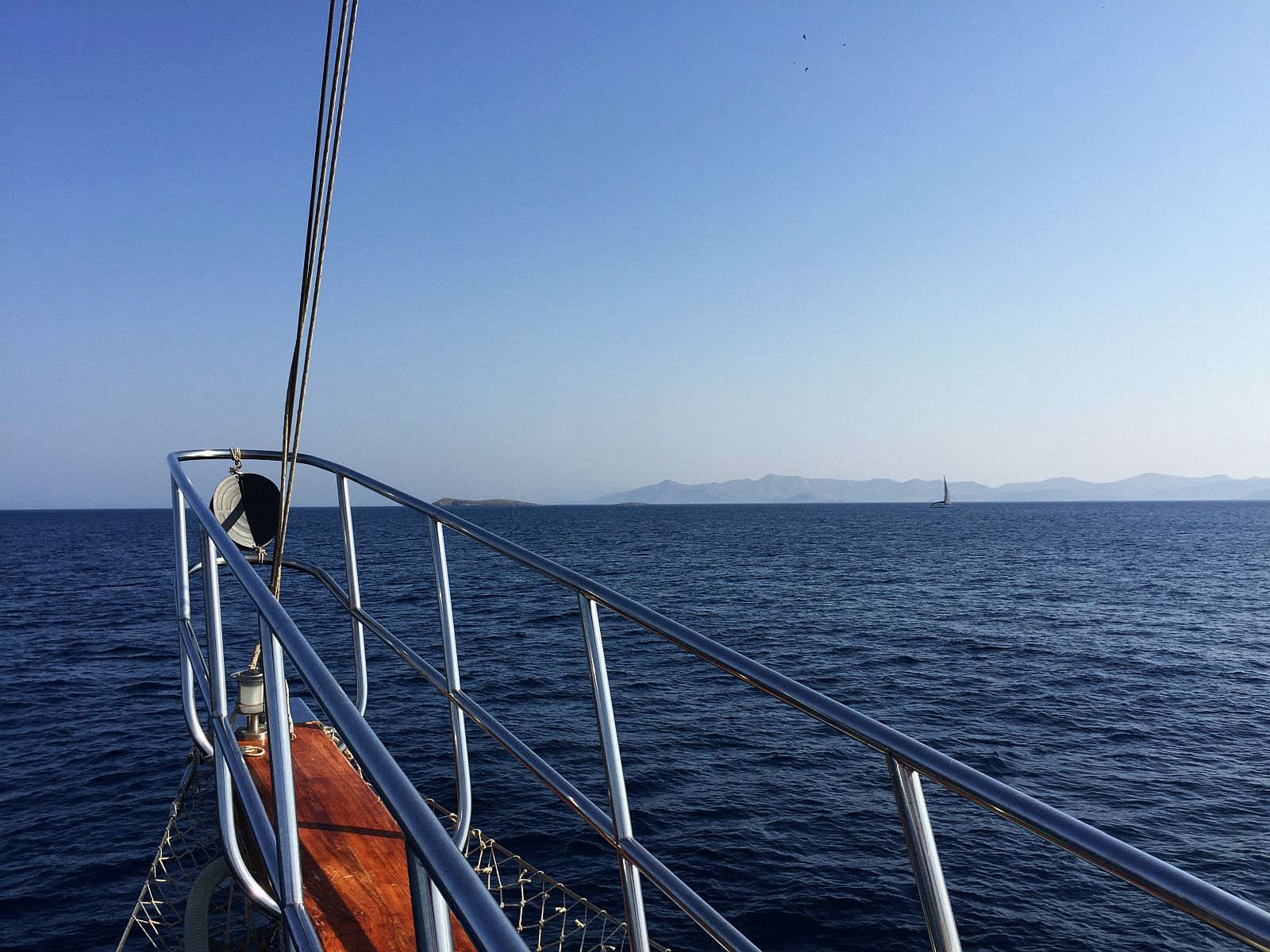
When out on the water, breakfast, lunch and dinner are all eaten family-style. The captain of the ship, with the help of a small crew, does double-duty as chef. Every meal was served with the obligatory Mediterranean accouterments including fresh bread, feta cheese, salad and a selection of olives, followed by our main meal and fresh fruit for dessert. Given the amount of calories each of us were burning each day, the sound of the bell being rung before every meal was usually followed by an ordered stampede of passengers eager to start digging in.
At night, after the table was cleared and drinks were topped off, we would break out a deck of cards, or more frequently, my recently purchased set of Cards Against Humanity, where we would play late into the night under a full set of stars and the sound of waves lapping against the boat’s hull.
One night, after most everyone had gone to sleep, I stayed up late with the boat’s crew drinking cans of Mythos and downing the occasional shot of raki, the anise-flavored liquor popular in this part of the Mediterranean. I asked the captain about the history of the Muhtesem. He explained that he actually owned the boat and helped to oversee its construction which was done using traditional techniques by boat-makers who can trace their trades back generations.
“After many years working as a chef in the kitchens of 5-star hotels, I finally quit my job to pursue my dream,” he explained, his eyes looking around at his prized possession. Later in the trip, I met his young daughter and wife who had come on board to visit, an infrequent event during the summers when he spends most of his time at sea at work in his new profession.
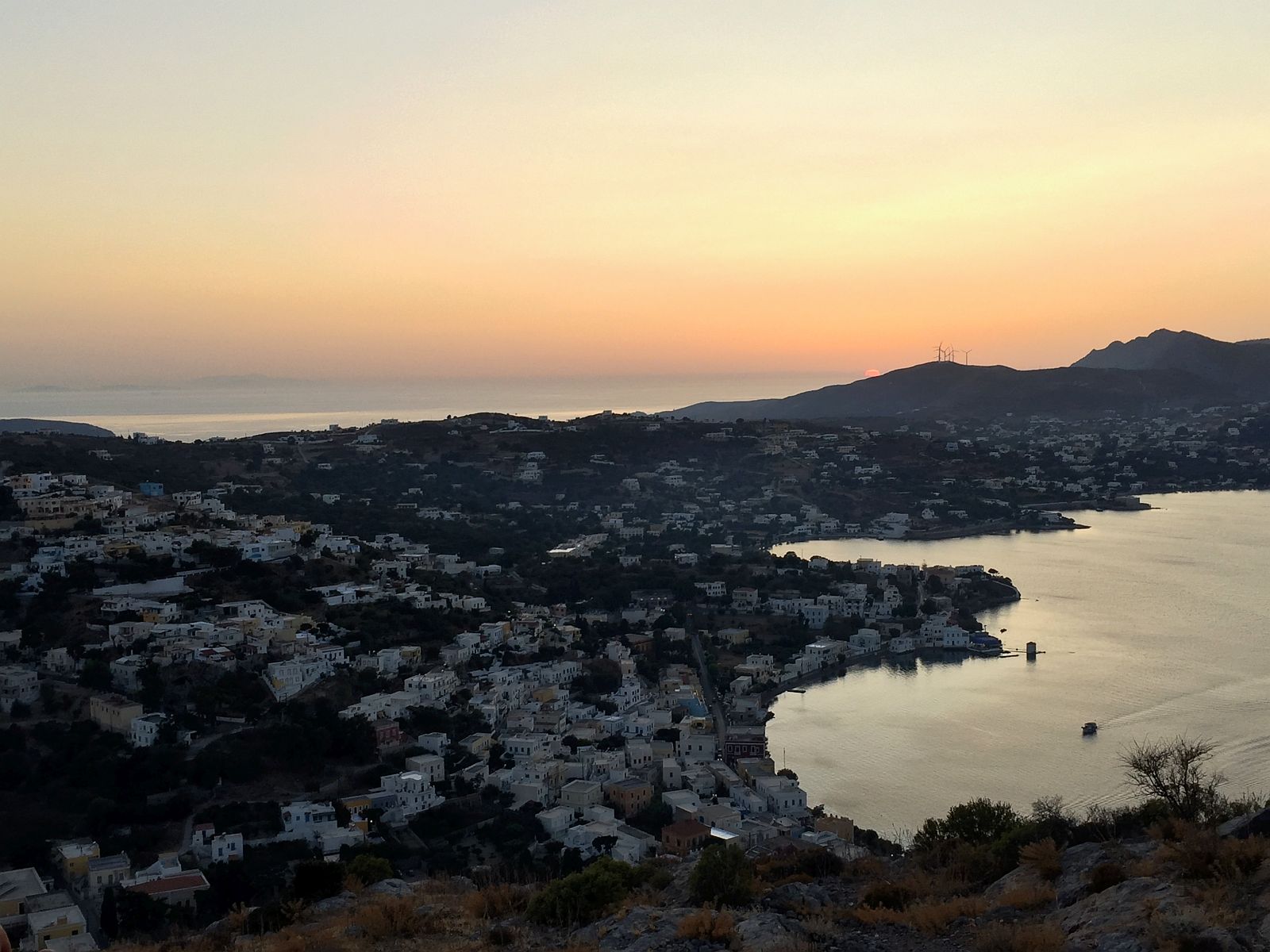
The next day we continued on to the island of Leros where we spent the morning at Aglia Maria Cove swimming, snorkeling along the shallow coastline and enjoying a short break before the sunset hike planned for later in the day. Temperatures for September in this part of Greece hover comfortably around 80 degrees Fahrenheit — a bit warm for sleeping in the cabins, but great for dozing under the stars and swimming. Looking back, I don’t think we saw a single cloud in the sky during the entire week we were there. Clearly, September is an ideal time to visit (we were also told July is a great time to come too; August not so much since it’s the hottest month of the year and uncomfortable during the day for doing much of anything, especially physical activities).
After we finished having fun in the water, we docked in Patneli, an old fishing village home to a small beach and marina, walked along the beach past the coastline cafes and bars, and set out through the windy streets toward the Castle of Pandeli, also known as the Castle of our Lady.
Built in the 10th Century, the castle was donated by the Byzantine Empire to the Monastery of Agios Ioannis Theologos, after which it was taken over by the Knights of Saint John and used to fend off invaders. Today, travelers can visit via an hour-long hike along a switchback road from the town center.
We arrived just in time, and with only minutes to spare before sunset. We quickly rushed around the castle to see the various fortifications that were built over the centuries — obligatory Game of Thrones references were of course made — and then we gathered for our first hilltop sunset in Greece. Known the world over for its sunsets — perhaps most notably for the crowds that gather nightly in Santorini — I can safely report our Leros sunset was just as good, and with the added benefit of having a few thousand fewer people around to share it with. As the sun made its final descent, the small group gathered here on the hilltop began to clap, cheering on the hazy orange and purple light peeking out from the horizon.
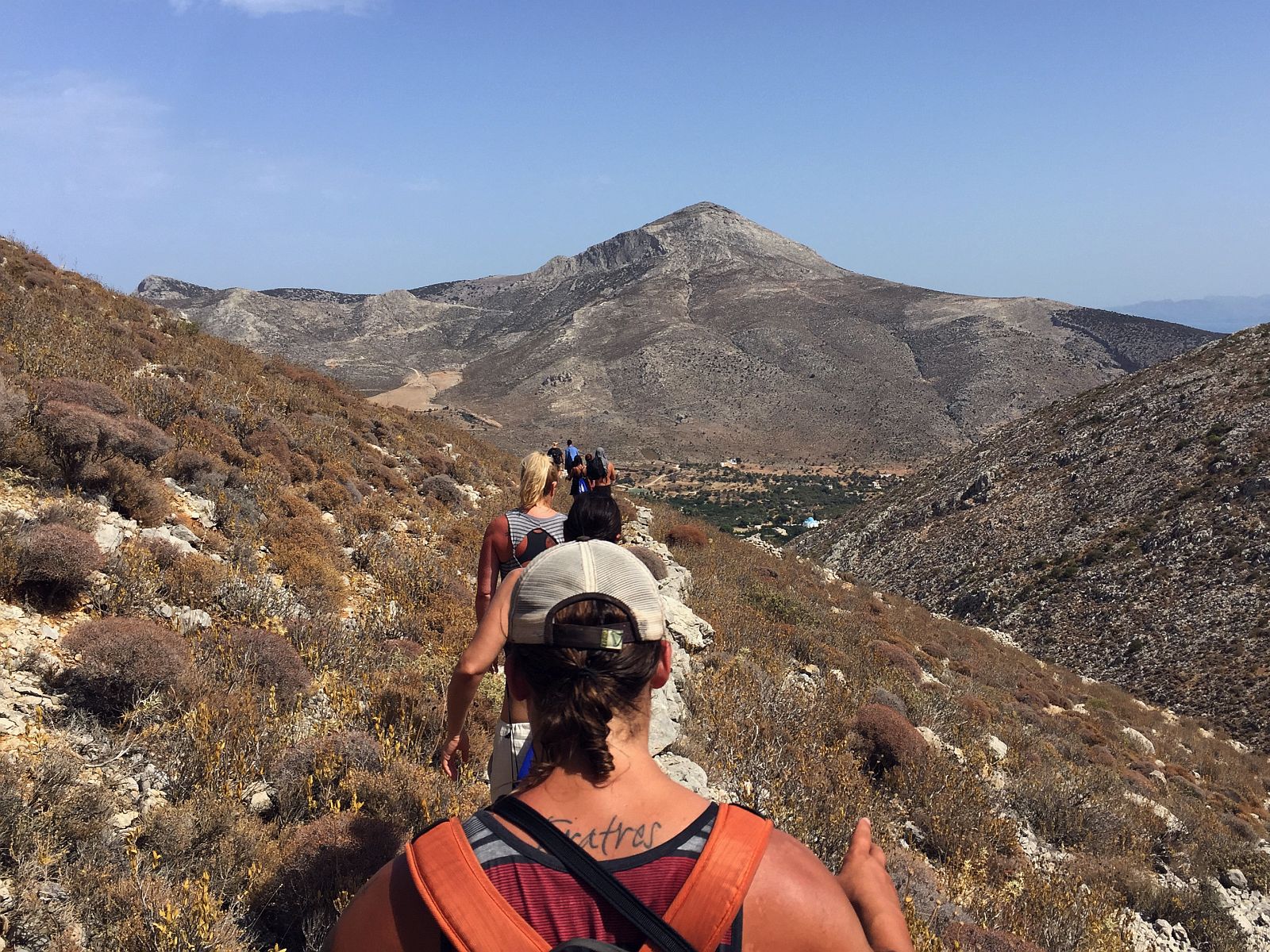
As soon as we pulled into port in Kalymnos, it was clear what the island is known for. All around town were signs heralding the arrival of the Kalymnos Climbing Festival in October, the logo depicting a climber hanging by one hand from the side of a cliff. With its many limestone cliff walls jutting out from the water, and with over 2,500 routes mapped out across the island, Kalymnos is known the world over as one of the best places in the world for sport climbing.
We were not here to climb, but instead to embark on the longest hike of the trip, the Italian Path, a 4-hour trek up and over a large ridge separating the town of Kalimnos from Vathis located on the opposite side of the peninsula. After breakfast, we set out along the marina, making our way past the many small charter boats and wooden crates full of natural sea sponges being peddled by hawkers, a commodity that has been collected and sold here for centuries.
The path’s name comes from the Italians who occupied the island from 1912 up until World War II, and who built the cobbled road to connect the two towns, otherwise inaccessible to each other except by boat. The path winds its way up a narrow hillside, then straightens out and plunges forward until you reach the crest of the ridge, with the southern half of the island splayed out below. With the sun beating down on us and the highest vegetation along the parched path reaching ankle-high, the group settled into a slow crawl forward. For fun (at least for me), I took out my phone and began streaming the theme to Lawrence of Arabia as we marched through the stifling heat.
After reaching the top, the path winds back down into a peaceful valley where olive orchards dot the landscape, then ends abruptly at the end of a long, dusty road. To get to the center of town, you have to continue on for at least another half-hour along a paved street.
Lucky for us, we were able to skip that leg of the hike. Exhausted and tired from our climb, our local guide for the day called a contact of hers, and a few minutes later a flatbed truck with a caged back, presumably for livestock, arrived driven by a large Greek man with a cigarette hanging from his lips. He herded us one-by-one into the back and drove us into town. When we pulled into the main square, the driver opened the back gate and I jumped out, feigning gratitude and kissing the ground, a confusing site for the dozens of tourists eating lunch there.
After our own lunch of grilled squid, a local specialty, we returned back to the boat, changed into our bathing suits, and spent the rest of the afternoon splashing about in the cool, refreshing bay’s water and watching the many climbers scale the cliffs above us, testing their skills in what may be some of the most picturesque climbs in the world.
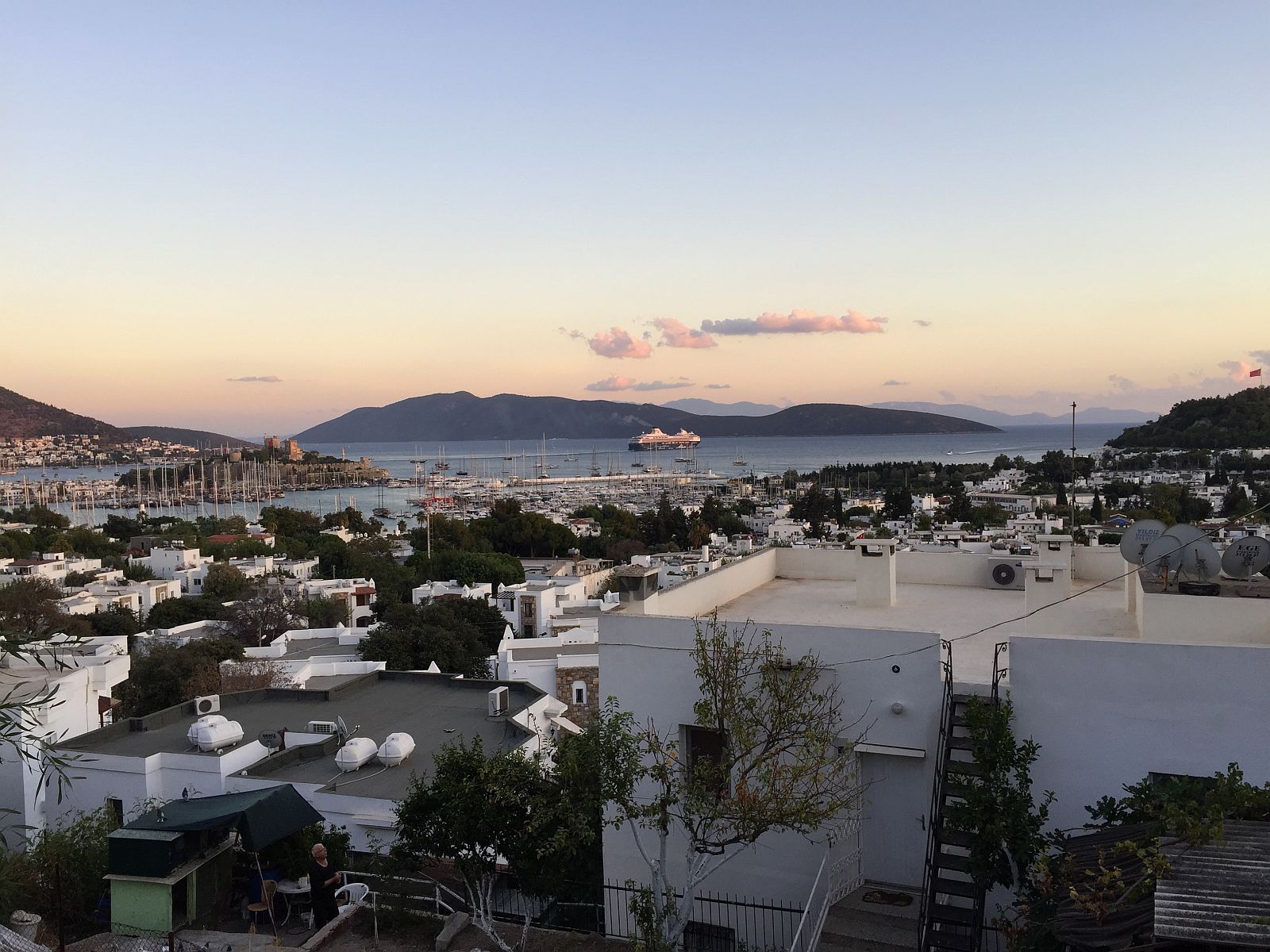
We woke up in the morning to the sound of the boat’s engines firing up. We had spent the muggy night outside on the top deck, falling asleep to the low din of the dockside clubs and to the sight of a night sky impossibly filled with clusters of stars.
Our next-to-last stop before arriving back at Kos was Bodrum, the port city on the Turkish coastline. Located on a peninsula jutting out in the Aegean sea, the town is a well-known vacation hot-spot for both the Turkish and European elite. It was also an Ancient Greek city with a fabled history (it was home to one of the Ancient Wonders of the World, the Mausoleum of Mausolus).
With an afternoon to spare, we decided to visit Bodrum Castle, the city’s most famous attraction. Built in 1402 by the Knights of St John, today the castle is home to the Museum of Underwater Archaeology, a collection of relics that have survived the centuries of invasion, earthquake, fires and human development that has frequented this part of the world since the dawn of civilization. On display in the castle’s many rooms you can find Egyptian jewelry, ancient Greek pottery and assorted coinage all coming from shipwrecks dating back to the 12th Century B.C.
Afterward, we took a stroll through the winding streets of the bazaar in the center of town, then sat at a second-story cafe, sipping apple tea while watching the many visitors in town walking through the marina.
In time for dinner, we met the group back on the boat for one of our last meals on deck. We had plans that evening to head out with everyone for hooka and to check out the many beachside bars. Sitting down around our wood table, Cynthia, the owner of Sun Fun You who had recently joined up with us, told stories with the boat’s crew as we drained the remaining bottle of wine on board.
She talked of the boat’s short history: how proposals had been made, babies conceived, and lifelong friendships created all in the short amount of time the boat had been plying these same waters where others have been voyaging for thousands of year. We lifted our glasses for a final group cheers, one last celebration here on our home away from home, out on the Mediterranean.

/
 Matt Stabile is based in New York City, and is the founder and Editor-in-Chief of The Expeditioner which was founded in 2008. You can read his writings, watch his travel videos or contact him via email at any time at TheExpeditioner.com.
Matt Stabile is based in New York City, and is the founder and Editor-in-Chief of The Expeditioner which was founded in 2008. You can read his writings, watch his travel videos or contact him via email at any time at TheExpeditioner.com.
The post Sailing the Greek Islands (Yoga, Hiking and Wine Included) appeared first on The Expeditioner Travel Site.
]]>The post The Top 50 Travel Blogs (4th Quarter: 2017) appeared first on The Expeditioner Travel Site.
]]>
Below is a list of the top 50 travel blogs for the 4th quarter (October — December) of 2017 ranked by visitor traffic.
There are a few other sites that have put together their own lists of the “top” travel blogs.
However, each has their own subjective means of ranking sites, using everything from Alexa scores, Twitter followers, Facebook likes, estimated traffic, inbound Google links and even subjective design criteria.
My intention was to create the most objective and accurate list of the most popular travel blogs.
Therefore, this list is based solely on the number of visitors a travel blog receives. To read more about how this list was put together, please read below.
I reached out to a large sampling of travel bloggers and asked that they provide me with a screenshot of their Google Analytics page reflecting their site’s visitor statistics over the most recent quarter. The reasoning behind this method was that I wanted to obtain a rolling average to compensate for monthly spikes that may have occurred. Further, utilizing Google Analytics as the uniform measure of traffic helped to ensure uniformity of data across all sampling.
Of course, due to this method of collecting data, only those site owners that submitted their statistics were included for consideration in the rankings. Those that did not submit were not considered. Further, in an effort to maximize the number of participants and to protect specific traffic numbers that some site owners regard as sensitive and private, I agreed to keep all specific data confidential and not include those numbers in the rankings.
Why This Metric?
Simple, it’s the most accurate, best picture of a site’s traffic. As everyone knows, Alexa is not very accurate and can be easily manipulated. Inbound links are a great sign of SEO, but just because a site does well with Google doesn’t mean it has a lot of visitors. Twitter followers are great, but that doesn’t necessarily translate into site readers.
Quite simply, unique visitors is the one metric that most accurately reflects a site’s readership.
Who Cares?
I understand that just because a site gets a high number of unique visitors doesn’t mean it’s the highest quality site. There are plenty of excellently written, well-designed, engaging sites that may not have high traffic numbers.
My intention was not to create a list of the best, or the most useful, or the most professional travel blogs. I simply wanted to create the most accurate list of the most visited blogs. Just as the movie weekend box office results are reported every week, I simply wanted to create an unbiased, objective list of the most visited travel blogs for research purposes.
Finally, I hope this list will serve as a useful guide and a good starting point for travelers and readers around the world looking to explore the vibrant and eclectic travel blogging community, and expose them to some great travel blogs that they otherwise may not be reading.
*
Click Here to Read the Complete Past Lists of The Top 50 Travel Blogs

/
 Matt Stabile is the Founder and Editor-in-Chief of The Expeditioner. The Expeditioner began in 2008 and is headquartered in New York City. You can read his writings, watch his travel videos or contact him at any time at TheExpeditioner.com.
Matt Stabile is the Founder and Editor-in-Chief of The Expeditioner. The Expeditioner began in 2008 and is headquartered in New York City. You can read his writings, watch his travel videos or contact him at any time at TheExpeditioner.com.
The post The Top 50 Travel Blogs (4th Quarter: 2017) appeared first on The Expeditioner Travel Site.
]]>The post My Pick For The Perfect Travel Holiday Present appeared first on The Expeditioner Travel Site.
]]>
It’s that time of year where we all struggle with the challenge of buying holiday gifts for those who love to travel. What to buy? Airplane tickets (yes, please)? Memorable experiences (easier said than done)? Travel-size toiletries (practical, but not really what we’re going for here)?
That’s why I decided to highlight one of my favorite travel apparel companies, Bluffworks, whose travel blazers, pants, shorts and shirts are not only useful for travel lovers in your life, but also make quality, memorable gifts (my shipping address can be provided to those interested). Everything is wrinkle resistant, quick drying, breathable and includes hidden pockets, perfect for travel all around.
Right now Bluffworks is running a massive, 30% off Black Friday sale for all of their travel apparel that will be running through Black Friday and until Cyber Monday (November 27). You don’t even have to enter a coupon code, just head to the site and shop.
Blazers

Click here to explore the Bluffworks blazers.
Pants
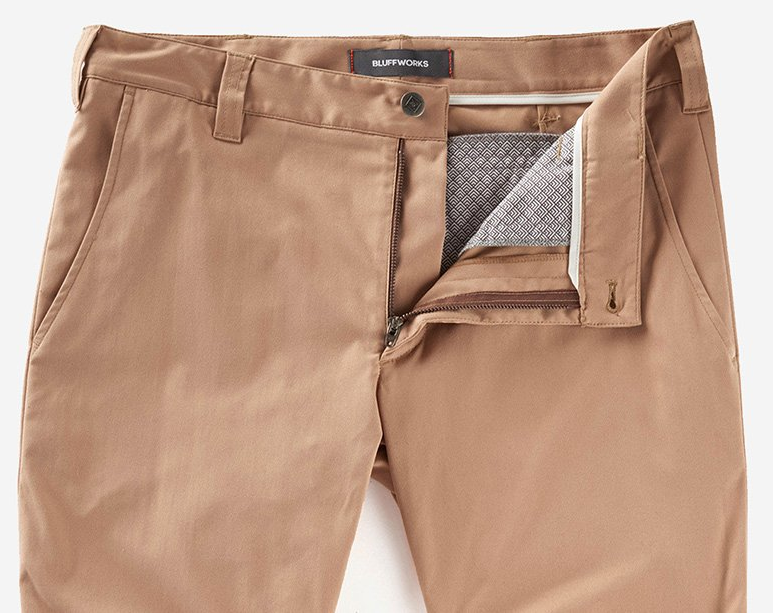
Click here to explore the Bluffworks pants collection.
Shirts

Click here to explore the Bluffworks shirt collection.
Shorts
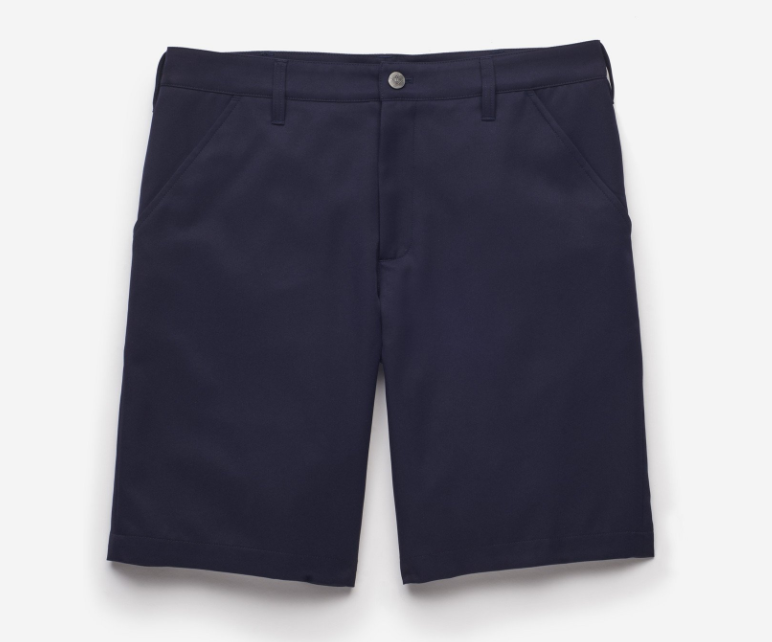
Click here to explore the Bluffworks shorts collection.
It’s hard to imagine, but if this doesn’t satisfy the travel lover in your life, then plane ticket it is. Remember, you can never go wrong choosing first class to really impress that special someone.

/
 Matt Stabile is based in New York City, and is the founder and Editor-in-Chief of The Expeditioner which was founded in 2008. You can read his writings, watch his travel videos or contact him via email at any time at TheExpeditioner.com.
Matt Stabile is based in New York City, and is the founder and Editor-in-Chief of The Expeditioner which was founded in 2008. You can read his writings, watch his travel videos or contact him via email at any time at TheExpeditioner.com.
The post My Pick For The Perfect Travel Holiday Present appeared first on The Expeditioner Travel Site.
]]>The post Into The Great, Wide Open: The Ultimate Alaskan Fishing Trip appeared first on The Expeditioner Travel Site.
]]>
Through the windshield, I watched the de Havilland’s front propellor spin furiously as our small 8-person prop plane hurtled forward through the Alaskan sky. It was a bright, clear morning, and below us I could make out the outlines of a few of the small islands that make up the Alexander Archipelago.
Looming in front of us was one of the island chain’s biggest island, Prince of Wales Island, home to a smattering of Native American villages, remote logging outposts, more black bears than there are humans, and a former salmon cannery now turned Alaska’s premier fishing resort, Waterfall Resort Alaska, my home for the next four days. Here I would be fishing, an activity I had once sworn off back in my teenage years, an era of my life when the thought of long stretches of time spent doing nothing surrounded by nature would have been considered torture. Lucky for me, my outlook on life had since changed.
“Welcome to Waterfall Resort,” a staff member said, greeting us after our plane landed and motored to the dock. “Your bags are being brought to your rooms directly. Please head to the cannery at the top of the ramp to pick up your slickers so we can get you out on the water as soon as possible!”
And with that we were ushered into a room crammed from floor to ceiling with rows of yellow slickers where we were fitted with gear that would be ours for the duration of our stay. As I stepped into a pair of galoshes and pulled on a pair of the oversized, yellow pants with over-the-shoulder suspenders, I wondered if I would evoke the image of the classic sailor that graced the front of the Gorton’s Fish Sticks boxes I used to love as a kid. As I pulled the suspenders over my head, I realized I had put the pants on backwards, resulting in the crossed suspenders nearly choking me. A staff member rushed to my aid and helped me to put on the pants properly. Needless to say, grizzled fisherman I was not.
News to me upon arriving, a good portion of Alaska — that section referred to as Southeast Alaska — is actually made up of about 1,100 islands that span a 300-mile stretch of coastline bordering British Columbia to its east, an embarrassing admission to make for someone that prides himself on his sense of direction and knowledge of world geography. Due to the island’s many freshwater lakes and streams that feed into the protected island channels — and therefore prime spawning locations — it is here where sport fishermen from around the world flock for some of the best salmon fishing in the world.

A half-hour later, myself and three other fishermen, along with our assigned fishing captain, Captain Mitch, were floating alongside the shores of Baker Island, dropping our lines into the cool Pacific water, hoping to attract the attention of a school of silver salmon grouped below us.
I learned alot about Captain Mitch over the next few days — let’s just say fishing far from any cell towers lends one to share many life stories. I learned Captain Mitch was a retired aviation mechanic who used to work at the Boeing headquarters in Seattle, that Captain Mitch, since retirement, has been asking his wife permission to lead boating expeditions here at Waterfall and that she’s said “yes” for the past 20 years, that Captain Mitch drinks black coffee in the morning, eats fried chicken for lunch, and Skypes with his wife every night before going to sleep around 8 p.m., and that Captain Mitch’s mascot is Papa Smurf, a nickname given to him due to his grey beard, less-than-wirey stature, and the fact that he’s the captain of the entire fleet. As a present, the staff gave him a small Papa Smurf doll that now dutifully hangs above the steering wheel. We were in good hands.
“Drop to 50 feet and reel up!” Captain Mitch instructed with the conviction of a man clearly experienced in minimizing the time needed to start catching fish.
I did as I was told, and just a few drops later, I felt a tug, followed by a hard pull on the end of my line as the fish worked to free himself free of my hook.
“Work the line up, lifting and reeling at the same time, then dropping your tip down back to the water!” Captain Mitch advised, clearly observing the ineptitude I was displaying after the bite.
As I reeled in, the adrenaline hit me, and I could feel the envious eyes of the others on me. Pulling the end of the line close to the beginning of the reel, an 8-pound coho salmon (more commonly referred to as a silver salmon) suddenly appeared thrashing on the water surface. Captain Mitch told me to guide it to the boat’s edge, where in one quick motion he leaned over, grabbed the line, pulled the fish into the air, and whacked it on the head with the back of his gaff, stunning it temporarily, then hooking it and pulling it into the boat. My first catch of the trip.

And with that, I began to “get it.” Simpler than any cliched Hemingway-esque metaphor between man and beast, I experienced the pure sport of fishing, and the excitement that comes with wresting a large fish from the depths of the water with only a thin pole and a bit of bait, a surprising feeling for someone that abhors the thought of hunting land animals.
Captain Mitch flung my trophy into the large cooler in the center of the deck and re-baited my line. The others had quickly gone back to dropping and reeling in their own lines in search of the next catch. We had several hours of daylight left in the day, and little time to dwell on my first catch.
Mornings start early out on the water. The next day, having woken, showered, and eaten a quick breakfast, we were leading the way out of the docks at 6:30 a.m. sharp, the Alaskan early morning sun already high above the horizon after emerging more than an hour earlier. This morning we were heading 1 ½ hours south to the open expanse at the tip of Dall Island where the nutrient-rich, cold waters of the ocean meet the warmer waters of the archipelago’s many inlets. Here we were in search of the prized halibut.
For those like myself who, prior to this trip, wouldn’t have been able to describe the difference in shape and size between a halibut and a salmon, the halibut is a flat-faced, diamond-shaped bottom feeder with a complexion matching that of army camouflage. They are also hard to find, one of the tastiest fish to eat, and notorious for putting up some of the hardest battles with fishermen in the sea.

After motoring to a spot Captain Mitch favored, we dropped our lines down 100 feet to the ocean floor and quickly located a school. Minutes later I had a bite. Rather than the side-to-side thrashing I had experienced with the salmon the day before, when the halibut bit, I felt an initial tug, then an immediate yank downward as the fish seemed to flatten out in protest, using the principles of water displacement to its advantage.
In reality, halibut just grow to be really huge. Several fisherman during my time there caught ones weighing over 100 pounds, and record-setting catches often exceed 300 pounds (the weight limit currently stands at 300 pounds, which means those truly large catches are thrown back in the water with the assurance they will end their life due to natural circumstances courtesy of the Alaska Department of Fish and Game).
My first and only halibut of the day put up a hard fight, my forearms throbbing by the time I pulled it up after 15 minutes of constant reeling and pulling. As Captain Mitch yanked it aboard, I was intrigued by its alien-like bulbous eyes situated unevenly on its head — apparently there’s not much to look at on the seafloor — and its scaly, green body, nothing like I imagined it would look like having eaten plenty of the delectable white fillets at respectable restaurants throughout my life.
Current limits set the daily haul at one halibut per fisherman per day. After we all successfully caught one each, we headed back to shallower water where we were able to whittle away the rest of the morning and early afternoon until we caught our boat maximum of 24 salmon (6 each per day), leaving plenty of time to motor back to the resort with enough daylight left in the day for me to finally explore its grounds.

Shortly after lunch, I was on my way to start exploring the resort when I was stopped by an excited member of one of the other boats.
“If you go now, you may still see the bear!” he said, pointing backward in the direction of the hill where the dining hall was located.
Not one to miss out on wildlife sightings, especially those involving animals that could potentially eat me at their whim, I hightailed it forward. Unfortunately for me — though fortunate for perhaps my physical health — said spotted black bear was nowhere to be found, replaced instead by a disinterested fawn grazing on a patch of grass.
I snapped a picture with my phone and continued on. At the top of the hill I took stock of the resort below me. Waterfall can date its history back to when the Waterfall Cannery was founded in 1911. Over the years, as it grew, the cannery added housing units for the workers (now cabins used for the guests), along with massive wooden structures to house the cannery itself. At its peak, the cannery produced 220,000 cases of silver salmon. Today, the complex has been converted into the state’s largest sport fishing resort (it’s also home to the state’s largest private boat fleet), welcoming over 2,000 guests a year.
The bulk of the 52-acre property is undeveloped forest, part of the Tongass National Forest, where the dense growth and mossy underbrush makes it hard to explore by foot. For that reason, an elevated wood bridge was built to allow visitors to explore inland to the namesake waterfall where the resort gets its name.
After a short walk along the beach, then onto said bridge for a half-hour trip inland, I finally emerged at a clearing in the forest that revealed the massive, multi-story-high waterfall. Fed by a slow-moving stream above, I lost track of time as I listened to the sound of the falling water and watched the hypnotic show the water produced as it trickled its way down.
The pool of water at the base of the waterfall is the final stop for many salmon who are born here, and who end up returning to die here after an arduous trip upstream to finally spawn at the very spot where they started their lives. Naturally, the bears know this, and on most days you can spot groups of bears and cubs as they congregate below in search of an easy meal. Today, however, there were no bears, only a sole brave photographer standing knee-deep in water, shooting the falls from below.
Returning back to camp, I headed to dinner at the dining hall. The tables are grouped by boat members and the day’s biggest catches by fish are announced at the end of the meal, with winners awarded commemorative hats (and patches for those with catches exceeding certain limits). Following dinner, as per ritual, most everyone retreats to the Lagoon Saloon, Waterfall’s sole drinking establishment where both guests and workers can congregate over local Alaskan brews and share fish stories from the day.

Late the next morning, after another successful haul of silvers that saw us creeping near our day’s limit by lunchtime, the blue sky that had blessed us since our arrival began to give way to a thin, grey overcast. Word around camp was that we had some “weather” rolling in, with rain and wind predicted to pick up considerably just in time for our departure.
“What happens if the weather is bad enough the planes can’t fly us out tomorrow?” I asked Captain Mitch.
“If they can’t fly, then we boat you out,” he replied, not looking up as he looped a fresh piece of bait onto a hook. “And if we can’t boat you out, you get to stay another day. But that’s only happened a couple times since I’ve been here, and I’ve been working here for over 20 years.” He paused, for dramatic effect. “Trust me, you’ll make your flights tomorrow.”
His response clearly indicated that the logistics surrounding the departure of close to a hundred people and their respective boxes of fish would revolve around the question of “how” rather than “if”; either we were leaving by plane or we were leaving by fishing boat flotilla, piloted by a fleet of captains who had spent their fair share amount of time navigating in disagreeable conditions.
“I’ve got one more spot I wanted to show you guys,” Captain Mitch informed us as we pulled up our lines. “Are you up for a bit of driving?”
A half hour later we were motoring out in the direction of the open ocean, the island masses spread out behind us. We veered north, skating around the pointy cape at the southernmost tip of Baker Island, then steered toward land, finally coming to a stop in a quiet cove surrounded by towering cliffs.
“Allright, I’ve gotten reports that the halibut are biting here. Let’s drop down 150 feet and see if we can catch our limit for the trip. I’ve also heard we may have other visitors around here.”
Visitors? I assumed he meant other fishermen eager to get in on our prime halibut spot. Minutes later after dropping our lines, we discovered what he meant.
Off the starboard side of the boat, halfway between our tiny vessel and the nearby coast, we heard a tremendous exhale, followed by the release of a massive spray of water blowing into the sky. Suddenly, the black head of a humpback whale breached the surface of the water, its gigantic body following behind in a tremendous arc, finishing with its fluke sweeping upwards towards the sky before its entire body dove back down below.
By this point most of us had little use for fishing rods, and we had lunged for our cameras that we were now clicking away with. For the next half hour, as we floated in place and took shot after shot, we were treated to a show as two other humpbacks joined in and fed in our little cove. Circles of bubbles would appear from below — the whales do this to cause fish to congregate for easier hunting — followed by breach after breach of the whales as they scooped up schools of tiny fish in their mouths.
After a short while, the whales began to finish hunting and swam away into the ocean. By this time the sky had turned a dark grey, the temperature had dropped precipitously and a cold rain had begun to fall. We broke out the yellow slickers that we had little use for the days before. We packed up our gear for the day, and took stock of our catch.
In total, our boat had caught over 50 silver salmon, 8 halibut, and a several pink salmons, rockfish and lingcods. Incredibly, this meant we would each be flying home with over 50 pounds of fish the next day via insulated luggage containers (each night our daily catch was cleaned, vacuum sealed and marked for eventual shipping home with us). Though unusual for mementos, I couldn’t think of anything better I would’ve wanted to take home with me to remember this ultimate fishing trip in Alaska.

/
 Matt Stabile is based in New York City, and is the founder and Editor-in-Chief of The Expeditioner which was founded in 2008. You can read his writings, watch his travel videos or contact him via email at any time at TheExpeditioner.com.
Matt Stabile is based in New York City, and is the founder and Editor-in-Chief of The Expeditioner which was founded in 2008. You can read his writings, watch his travel videos or contact him via email at any time at TheExpeditioner.com.
The post Into The Great, Wide Open: The Ultimate Alaskan Fishing Trip appeared first on The Expeditioner Travel Site.
]]>The post The Top 50 Travel Blogs (3rd Quarter: 2017) appeared first on The Expeditioner Travel Site.
]]>
Below is a list of the top 50 travel blogs for the 3rd quarter (July — September) of 2017 ranked by visitor traffic.
There are a few other sites that have put together their own lists of the “top” travel blogs.
However, each has their own subjective means of ranking sites, using everything from Alexa scores, Twitter followers, Facebook likes, estimated traffic, inbound Google links and even subjective design criteria.
My intention was to create the most objective and accurate list of the most popular travel blogs.
Therefore, this list is based solely on the number of visitors a travel blog receives. To read more about how this list was put together, please read below.
I reached out to a large sampling of travel bloggers and asked that they provide me with a screenshot of their Google Analytics page reflecting their site’s visitor statistics over the most recent quarter. The reasoning behind this method was that I wanted to obtain a rolling average to compensate for monthly spikes that may have occurred. Further, utilizing Google Analytics as the uniform measure of traffic helped to ensure uniformity of data across all sampling.
Of course, due to this method of collecting data, only those site owners that submitted their statistics were included for consideration in the rankings. Those that did not submit were not considered. Further, in an effort to maximize the number of participants and to protect specific traffic numbers that some site owners regard as sensitive and private, I agreed to keep all specific data confidential and not include those numbers in the rankings.
Why This Metric?
Simple, it’s the most accurate, best picture of a site’s traffic. As everyone knows, Alexa is not very accurate and can be easily manipulated. Inbound links are a great sign of SEO, but just because a site does well with Google doesn’t mean it has a lot of visitors. Twitter followers are great, but that doesn’t necessarily translate into site readers.
Quite simply, unique visitors is the one metric that most accurately reflects a site’s readership.
Who Cares?
I understand that just because a site gets a high number of unique visitors doesn’t mean it’s the highest quality site. There are plenty of excellently written, well-designed, engaging sites that may not have high traffic numbers.
My intention was not to create a list of the best, or the most useful, or the most professional travel blogs. I simply wanted to create the most accurate list of the most visited blogs. Just as the movie weekend box office results are reported every week, I simply wanted to create an unbiased, objective list of the most visited travel blogs for research purposes.
Finally, I hope this list will serve as a useful guide and a good starting point for travelers and readers around the world looking to explore the vibrant and eclectic travel blogging community, and expose them to some great travel blogs that they otherwise may not be reading.
*
Click Here to Read the Complete Past Lists of The Top 50 Travel Blogs

/
 Matt Stabile is the Founder and Editor-in-Chief of The Expeditioner. The Expeditioner began in 2008 and is headquartered in New York City. You can read his writings, watch his travel videos or contact him at any time at TheExpeditioner.com.
Matt Stabile is the Founder and Editor-in-Chief of The Expeditioner. The Expeditioner began in 2008 and is headquartered in New York City. You can read his writings, watch his travel videos or contact him at any time at TheExpeditioner.com.
The post The Top 50 Travel Blogs (3rd Quarter: 2017) appeared first on The Expeditioner Travel Site.
]]>The post Wine, Sun And Seals: A Highway 1 Road Trip appeared first on The Expeditioner Travel Site.
]]>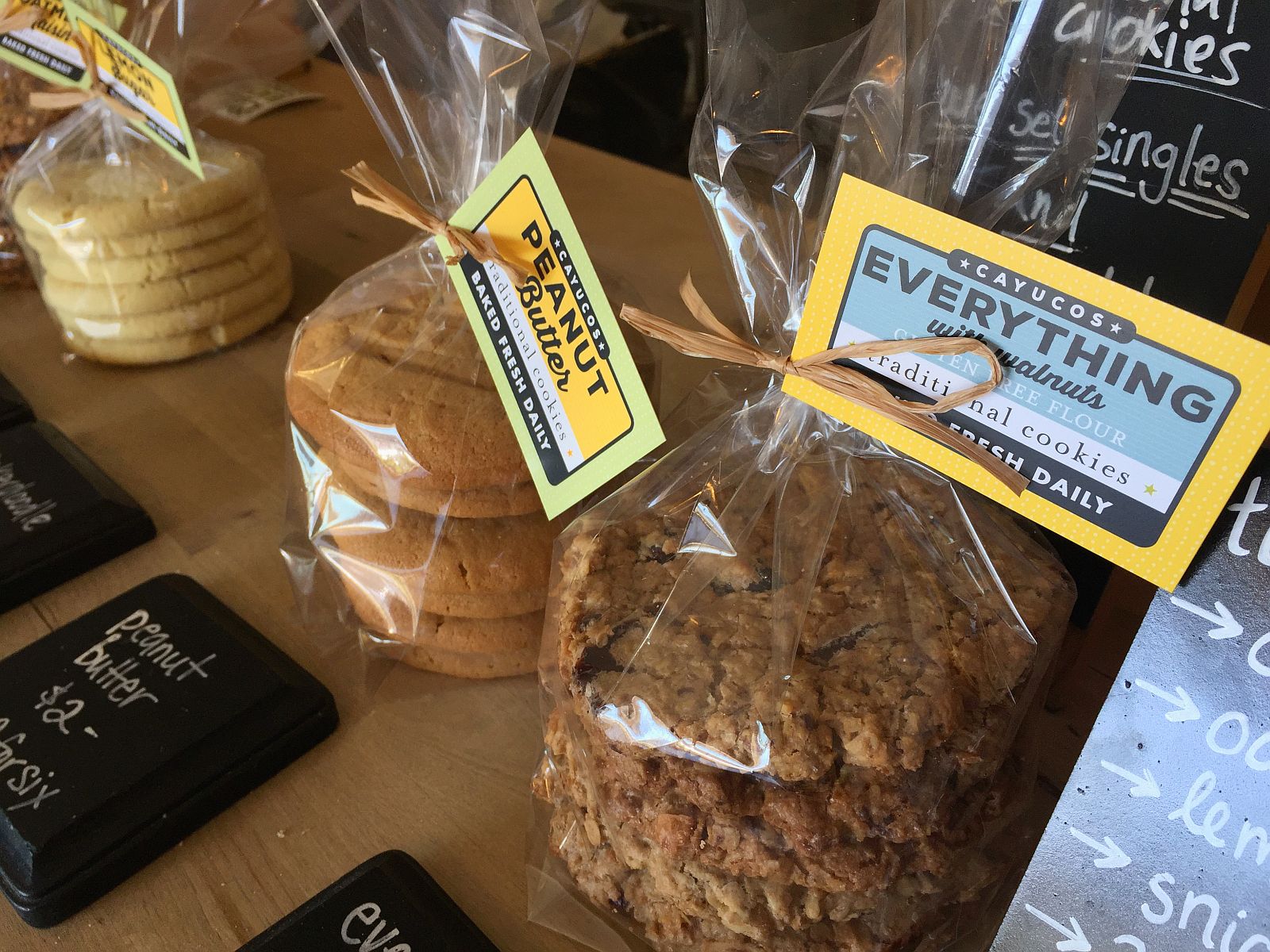
Is there any more iconic way to explore California than to travel by car along the coastline, taking in views of the Pacific as you cruise at your leisure, stopping where you want and exploring all that the state has to offer? This was our goal when we set off on the Highway 1 Discovery Route heading north in search of what makes this region so unique.
Our aim was to hop on Highway 1 after a short stay in Morro Bay and head as far north as we had time for, before circling back to go home. This stunning stretch of the highway hugs the coastline, winding its way along rocky outcrops and long stretches of unoccupied beaches. Oh to have had a surfboard with me, and more importantly, knew how to surf properly, I’m not sure we would have made it much farther.
The first town we visited was Cayucos. With its low-key vibe, small bungalows looking out over the beach and main street populated by mom-and-pop shops, the town hints at what many of these communities along the California coast looked like long before development.
Our goal for the short stop was the famous Brown Butter Cookie Company. Known all over the region (and the country), this sister-owned cookie company is a working factory with its cookie makers busy assembling the confections in the middle of the shop for all to watch who wander in. We picked up a multi-pack sampler that included bourbon, sea salt and cinnamon flavors, and jumped back in the car.
An hour later we pulled into the town of Cambria, the popular seaside village known for its great ocean views, as well as its close proximity to the area’s most famous attraction, Hearst Castle. We checked in at Blue Dolphin Inn, a newly renovated motel now made into a fashionable inn, complete with six specialty themed suites based upon locations in the world where dolphins are found. The expansive Moonstone Beach and the town’s boardwalk sit directly across the street, and if you’re okay with leaving the windows open, you can enjoy the sound of the ocean as you sleep (mixed in with the sound of occasional passing traffic).
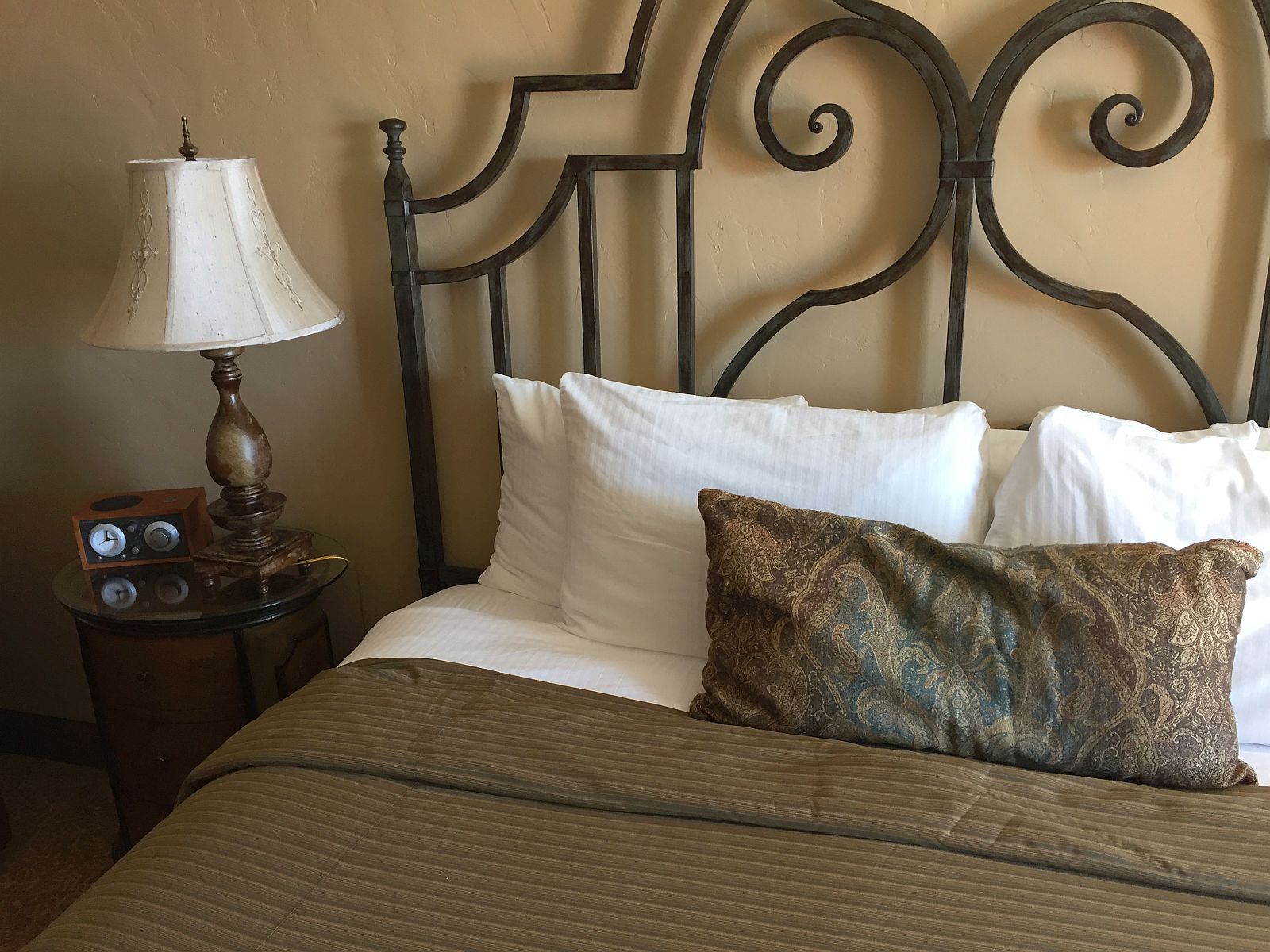
The main part of town is found inland away from the coast, home to a number of restaurants and shops for visitors. We decided on Robin’s Restaurant, a well-known eatery that’s held court for over a quarter of a century. Starting off in a health food store, Robin’s grew in popularity and owners Robin Covey and Shanny Covey soon moved into an adobe house where the restaurant is today.

Sitting outside on their canopied back deck, we ordered the Vietnamese spring rolls, followed by the prawn enchiladas and one of their signature curry dishes, Robin’s Chow, a stir fry featuring fresh vegetables. Following a tip given by Mandy, our kayak guide from the day before, we finished the night with drinks at Centrally Grown, a bar and grill that offers sweeping views of the ocean from its hilltop perch, as well as weekly live music outside.
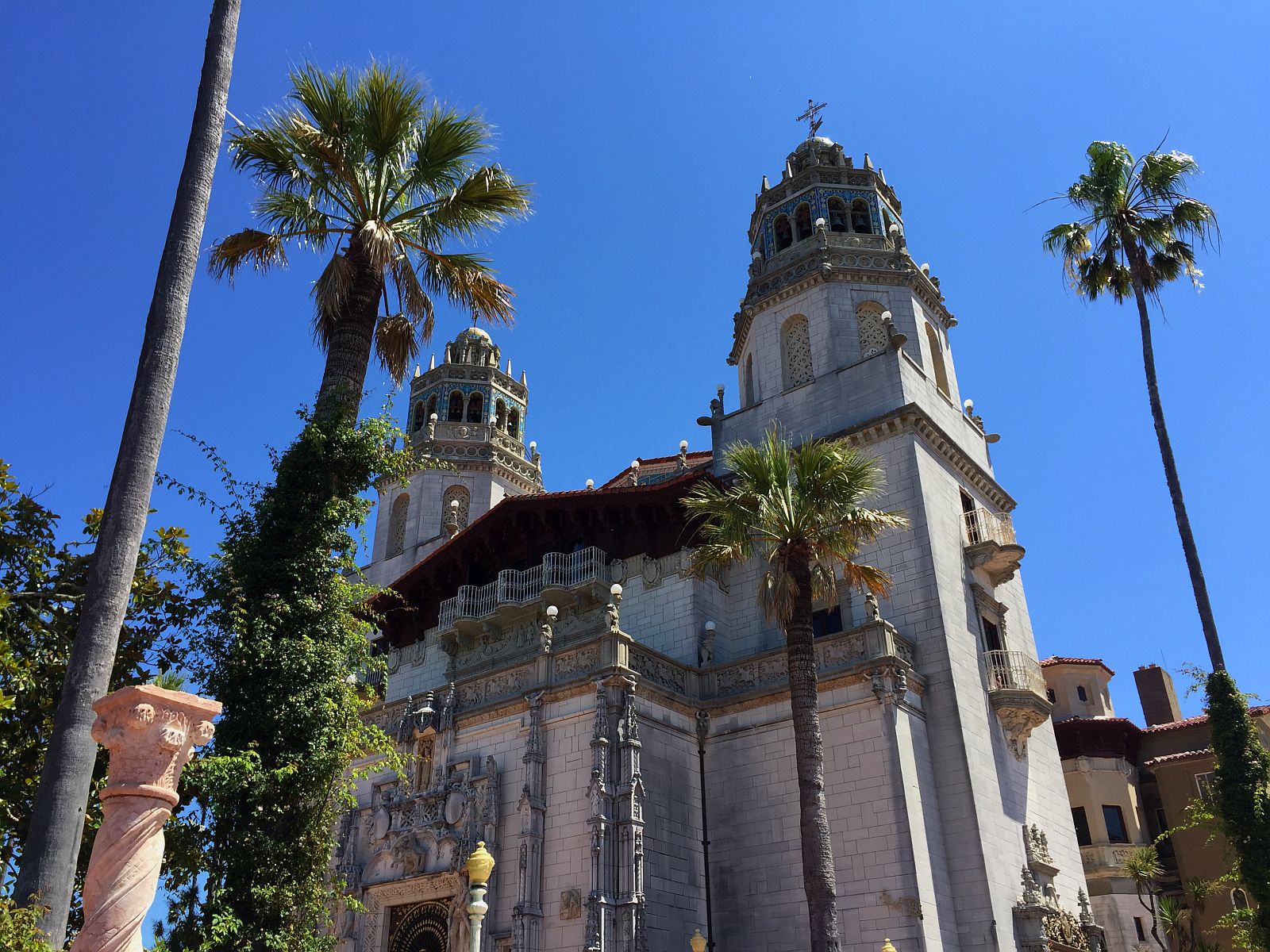
For most people, the culmination of Highway 1 lies far up on a hillside above the highway, out of sight but certainly not out of mind for anyone in the area: Hearst Castle. Located a short drive north in Sam Simeon, we found ourselves the next morning on a tour bus chugging along a windy road up a barren hill, the voice of Alex Trebek narrating the history of the late media baron’s “summer home.” Built on a 40,000-acre estate bought by William Randolph Hearst’s father in 1865 (later expanded to over 265,000 acres), the complex is comprised of the main building (Casa Grande — modeled after the church Santa María la Mayor, in Ronda, Spain) as well as three guest houses, the famous Neptune Pool and accompanying indoor Roman Pool, as well as a nearby zoo that was once home to hundreds of animals, many of which were free to roam the land. In all, Hearst Castle is made up of 58 rooms, 41 fireplaces, and requires half a million gallons of water to fill both pools.
With the sun beating down on us, the temperature inched up to over 100 degrees as we reached the top. The castle, now officially a California Historic Landmark (with private access for Hearst’s heirs), offers several tours. We opted for the La Casa Grande Rooms Tour, the guided tour of the main living room (complete with a hanging wood ceiling and Renaissance-era tapestries covering the expansive walls), as well as the Medieval-style dining room, billiard room and classic movie theater where the likes of Charlie Chaplin, Cary Grant and Joan Crawford once were entertained.
After the tour, visitors are free to roam the grounds for as long as they want. We took our time exploring the nooks and crannies around the several guest houses, as well hiding from the sun inside the lavish Roman Pool. Had the late morning’s heat not started to finally wear us down, we could have spent at least another hour exploring the meticulously maintained grounds and surrounding gardens.
Back down the hill and across the highway, we stopped in town at Sebastien’s General Store, a former general store and still home to a small post office that can date its history back to 1867. The store is now home to the Hearst Ranch Winery tasting room and a small cafe specializing in burgers made from cattle from the Hearst Ranch.
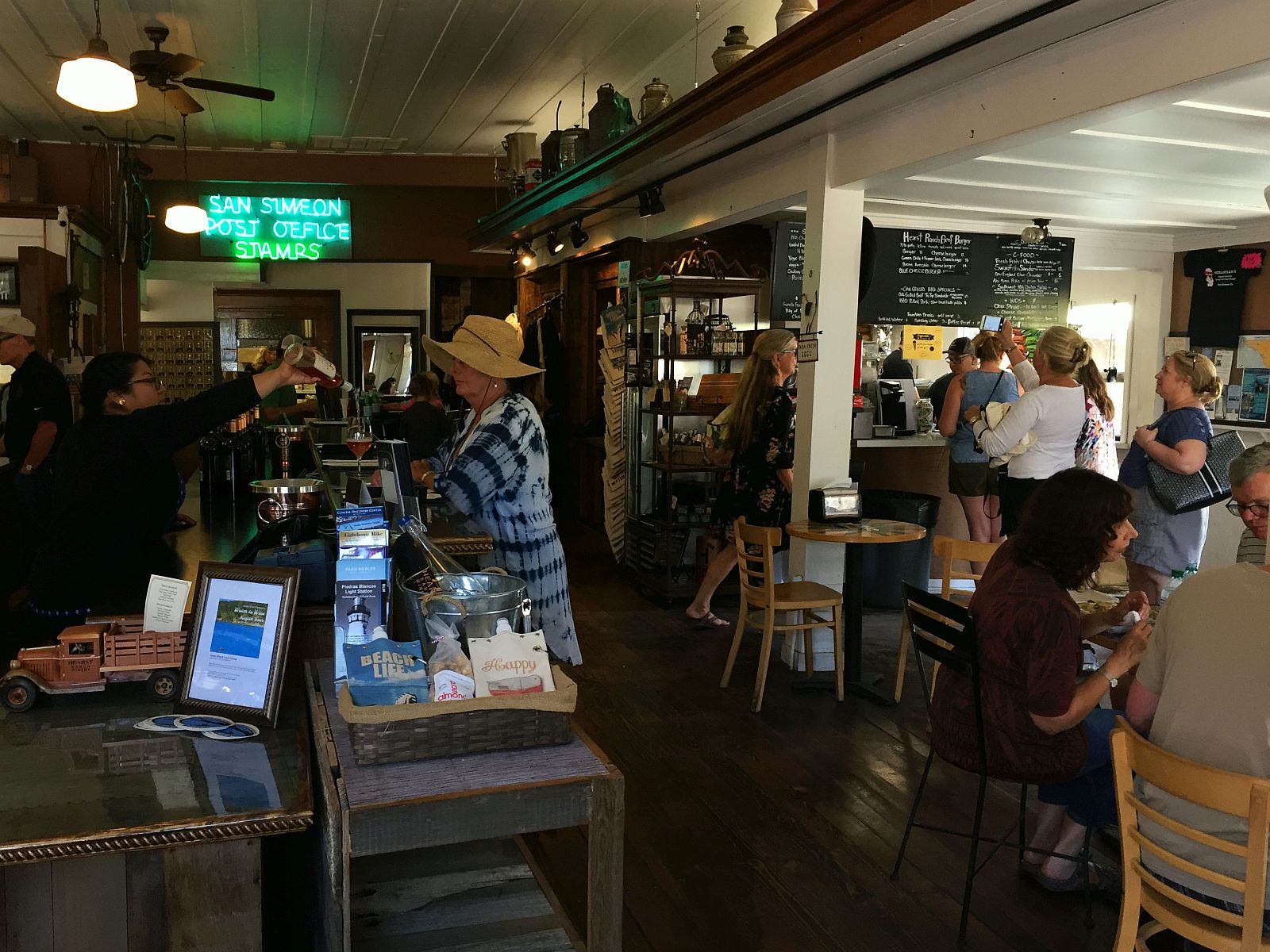
My favorite from the tasting was the gold-medal Cabernet Sauvignon (look for the black cherry, lush blackberry, and roasted coffee bean flavors), but you’d be hard-pressed to find any you didn’t like, especially paired with a grilled cheeseburger.
With the afternoon sun beating down on the coastline, it was a perfect time to check out the area’s most famous sunbathers: the northern elephant seal. A short drive north along Highway 1 from San Simeon is the Elephant Seal Rookery, home to an ever-growing colony of elephant seals who come ashore for one-month intervals, twice a year: during the winter for mating season, and then in the summer to molt and grow new fur.
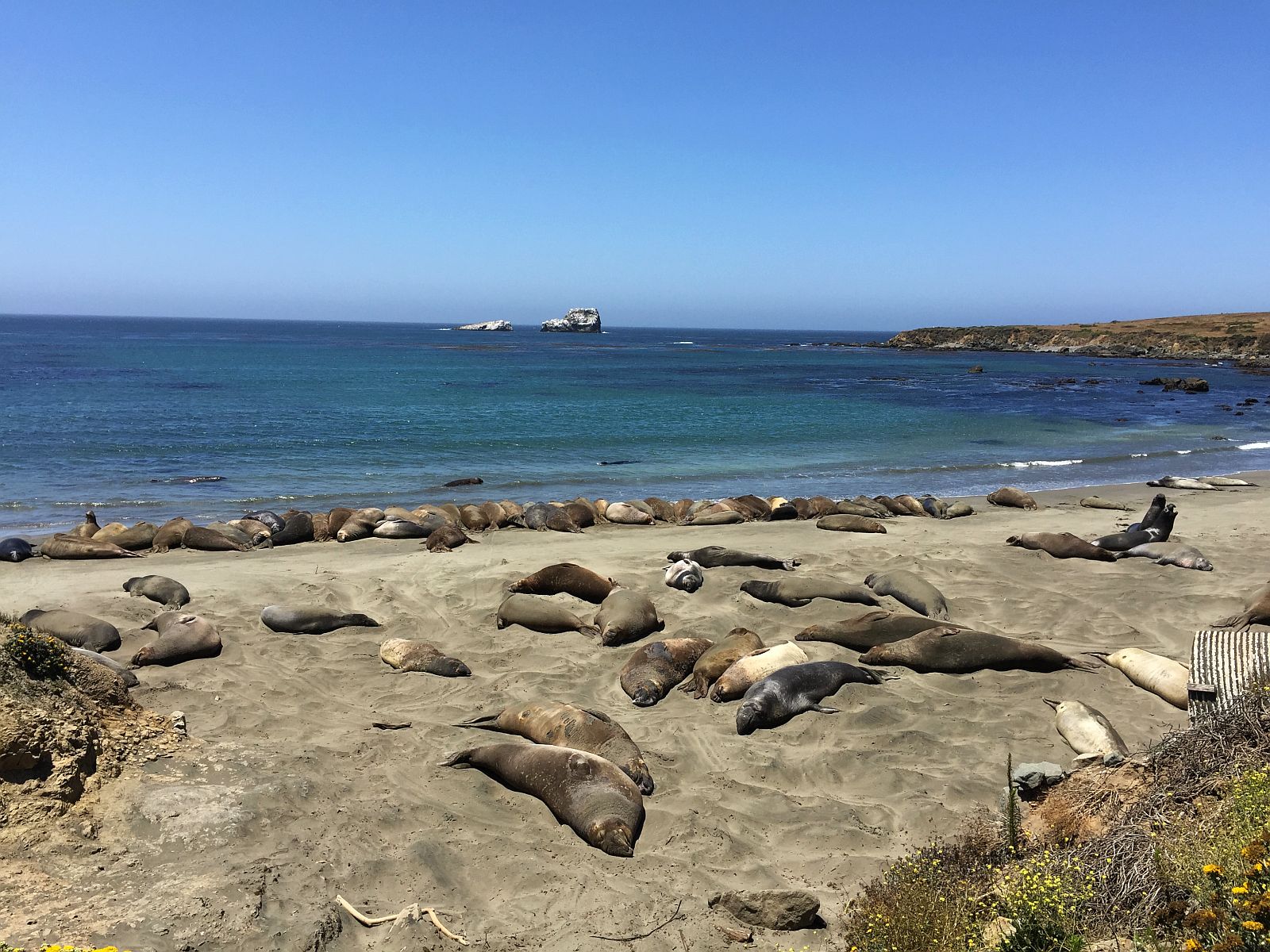
Parking our car in the small lot next to the beach, we followed the elevated viewing platform until coming upon a small section of the beach were a rotating group of 50 to 75 elephant seals were lounging about on the water’s edge, their massive bodies piled upon each other, forming a heaving, massive blob of life.
The elephant seal is the largest seal in the Northern Hemisphere and the second largest seal in the world — their lengths reaching up to 16 feet long and weighing upwards of 4,000 to 5,000 pounds. From above, we watched as the seals swam out of the water and pushed their way into the middle of already crowded groups for a spot to lounge, while others were content to slither their way further up the beach and flip cool sand onto their bodies with their short arms.
Looking north, I could see Highway 1 snaking northward along a dry valley, eventually leading to Ragged Point, through Big Sur and on to Monterey and San Francisco. But this would be as far north as we would be traveling. Tomorrow it was back south for us. Luckily, I had saved room in my luggage to take home several bottles of wine collected along they way, reminders of the road trip for another day.

/
 Matt Stabile is based in New York City, and is the founder and Editor-in-Chief of The Expeditioner which was founded in 2008. You can read his writings, watch his travel videos or contact him via email at any time at TheExpeditioner.com.
Matt Stabile is based in New York City, and is the founder and Editor-in-Chief of The Expeditioner which was founded in 2008. You can read his writings, watch his travel videos or contact him via email at any time at TheExpeditioner.com.
The post Wine, Sun And Seals: A Highway 1 Road Trip appeared first on The Expeditioner Travel Site.
]]>The post In Search Of Life In Morro Bay appeared first on The Expeditioner Travel Site.
]]>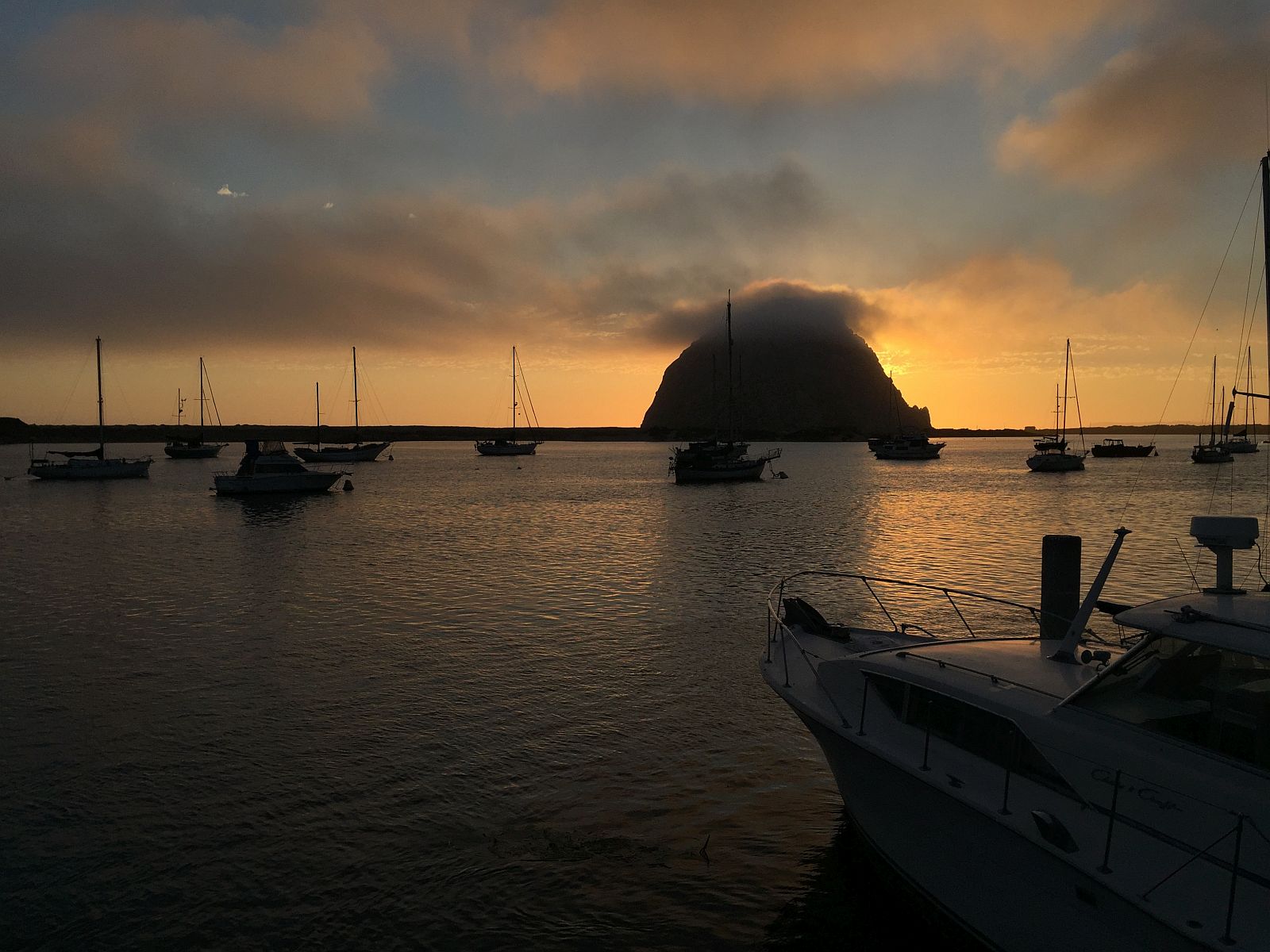
It’s hard to compete for the attention of travelers to California when your neighbor to the north is San Francisco, arguably one of the country’s most beautiful cities, and Los Angeles to the south, which, let’s face it, doesn’t have to work hard to get noticed.
It’s lucky for the Central Coast, that coastal stretch of Central California between those aforesaid cities, that it’s been blessed with enough natural beauty, sandy beaches, esteemed wineries and assorted species of wildlife that it doesn’t have to work all that hard for a place in the spotlight.
After a short stay in Los Angeles and a stop in Santa Barbara to celebrate the 4th of July, my travel partner and I got back in the car and headed north. Our first stop, Morro Bay, took about two hours to drive to, beginning with a jaunt through countless acres of farmland, where much of the country’s produce comes from, followed by a lengthy stretch where we were treated to panoramic views of long, sandy beaches with the sparkling waters of the Pacific Ocean stretching out toward the clear sky. As we approached town, iconic Morro Rock appeared on the horizon, jutting out from the ground like a giant road marker leading our way into town.
Morro Rock is actually a 581-foot high magma mixture that is the remnant of ancient volcanic activity, one of 13 along the coastline in this area. Stretching out below it is the town’s namesake bay, Morro Bay, a 4-mile-long bay home to an eclectic mix of wildlife including over 200 species of birds such as the great blue heron, the great and snowy egret and red-tailed hawks, as well as many water mammals such as harbor seals, sea lions and California sea otters.
On our first morning out, in order to get a better, more intimate view of the wildlife, we decided to don life preservers and take a guided kayak tour of the bay via Central Coast Outdoors. Founded by former tour guides, Central Coast employ some of the most knowledgeable guides in the area. Leading us out that morning was our guide, Mandy, an ex-competitive kayaker who was thankfully long on patience (her first task that morning was dealing with New Yorkers getting into kayaks for the first time in a long while).
Our first stop in the water was a long inlet through the marshland where we encountered about two dozen sea lions lazily laying on the shore’s edge, sunning themselves under the morning sun. Careful not to get too close as to disturb them, the occasional sea lion would lift his head and reveal his long whiskers as we passed by, checking out the new aquatic visitors. On our way back out into the bay, a youngster dove in as we passed and followed along at a distance, playfully watching as we rowed away.
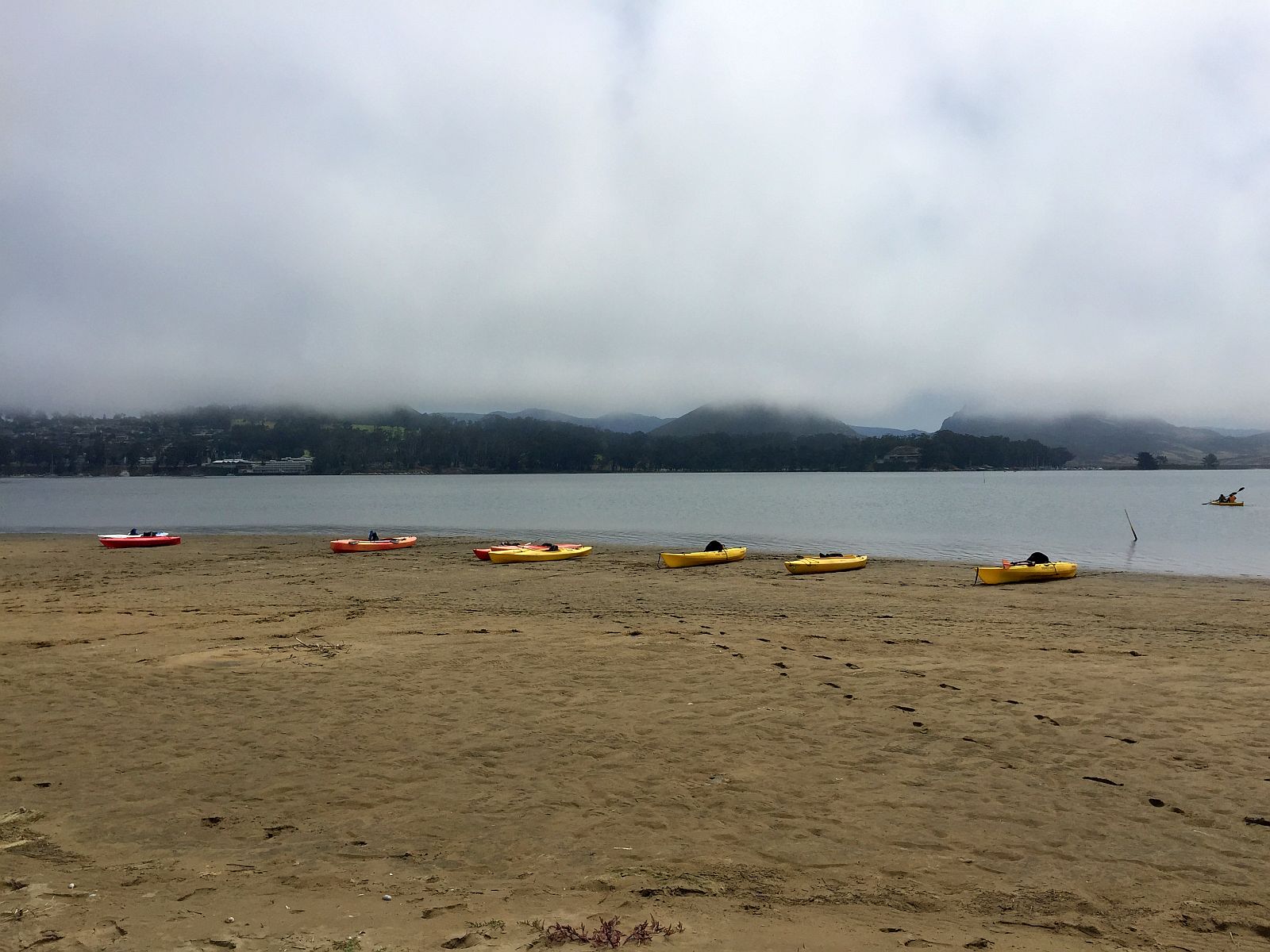
After kayaking out to a moored barge — now a newly working oyster farm where we watched the fisherman haul in their take — we made our way to the far edge of the bay and grounded our kayaks along the sandy beach on the spit of land that separates the bay from the ocean. While lunch was being unpacked, we hiked across the tall sand dunes for views of the ocean where the waves pounded the beach with Morro Rock towering in the distance.
After a well-earned lunch of freshly made quinoa salad, turkey and tomato sandwiches, walnut apple salad, and of course a couple glasses of local wine, we hopped into the kayaks and rowed back across the bay.
As we approached the water’s edge, we began to hear the low din of hundreds of birds calling out. Here on a small stretch of protected land, the former owners of a nearby mansion had planted a grove of eucalyptus trees, which is now the Heron and Cormorant Rookery, a nesting ground for hundreds of great blue herons and great and snowy egrets.
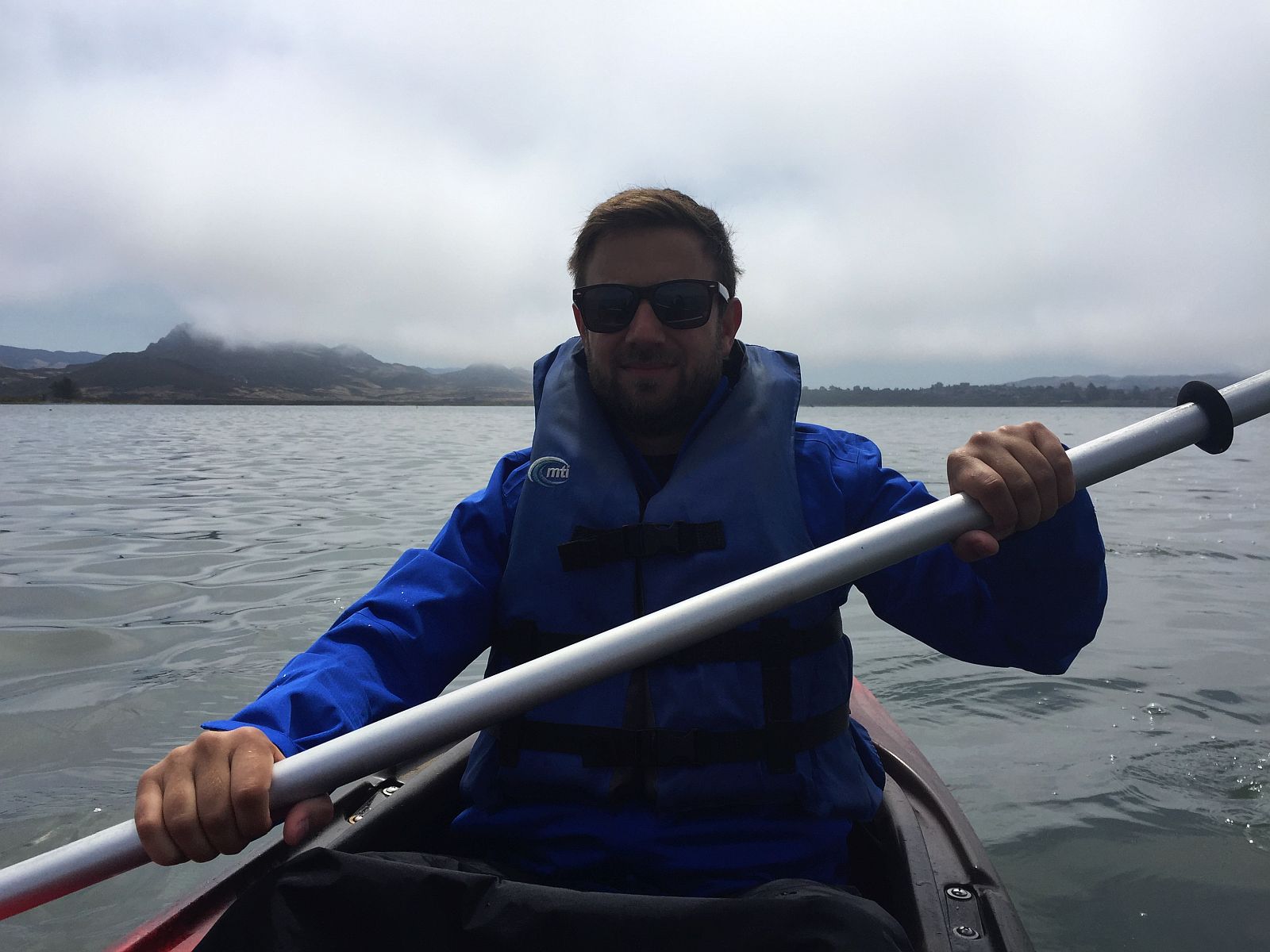
Paddling up to the point where we were nearly underneath some of the nests, we could make out the chicks calling out to their parents who were busy scrambling around the treeline with bits of food hanging from their mouths, as well as the occasional toddler who was brave enough to walk to the ends of the branch, but wasn’t quite ready to make the leap, its wings flapping in the wind to gather strength for their eventual departure.
Having worked up an appetite from the day’s activities, we cleaned up back at our hotel, the 456 Embarcadero Inn & Suites, a newly renovated, family-owned hotel that transformed itself from a mid-century seaside motel to a slick, boutique inn with sweeping views of the bay and a great location in the center of town.
The main street that runs along the waterfront, Embarcadero, is home to a variety of traditional seaside shops including candy stores, knick-knack shops, and even a small aquarium home to an open-air sea lion habitat. This being Central Coast wine country, before dinner we stopped off at Chateau Margene, one of several tasting rooms in town. The vineyard itself is in nearby Creston, and we had a full tasting of their signature Bordeaux-style wines (Cabernet Sauvignons, Cabernet Franc and their Meritage blends).
For dinner we decided on The Galley Seafood Grill & Bar, one of the town’s oldest and most beloved restaurants, featuring a revolving selection of freshly caught seafood. We started with an order of oysters — farmed locally as a result of the bay’s recent efforts to rehabilitate the once ailing industry — along with the crab cakes made with the local Dungeness crab, followed by seared ahi tuna and Pacific swordfish.
As we walked back home along the waterfront, we looked out across the bay. Morro Rock was enveloped in an orange haze, the sun having recently set behind it, and a flotilla of boats bobbed in the water as if setting their bows in the direction of the best view: a fitting view of the bay where so much life here calls home.

/
 Matt Stabile is based in New York City, and is the founder and Editor-in-Chief of The Expeditioner which was founded in 2008. You can read his writings, watch his travel videos or contact him via email at any time at TheExpeditioner.com.
Matt Stabile is based in New York City, and is the founder and Editor-in-Chief of The Expeditioner which was founded in 2008. You can read his writings, watch his travel videos or contact him via email at any time at TheExpeditioner.com.
The post In Search Of Life In Morro Bay appeared first on The Expeditioner Travel Site.
]]>The post Now’s The Time To Snag A Pair Of Travel Shorts appeared first on The Expeditioner Travel Site.
]]>
If you were waiting to load up on some late-season summer clothes at a discount, now’s the time to act. The ultimate travel clothes company, Bluffworks, whose clothes I wrote about before, is running a great sale on their line of travel shorts.
Shop the entire shorts collection by clicking here.
As a reminder, New York City-based Bluffworks specializes in travel clothes that are meant to never wrinkle, are breathable, include hidden pockets, and best of all, don’t actually look like traditional “travel clothes” — read: they’re actually stylish.
With the summer winding down, Bluffworks has dropped the price of their travel shorts down to $52.50 (normally $75), with styles in Midnight Blue (my favorite — everything I own is blue), Dark Tan and Flint Grey.
Here’s a technical rundown of the shorts:
• 100% technical, breathable, quick-dry polyester. Nylon pockets.
• Zippered side pocket perfect for phone storage. Fits an iPhone 6 or a Galaxy S4.
• Hidden front inside pocket with Velcro seal, sized to hold cash or credit cards.
• Inner front pocket phone storage designed to secure phone while moving.
• Zippered left rear pocket, sized for an oversized travel wallet.
• Machine washable. Line or tumble dry.
Good luck getting a pair before the collection runs out, and don’t despair, just because summer is winding down here in the Northern Hemisphere, it just means spring is starting up for the other half of the world.

/
 Matt Stabile is based in New York City, and is the founder and Editor-in-Chief of The Expeditioner which was founded in 2008. You can read his writings, watch his travel videos or contact him via email at any time at TheExpeditioner.com.
Matt Stabile is based in New York City, and is the founder and Editor-in-Chief of The Expeditioner which was founded in 2008. You can read his writings, watch his travel videos or contact him via email at any time at TheExpeditioner.com.
The post Now’s The Time To Snag A Pair Of Travel Shorts appeared first on The Expeditioner Travel Site.
]]>The post The Top 50 Travel Blogs (2nd Quarter: 2017) appeared first on The Expeditioner Travel Site.
]]>
Below is a list of the top 50 travel blogs for the 2nd quarter (April — June) of 2017 ranked by visitor traffic.
There are a few other sites that have put together their own lists of the “top” travel blogs.
However, each has their own subjective means of ranking sites, using everything from Alexa scores, Twitter followers, Facebook likes, estimated traffic, inbound Google links and even subjective design criteria.
My intention was to create the most objective and accurate list of the most popular travel blogs.
Therefore, this list is based solely on the number of visitors a travel blog receives. To read more about how this list was put together, please read below.
I reached out to a large sampling of travel bloggers and asked that they provide me with a screenshot of their Google Analytics page reflecting their site’s visitor statistics over the most recent quarter. The reasoning behind this method was that I wanted to obtain a rolling average to compensate for monthly spikes that may have occurred. Further, utilizing Google Analytics as the uniform measure of traffic helped to ensure uniformity of data across all sampling.
Of course, due to this method of collecting data, only those site owners that submitted their statistics were included for consideration in the rankings. Those that did not submit were not considered. Further, in an effort to maximize the number of participants and to protect specific traffic numbers that some site owners regard as sensitive and private, I agreed to keep all specific data confidential and not include those numbers in the rankings.
Why This Metric?
Simple, it’s the most accurate, best picture of a site’s traffic. As everyone knows, Alexa is not very accurate and can be easily manipulated. Inbound links are a great sign of SEO, but just because a site does well with Google doesn’t mean it has a lot of visitors. Twitter followers are great, but that doesn’t necessarily translate into site readers.
Quite simply, unique visitors is the one metric that most accurately reflects a site’s readership.
Who Cares?
I understand that just because a site gets a high number of unique visitors doesn’t mean it’s the highest quality site. There are plenty of excellently written, well-designed, engaging sites that may not have high traffic numbers.
My intention was not to create a list of the best, or the most useful, or the most professional travel blogs. I simply wanted to create the most accurate list of the most visited blogs. Just as the movie weekend box office results are reported every week, I simply wanted to create an unbiased, objective list of the most visited travel blogs for research purposes.
Finally, I hope this list will serve as a useful guide and a good starting point for travelers and readers around the world looking to explore the vibrant and eclectic travel blogging community, and expose them to some great travel blogs that they otherwise may not be reading.
*
Click Here to Read the Complete Past Lists of The Top 50 Travel Blogs

/
 Matt Stabile is the Founder and Editor-in-Chief of The Expeditioner. The Expeditioner began in 2008 and is headquartered in New York City. You can read his writings, watch his travel videos or contact him at any time at TheExpeditioner.com.
Matt Stabile is the Founder and Editor-in-Chief of The Expeditioner. The Expeditioner began in 2008 and is headquartered in New York City. You can read his writings, watch his travel videos or contact him at any time at TheExpeditioner.com.
The post The Top 50 Travel Blogs (2nd Quarter: 2017) appeared first on The Expeditioner Travel Site.
]]>The post A Powder Highway Ski Trip Through Canada appeared first on The Expeditioner Travel Site.
]]>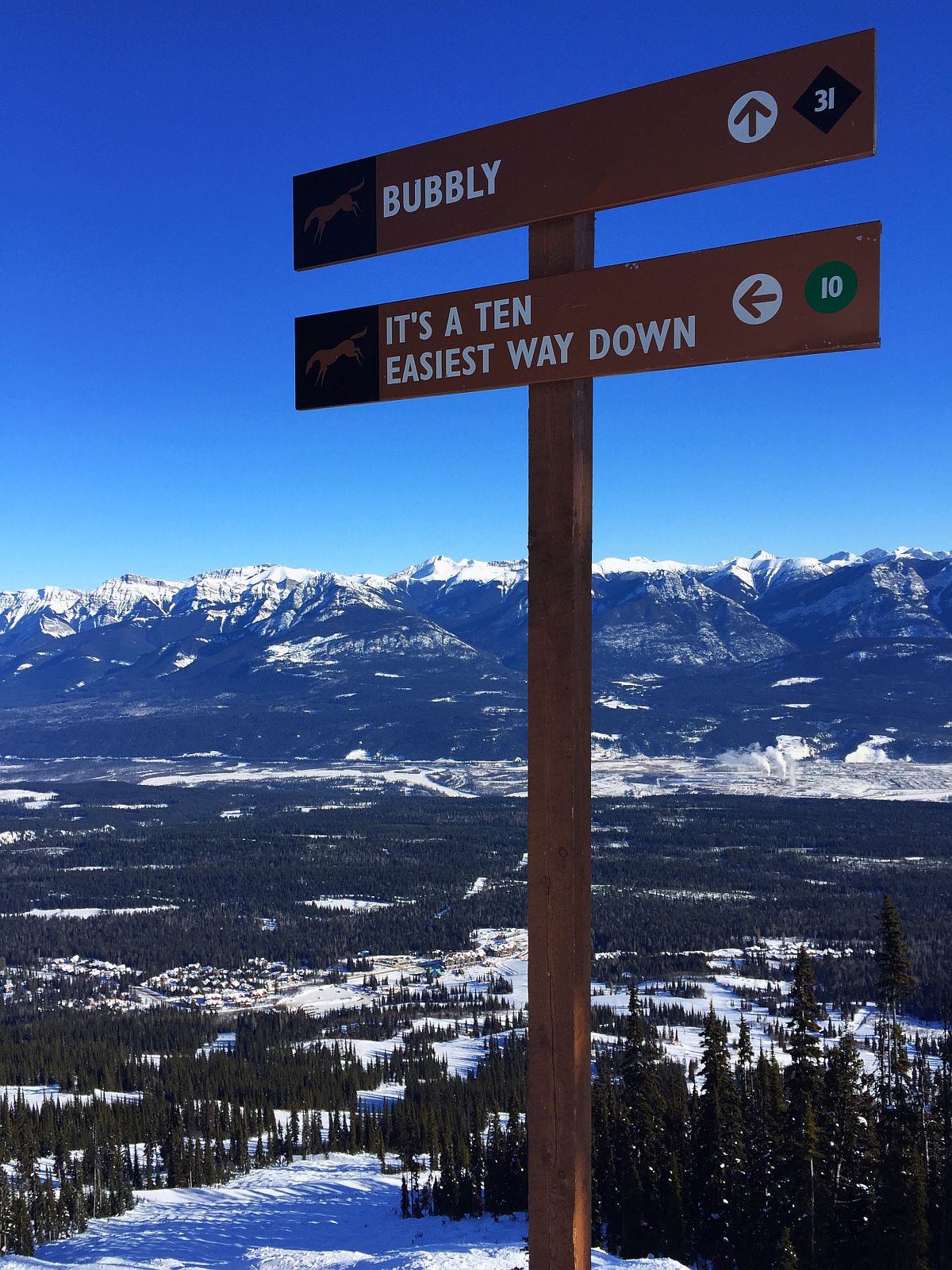
About halfway into the 18-minute, high-speed gondola ride up the mountain, my brother-in-law turned to me. He had a concerned look on his face. Beyond us in the distance we could see the steep vertical drops along the south ridge of the forebodingly titled Terminator Peak, the 7,900-foot mountain that caps the southern portion of Kicking Horse Mountain Resort.
Concerned is not the look you want to see on your skiing partner, especially when your skiing partner happens to have a good 20 years more of experience than you and is arguably at peak condition. Oh, and did I mention, had successfully trained at and passed the Police Academy?
“Just don’t tell my sister,” was the best I could come up with.
We were on the first lift up marking the beginning of a road trip through Canada’s famed Powder Highway. Despite the name, the Powder Highway isn’t a highway at all, but the unofficial name given to the region of southern British Columbia located on and between the Rocky Mountains and Columbia Mountains that is home to roughly 30 ski-related destinations ranging from traditional Nordic-style mountains, heli- and cat-skiing operators, and backcountry lodges.
To get there, most people fly like we did, to the oil-rich plains of Calgary, Alberta, rent a four-wheel-drive vehicle, then drive three hours due west through the Rocky Mountains on what is probably one of the most scenic stretches of road in the world through Banff National Park (itself home to several of the most famous ski resorts in Canada), where you are quickly enveloped by snow-covered peaks on either side of you. It’s here you realize early on you’re entering ski country.
Our plan was to take a circuitous route starting from the north at Kicking Horse Mountain Resort in the Purcell Mountains, head due south along Highway 95 and ski Kimberley Alpine Resort, then turn due east and back into the Rocky Mountains and take on Fernie Alpine Resort, before returning north to Calgary to catch our flight a week later. This would allow us to visit three of some of the most well-known ski resorts in the region, and to get a taste of the different snow conditions each mountain offers given their different terrains and locations (there was a lot of talk of snow composition during this trip, so be prepared).
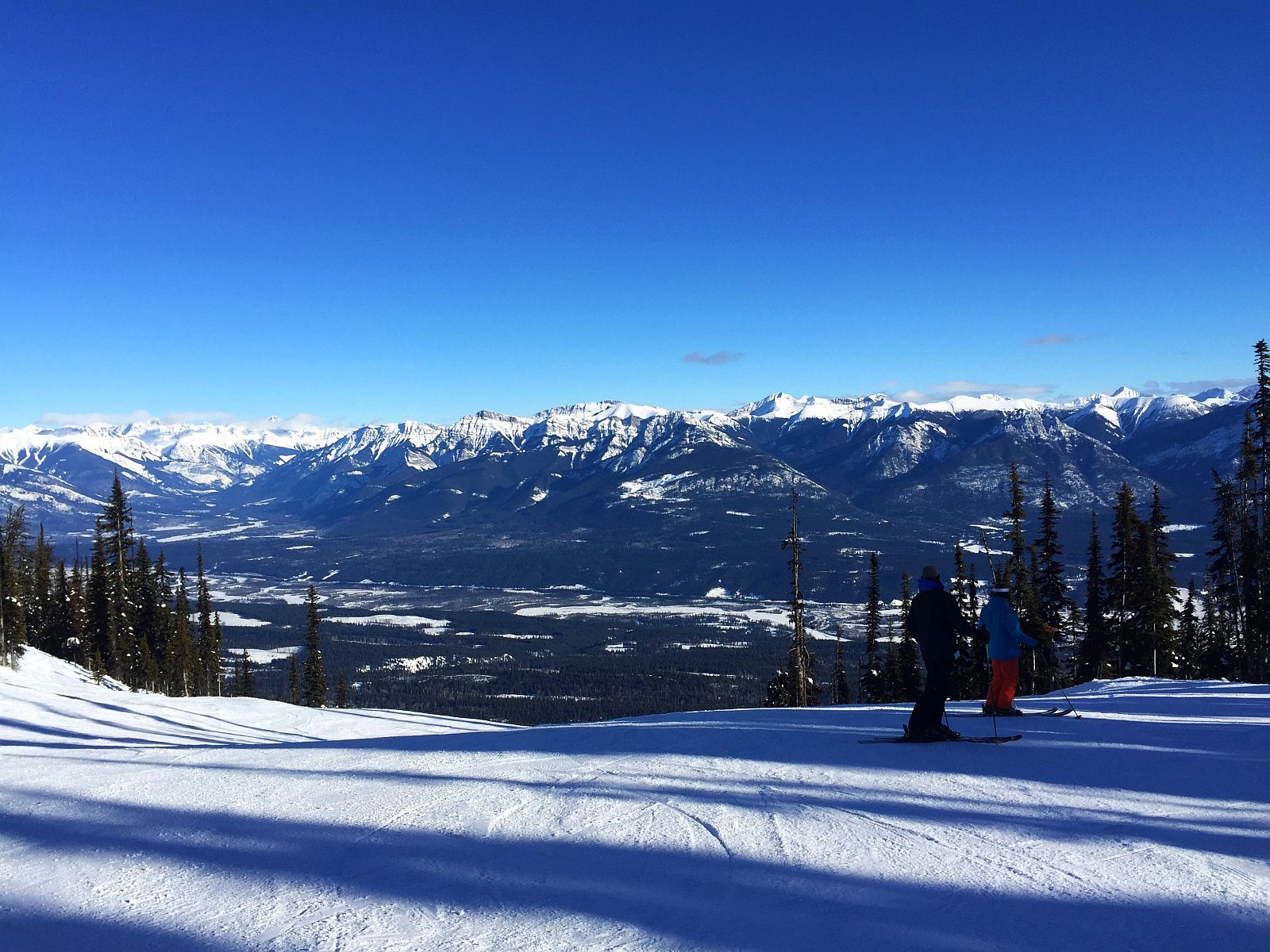
Kicking Horse
Kicking Horse, located in the small mining town of Golden, is what is truly known as a “Skier’s Mountain.” Featuring the fourth-highest vertical drop in North America and over 2,800 acres of skiable terrain, Kicking Horse is one of those mountains that remind you of the footage you see in hardcore skiing movies you watch back when you’re safely on flat ground.
Having only started up skiing again the winter before after a decade-long break, the tentacles of trails plunging precipitously downward underneath our gondola had me racking my brain as to what level of skier I had told our guide that I was.
“I did mention on the email that I probably fall closer to the novice/intermediate level than advanced, right?” I asked Emile, a former ski instructor from Whistler and recent transplant to Golden.
“Don’t worry, we’ll stick to the beginner and intermediate trails,” he responded.
A memory popped in my head of someone telling me how the trails out West were graded on a curve, meaning many of those black runs back on our icy mountains on the East Coast were given such fuzzy labels as “Beaver Tail” and “Jelly Bean” here.
After arriving to the peak and making our way across the gently sloping trail atop CPR ridge (yes, really), we in turn dove down and into the nearly empty Crystal Bowl, gliding effortlessly through the “champagne powder” layer that had accumulated the night before, our skis naturally catching each turn and responding to each motion.
Did that just really happen? Powder snow? Responsive turns? Open glens bereft of hordes of skiers? As any East Coast skier can tell you, the initial sensation you feel on a mountain out West after years of carving through narrow, icy chutes, elbow-to-elbow with other skiers, is akin to the joy a bird must feel when let loose from their cage after years in captivity.
It was a classic bluebird day, and we spent the morning making trips up and down the mountain, an amazing feat when we realized how much skiing one can do when there are no lines at the lifts. Given that the distance from top to bottom is roughly 4,000 feet, it’s not unheard of to get in 40,000 feet of skiing on a comfortable day, a truly amazing amount of distance.
Of course, that would likely mean skipping lunch at the famed Eagle’s Eye Restaurant, which we weren’t prepared to do. The mountaintop eatery at the top of the main gondola offers skiers the opportunity to lunch on Truffle Fries or dig into a Strip Loin Steak, featuring Alberta Angus Beef served with Garlic Butter and Onion Jam, all while gazing several thousand feet out across the mountain vista. For those looking for one of the more unique lodging experiences, the restaurant is also home to two B&B-style rooms on the second floor with sweeping views of the resort.
Late in the afternoon after another lengthy run down the mountain, my brother-in-law turned to me as we came to a stop at the base. “This is easily the best skiing I’ve ever done in my life!” The irony of the statement is that the local staff kept apologizing to us for the unseasonable lack of recent snowfall the past week. Believe me, no apologies were necessary.
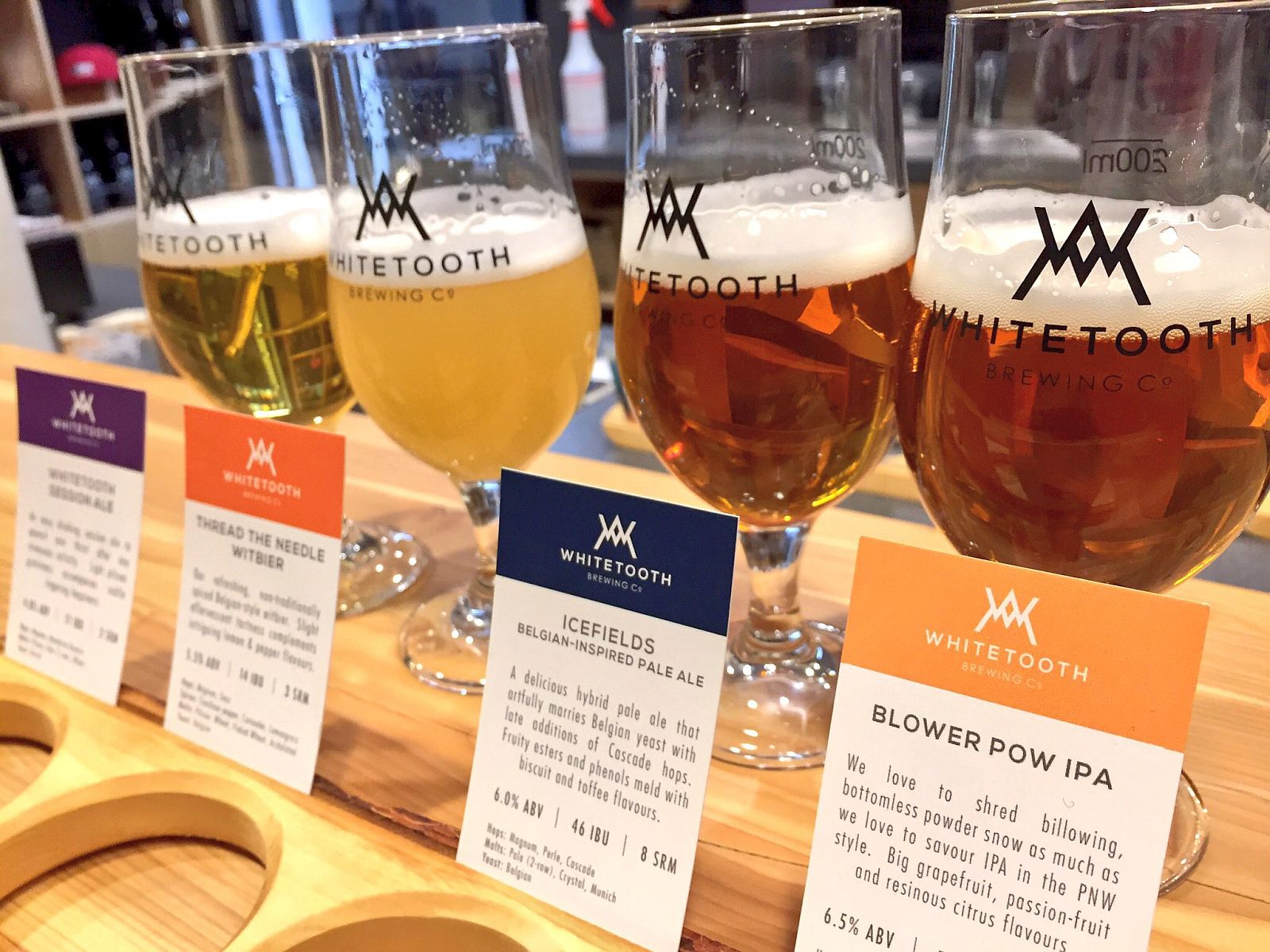
After a quadriceps-burning afternoon catching as many runs as we could before the low-rising winter sun began to set, we cleaned up back at the base lodge, then headed into town to explore Golden’s après-ski offerings.
Our first stop was the newly opened Whitetooth Brewing Company. Opened by home brewer Kent Donaldson, the brewery is part of a recent uptick in the number of breweries in the province as a result of the elimination of a law that once prohibited such breweries form serving beer to the public. Whitetooth specializes in so-called “West Coast” and Belgian-style beers, including the Thread the Needle Witbier, featuring lemon and pepper flavors, and the Icefields, a Belgian-inspired Pale Ale with a toffee aftertaste. The best option is the four-beer flight served with collectible cards that break down each beer’s composition (including names of each beer’s hop, malt and yeast).
After downing our flights, we decided on dinner at The Wolf’s Den. With its woodsy lodge interior and bonfires burning out front, you could almost imagine you had stumbled into a restaurant deep in mountain country, which, technically we were. In keeping with that theme, I chose the Elk Burger because, well, when else am I going to get the chance to eat one? The 7-ounce elk patty was served with peppercorn sauce and topped with Swiss cheese and whiskey bacon jam. I’m not much of a burger guy normally, but the flavor I tasted after biting into the game meat had me wishing there were more New York restaurants looking to expand their menu offerings.
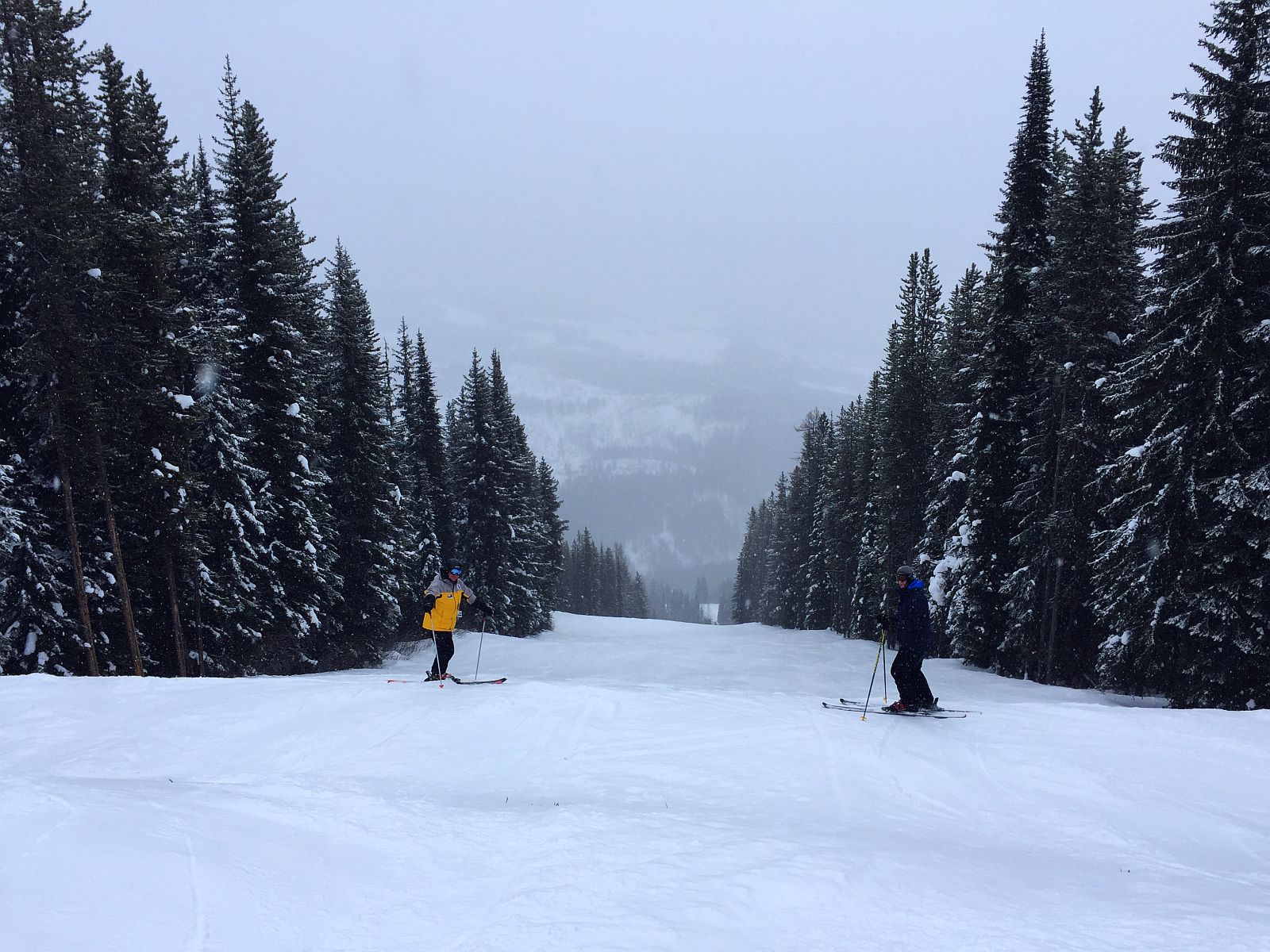
Kimberley
For our second stop, we turned southward and made our way through the long valley between the steep Purcell and Rocky Mountains. We passed several pristine mountain lakes nestled along the highway, their surfaces shining bright blue in reflection of the sky. Along the way we also drove past Radium and Fairmont Hot Springs, publicly accessible natural hot springs bubbling up with sulfuric-tinged water pushed to the surface as a result of geologic activity that has its roots in the very mountains that now framed the horizon out our car’s windows.
Late in the afternoon we arrived at Kimberley Mountain Resort and settled in to the Trickle Creek Lodge where we would be staying for the evening. With the stated goal of stuffing ourselves with as many calories as possible to make up for the last 2 ½ days of downhill exertion, we met up with local Jesse Ferguson who agreed to show us a bit of what this former mining town had to offer.
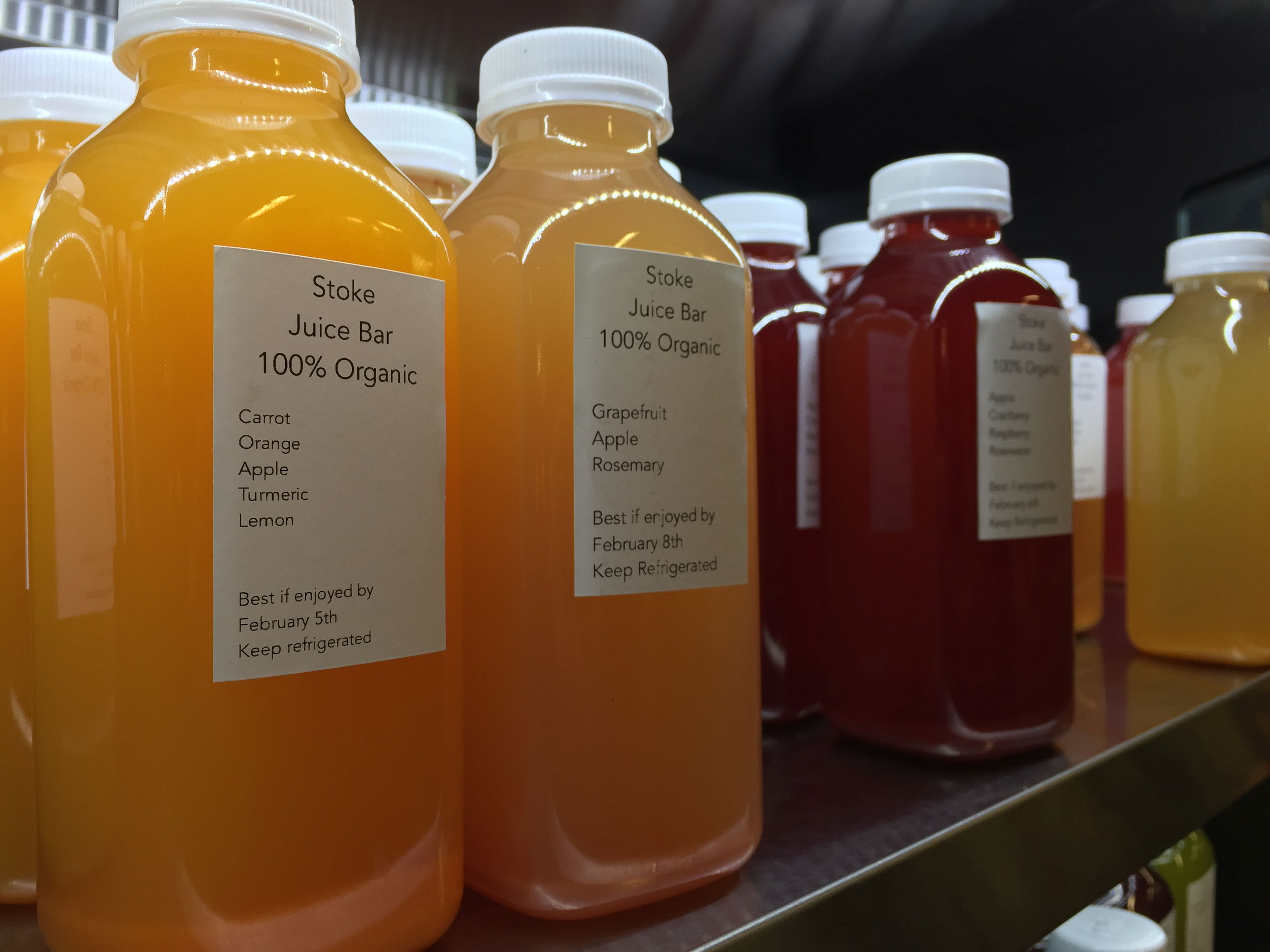
First we stopped off for provisions at Centex Market. Run by Jill Bentley, this former gas station had been in operation for over 30 years before being recently converted by her into a thriving organic grocery store teeming with products that could rival any Whole Foods. We stocked up on breakfast burritos and Stoke Juices, her signature line of bottled juices prepared fresh every morning on site by cold pressing between 3 – 5 pounds of fruits and vegetable per bottle.
After parking near the center of town, we made our way to downtown Kimberley where rows of Bavarian-themed storefronts and buildings line the carless thoroughfares. Finding a place to eat or drink in Kimberley is not difficult given the fact that it’s home to the most number of restaurants per capita than anywhere else in Canada. We decided on pre-dinner beers at the wood shed-themed bar appropriately named The Shed, where you can try pints from local brewer Over Times Beer Works among groups of local “lifties” (those who work at the nearby resort) and racks of tools hanging from the walls.
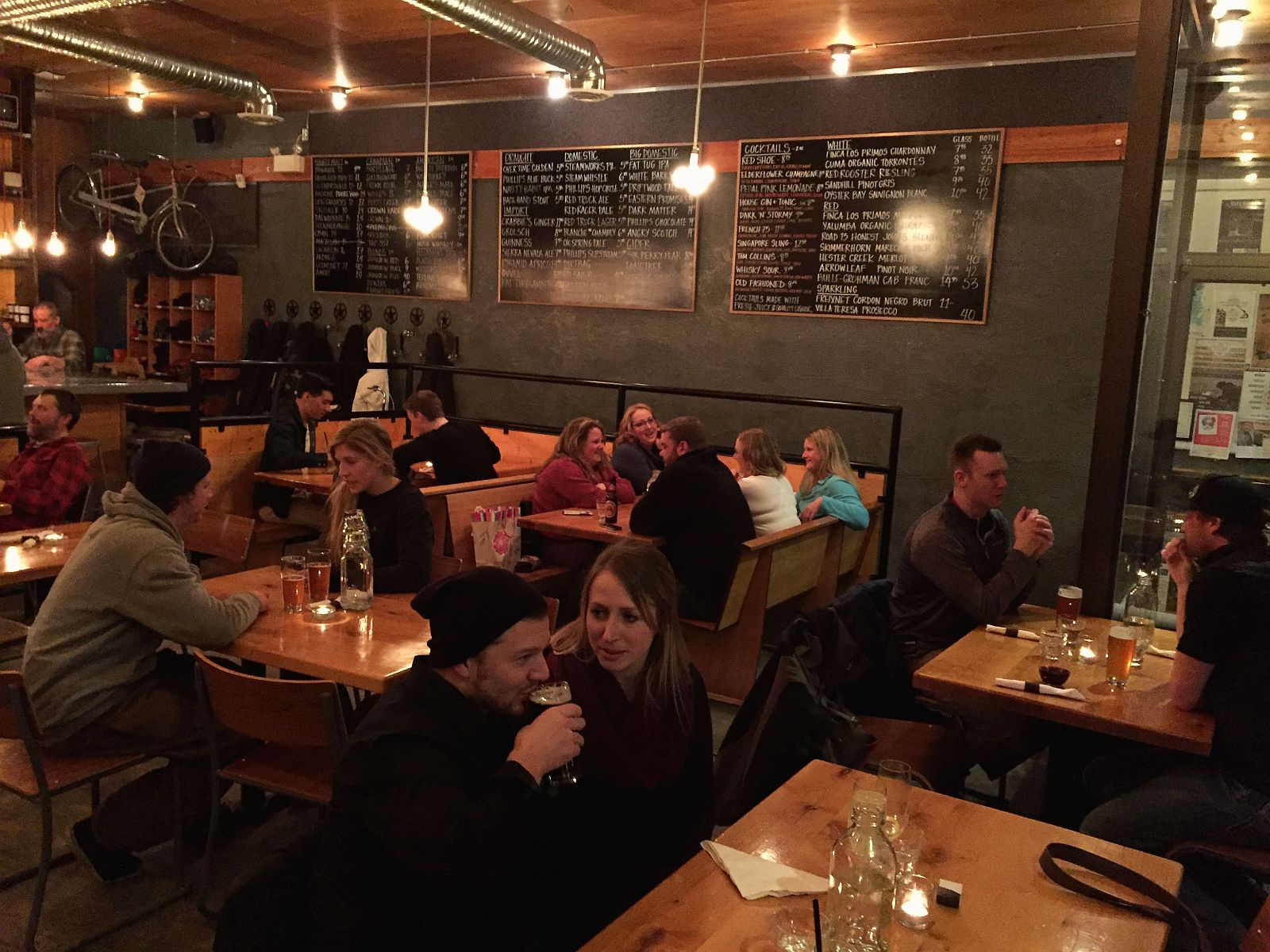
For dinner we walked around the corner to Pedal & Tap, one of the highest rated restaurants in the city and which decided on a bike theme for its decor (they’re big on themes here). We decided on their famous Mucky Fries for our starter — hand-cut fries mixed with mozzarella, aged cheddar, maple bacon and green onions, and topped with a chipotle sauce — and the Wild Boar Meatloaf Medallions (they come wrapped in bacon and served with a cherry BBQ sauce) and the Vegan Thunder (a hearty Indian-influenced soup) for dinner.
By the next morning a wintry cold front had moved in, and the trails were covered with a fresh layer of powder snow greeting us as we headed out to explore the mountain’s 75 runs spread out across four faces — Northstar Mountain, Tamarack Ridge, Vimy Ridge and Black Forest. We were joined by Ron Concoran who, having sold his business years ago, now calls Kimberley home year-round and lives in a mountainside chalet-style home just a 30-second ski run away from the main chair lift — not a bad way to enjoy your winters.
We began with a few runs on the wide-open trails that make up the accessible Northern Mountain. We then cut across the ridgeline to the back end of the resort to Black Forest for what was to be some of the best skiing I’d ever experienced in my life.
Spread out across two dozen runs, Black Forest was eerily quiet and bereft of the other skiers who tended to bunch up at the front of the mountain, which meant we were given free range to loop up and down the mountain the entire afternoon, varying our runs between the several black diamond chutes carving their way through the snow-covered spruces.
The climate here is drier and less windy than most mountains, resulting in a fine, powdery snow that provides one of the best skiing conditions in the world. Skis feel like they float on the snow’s surface as you navigate through it, and it provides an amazing amount of responsiveness with little exertion, a plus for long days skiing.
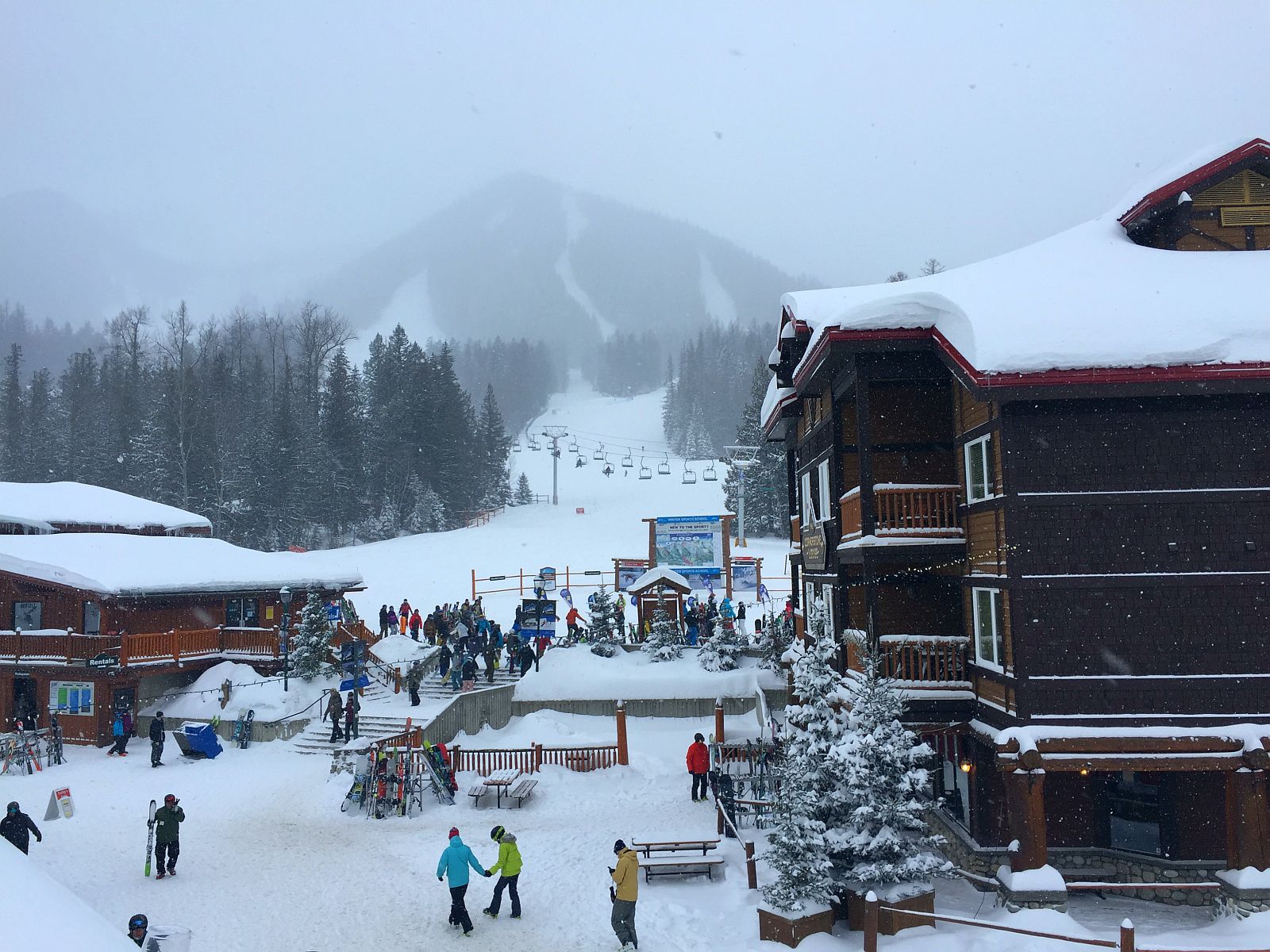
Fernie
After a quick lunch at Stemwinder Grill in the resort village, we packed up and drove 1 ½ hours due east through the Rockies to the range’s eastern facing side to the famed Fernie Alpine Resort.
The resort has long been regarded as one of the favorite mountains in all of the Powder Highway for a few basic reasons. First, it’s huge. The resort features five main bowls and 142 runs spread out over 2,500 acres. Second, the resort, to put it bluntly, gets pounded with snow every year, averaging 30 feet (360 inches!) per year. Lastly, it’s just plain a lot of fun. Dating back to its opening in 1973, the resort adopted the party-friendly atmosphere like many ski towns of that era, particularly highlighted by the annual Griz Days Winter Festival that honors a fictional mountain man (Griz) that is said to call the area home (the festival itself revolves around live music, food, entertainment and other related winter revelry).
With a near-blizzard setting in that night, we woke up the next morning to over a foot of freshly fallen, heavy and wet powder that carpeted the entire resort — a typical variety of snow given the moisture that collects at the front of the mountain range here.
Starting off at the far northern end at Cedar Bowl, I was not prepared for it was like to experience true powder. For an East Coast skier like myself, I was a bit unprepared on how different it would be. Used to digging in my skis and forcing directional changes as needed, I quickly planted myself face first into the snow on my first turn.
“Here’s a tip: Lean forward and let the skis float above the snow,” our guide for the day, Christina, suggested as I awkwardly picked myself up with my poles.
Though not intuitive, her advice to lean forward helped, and I slowly but surely got my ski legs back as we headed up and down each of the rest of the bowls, including the massive Lizard Bowl, the resort’s largest, as well as Currie Bowl, Timber Bowl and Siberia Bowl. By the time we made it to Siberia Bowl on the southern edge and cruised the length of the resort’s longest trail, my legs were burning and I was eyeing an excuse to break for the day and get my body in a warm tub of water as soon as possible.
Lucky for us, we were staying at the Lizard Creek Lodge, located at the base of the mountain and a stone’s throw away from one of the three base-level lifts. After a much-needed hot tub break (Fernie is where they filmed Hot Tub Time Machine after all) we met up with a group for dinner at Cirque Restaurant. With its soaring ceiling lined with exposed wood, four-sided fireplace and magnificent views of the mountain just outside the windows, it felt like a mix of Vegas mixed with the Rockies. Featuring such options as Duck Ragu Pappardelle, Sea Bass and Prawn Paupiette, and Elk Ribeye, you can rest assured you’re going to eat well in your effort to replenish the calories burned carving through thick powder during the day.

Just off the lobby of the restaurant is one of the more unique bars in the resort, the Ice Bar. We were handed fur-lined Helly Hansen parkas and led through a thick, metal door that opened up into a temperature-controlled ice-covered room complete with an carved ice bar and frozen shelves featuring dozens of different vodkas for tasting. With little knowledge in the world of Vodka, the hostess/bartender that escorted us in suggested a few bottles to try, including my favorite, the award-winning Crystal Head Vodka, partially owned by Canada’s own Dan Akyroyd.
With our nightcaps finished we strolled out into the night. The storm continued to churn over the mountains, blanketing our surroundings with another fresh layer of snow in the short time since we had sat down for dinner. The sky was pitch dark and it was quiet out except for the low drone of the snow groomers high above us on the mountains tending to the runs for tomorrow’s eager skiers. We would not be a part of them. Our legs were exhausted and our flights were the next day. Flights that would take us back to flat land thousands of miles away and to days spent calculated not in miles per hour or vertical distance covered. Those days would have to wait, once again, until the next winter.

/
 Matt Stabile is based in New York City, and is the founder and Editor-in-Chief of The Expeditioner which was founded in 2008. You can read his writings, watch his travel videos or contact him via email at any time at TheExpeditioner.com.
Matt Stabile is based in New York City, and is the founder and Editor-in-Chief of The Expeditioner which was founded in 2008. You can read his writings, watch his travel videos or contact him via email at any time at TheExpeditioner.com.
The post A Powder Highway Ski Trip Through Canada appeared first on The Expeditioner Travel Site.
]]>The post The Top 50 Travel Blogs (1st Quarter: 2017) appeared first on The Expeditioner Travel Site.
]]>
Below is a list of the top 50 travel blogs for the 1st quarter (January — March) of 2017 ranked by visitor traffic.
There are a few other sites that have put together their own lists of the “top” travel blogs.
However, each has their own subjective means of ranking sites, using everything from Alexa scores, Twitter followers, Facebook likes, estimated traffic, inbound Google links and even subjective design criteria.
My intention was to create the most objective and accurate list of the most popular travel blogs.
Therefore, this list is based solely on the number of visitors a travel blog receives. To read more about how this list was put together, please read below.
I reached out to a large sampling of travel bloggers and asked that they provide me with a screenshot of their Google Analytics page reflecting their site’s visitor statistics over the most recent quarter. The reasoning behind this method was that I wanted to obtain a rolling average to compensate for monthly spikes that may have occurred. Further, utilizing Google Analytics as the uniform measure of traffic helped to ensure uniformity of data across all sampling.
Of course, due to this method of collecting data, only those site owners that submitted their statistics were included for consideration in the rankings. Those that did not submit were not considered. Further, in an effort to maximize the number of participants and to protect specific traffic numbers that some site owners regard as sensitive and private, I agreed to keep all specific data confidential and not include those numbers in the rankings.
Why This Metric?
Simple, it’s the most accurate, best picture of a site’s traffic. As everyone knows, Alexa is not very accurate and can be easily manipulated. Inbound links are a great sign of SEO, but just because a site does well with Google doesn’t mean it has a lot of visitors. Twitter followers are great, but that doesn’t necessarily translate into site readers.
Quite simply, unique visitors is the one metric that most accurately reflects a site’s readership.
Who Cares?
I understand that just because a site gets a high number of unique visitors doesn’t mean it’s the highest quality site. There are plenty of excellently written, well-designed, engaging sites that may not have high traffic numbers.
My intention was not to create a list of the best, or the most useful, or the most professional travel blogs. I simply wanted to create the most accurate list of the most visited blogs. Just as the movie weekend box office results are reported every week, I simply wanted to create an unbiased, objective list of the most visited travel blogs for research purposes.
Finally, I hope this list will serve as a useful guide and a good starting point for travelers and readers around the world looking to explore the vibrant and eclectic travel blogging community, and expose them to some great travel blogs that they otherwise may not be reading.
*
Click Here to Read the Complete Past Lists of The Top 50 Travel Blogs

/
 Matt Stabile is the Founder and Editor-in-Chief of The Expeditioner. The Expeditioner began in 2008 and is headquartered in New York City. You can read his writings, watch his travel videos or contact him at any time at TheExpeditioner.com.
Matt Stabile is the Founder and Editor-in-Chief of The Expeditioner. The Expeditioner began in 2008 and is headquartered in New York City. You can read his writings, watch his travel videos or contact him at any time at TheExpeditioner.com.
The post The Top 50 Travel Blogs (1st Quarter: 2017) appeared first on The Expeditioner Travel Site.
]]>The post I Took A River Cruise Through The South Of France. Yes, Really. appeared first on The Expeditioner Travel Site.
]]>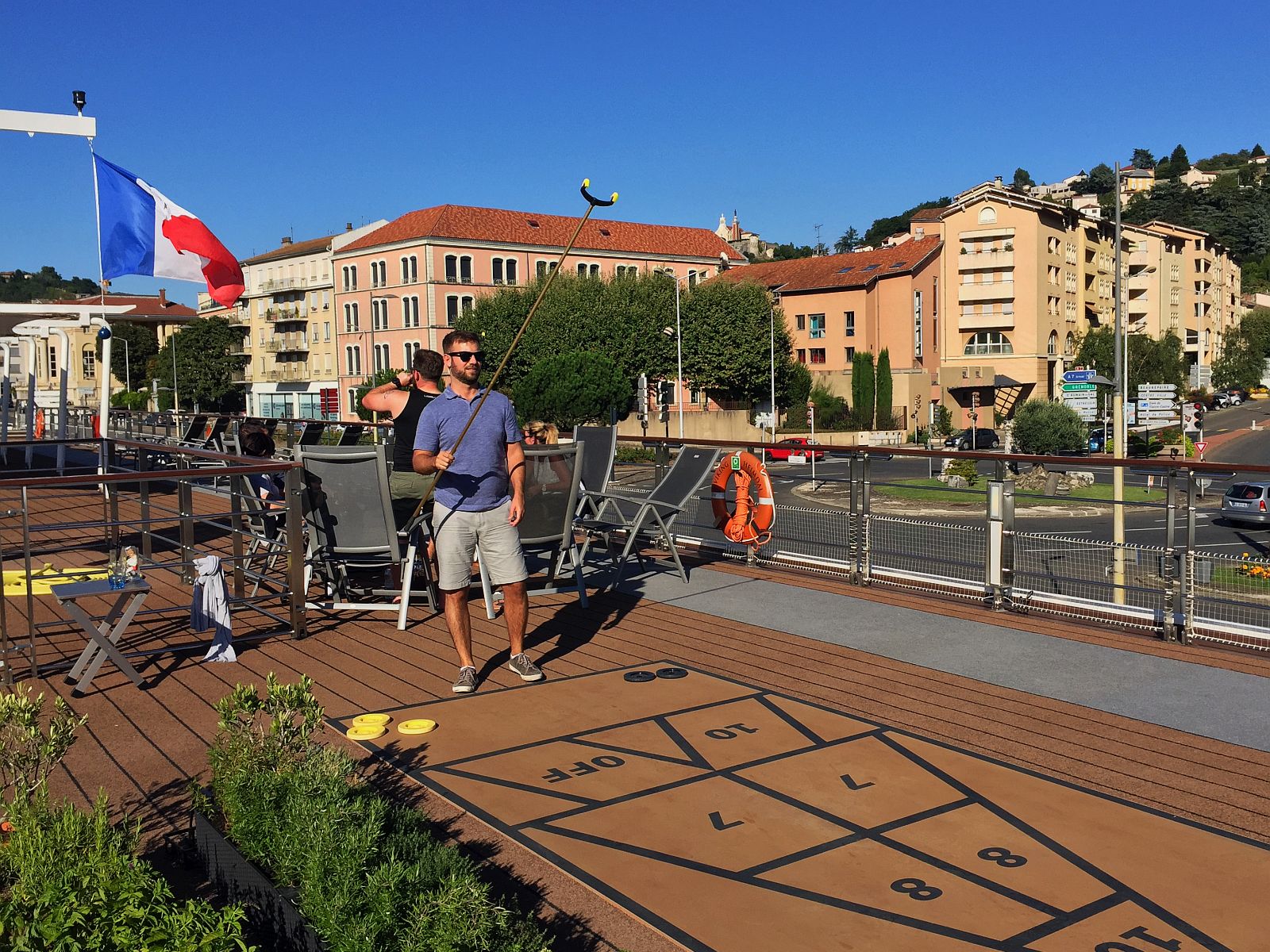
As I sat in the lounge of our longship nursing a freshly poured glass of wine, I looked around the room. Of the roughly 150 or so people attentively listening to the Entertainment Director’s welcome introduction (one of eight such all-hands-on-deck speeches we would hear over the next eight days), I found I could group the passengers into one of three distinct groups — except me, clearly the odd man out.
Roughly seventy percent of the boat were those one could refer to as Seniors: retirees, couples who were still working but whose children were in the reproductive stages of their lives, a surprisingly large number of widows traveling in bunches of three to four.
This particular cruise was earmarked for a gay and lesbian-themed group booking, which made up about twenty percent, and who I was to later learn easily made up the majority of individuals that had purchased so-called “Silver Packages,” which meant unlimited drinks and access to the top shelf-level bottles without incurring additional charges to their bill.
The third group, maybe eight percent, were well-heeled couples, mostly from Europe, that out-dressed us all come dinner time.
Then there was me. Actually, then there was me and one group of three Coloradans that — when combined with myself — made up the population of the boat born after the Carter Administration (okay, technically Carter served less than a year after I was born, but I’m rounding up here). We made up the final two percent, and our common thread was that we all enjoyed day drinking-friendly games (shuffleboard, Yahtzee, Scrabble) and day-drinking itself.
We, collectively, would be spending the next eight days cruising the Rhône River with Viking Cruises, beginning from the river’s mouth where it feeds into the Mediterranean up to Lyon, about 200 miles in total. Copious amount of wine and French cooking would be consumed, river locks would be admired in groups, and about 2,000 years of history would be condensed into daily excursions to some of the most picturesque, admired and most visited cities and villages of France, all under the Provençal sun in August. I’m not sure it gets much better than that.
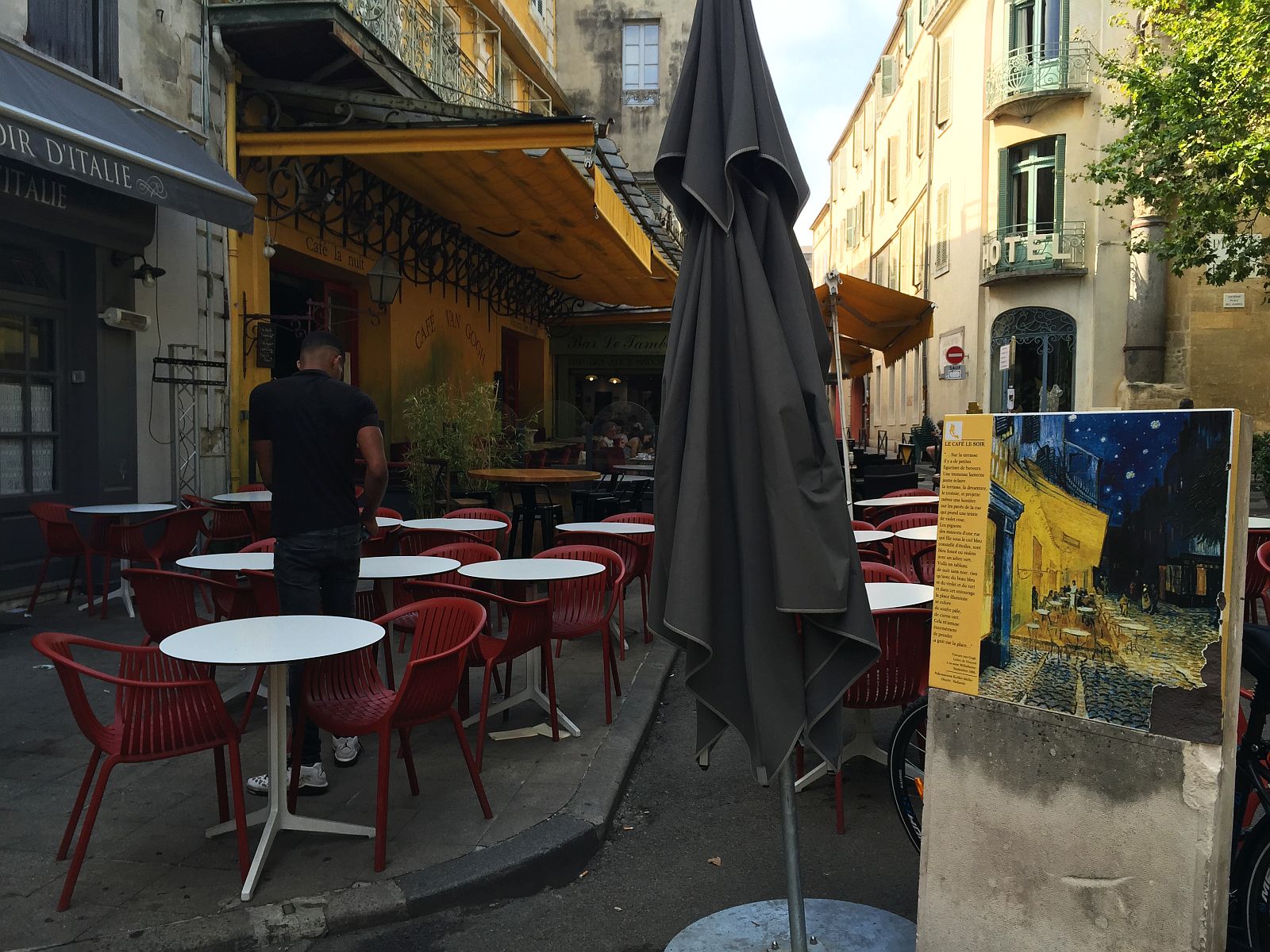
Earlier in the year, I was invited by Viking Cruises — one of the largest and best-known cruise companies in the world with 64 boats floating around the world — to take a cruise with them, and I jumped at the chance to take their Lyon and Provence eight-day river cruise, which includes port-of-call stops in Arles, Avignon, Viviers, Tournon and Lyon. This also included daily excursions to nearby vineyards, medieval villages, goat farms, chateau-turned-wineries and horse farms.
The first day began with a drive through endless fields of sunflowers to Arles, where we were to explore the many Roman ruins that are amazingly preserved in the center of town, including Les Arène, built by the Romans in the early 2nd century AD and that could hold 20,000 spectators during its heyday, as well as the Théâtre Antique, an outdoor theater from the 1st century BC.
Arles, of course, is probably most famous for not what it is but who called it home for a little over a year: one Vincent Van Gogh. And at mid-morning, we found ourselves in the courtyard of the hospital where Van Gogh was admitted after cutting off his ear. The motivation was unclear, history just tells us his favorite prostitute was given it as a gift. In fact, unknown to me at the time, but Arles is home to sites that were the subject of some of his most famous paintings. As any college Freshman who recently decorated their dorm could probably tell you, these include Café Terrace at Night, Bedroom in Arles, and Starry Night over the Rhône.
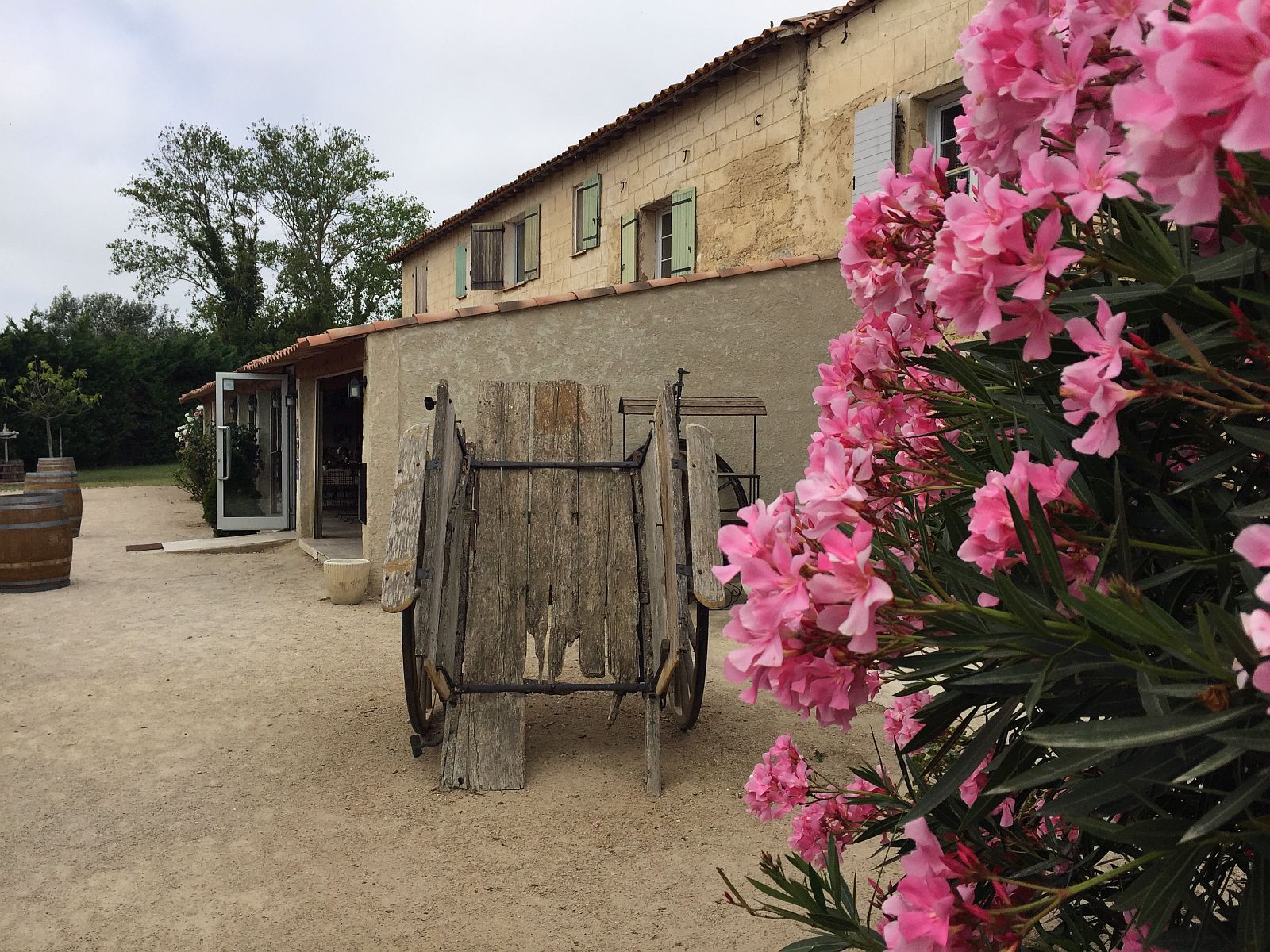
Afterward, we drove south about an hour to the Camargue, France’s protected Rhône River Delta region, home to centuries-old horse and cattle farms, weekend beach villages and about 500 species of birds. Think the Mississippi Delta region, but instead of Hurricanes there is wine, and instead of alligators there are cows.
We stopped for lunch and cow-viewing (yes, really) at La Manade Des Baumelles, a working horse and cattle farm where we followed our gut-busting meal of charcuterie and roasted chicken with a tractor tour of the grounds. We were shown the iconic white-haired Camargue horse that has called this area home for centuries, as well as a lugubrious group of black, long-horned Camargue bulls (one of two breeds used for fighting in Europe) that were content in resting under the warm sun while we drove by taking pictures. Oh to be a breeding bull raised in the South of France — what a way to spend your life!
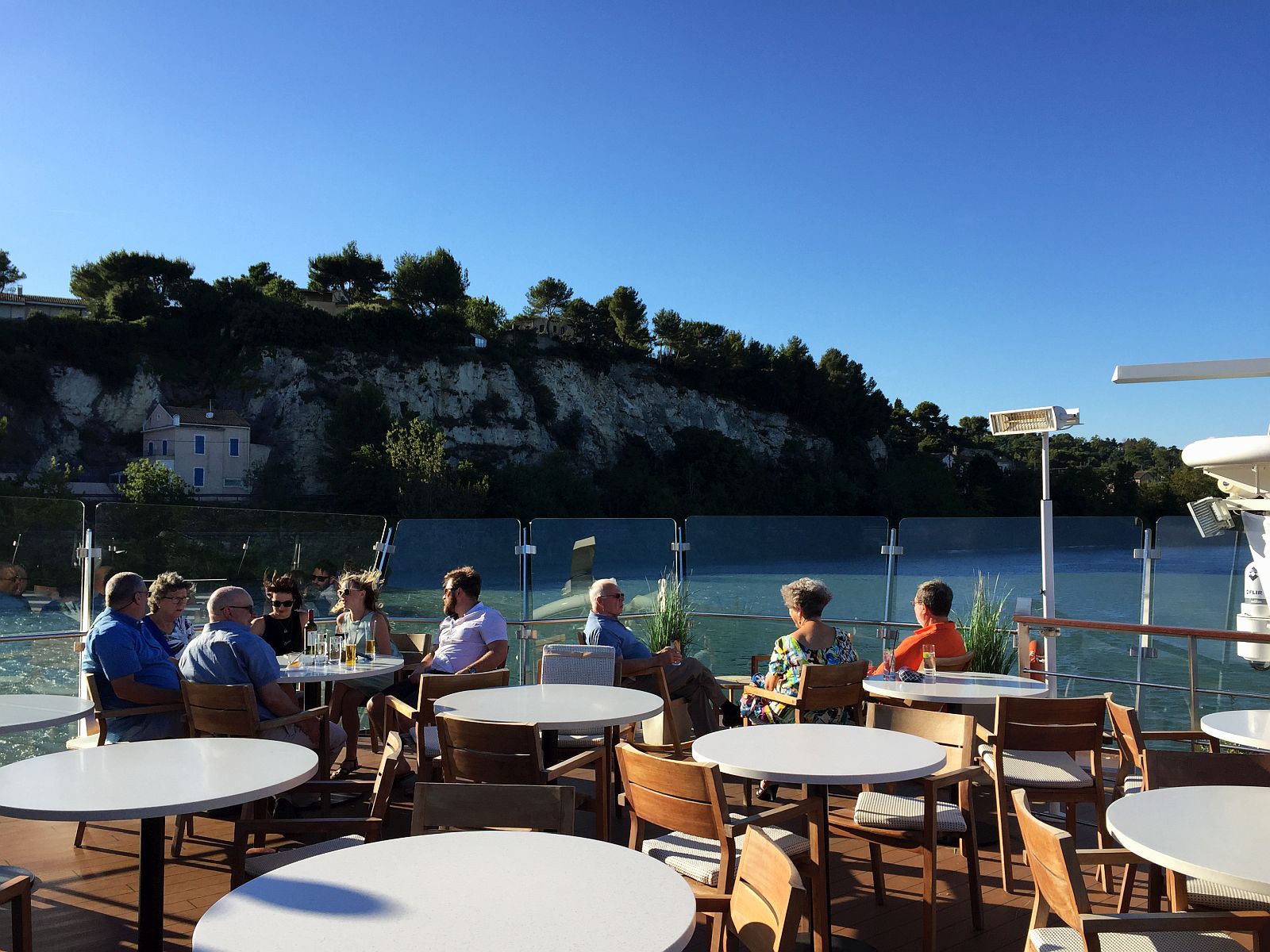
I can’t say I’m much of a cruise traveler. So what was it like spending eight days on one? In all honesty, I’ve got to say, it wasn’t bad. Wasn’t bad at all. Life on a river cruise tended to be a bit more regimented than I was used to during civilian life back on land. On the boat, as is custom on cruise ships, each morning a detailed itinerary was slipped beneath my cabin door (the Viking Daily), assumedly by the friendly Hungarian woman who somehow remembered my name from the moment I introduced myself. (One day I casually mentioned to her that the rules of Shuffleboard were a bit fuzzy to me, and a printout of regulation shuffleboard rules were delivered to me the next morning along with my Viking Daily.)
Breakfast would be served for about two-and-a-half hours, followed by the hustle and bustle on par with morning rush hour. At this time everyone would check back into their cabins and collect their sunglasses, wide-brimmed hats, cameras, day bags and complimentary Viking-branded water bottles and congregate outside to be grouped into one of eight or so guided tour groups. The tours would usually wrap up a few hours later, followed by another leisurely meal either inside where you could have a sit-down lunch, or at the cafe where you could take your meal outside to the deck and watch the waters of the Rhône peacefully glide by.
Following lunch, people usually grouped themselves into one of two camps: the nap in the air-conditioned lounge with a cocktail by their side camp, and the head back out into the world and take part in learning about French history and culture camp, the latter of which meant you were taking part in one of the many daily scheduled excursions for the day.
Perhaps underestimating my need for a daily afternoon nap during a weeklong stretch where the words “seconds” and “dessert” were used more than the entirety of the rest of the year, I signed up for every single afternoon excursion offered, which is how I found myself one afternoon in Avignon as part of a group walking the Passage de l’Oratoire and Rue Saint-Agricol, taking tiny shots of locally produced olive oils and downing macaroons from local shops.

Our small group consisted of two women whose husbands were back at the boat (they were part of the nap camp), and a couple from New Jersey who easily spent in Euros at the macaroon shop what I had allotted as my daily budget. What we were really excited about that afternoon was the fact that we were scheduled to take a cooking class by a local chef at La Maison de Fogasses, a one-time mansion dating back to the 12th Century. The building, owned by Avignon local Corinne Guyon, was recently converted by her into a long-stay artists colony complete with a pétanque court and a popular cafe in its backyard.
After we arrived, we were led out back for a quick glass of wine — we were about to handle cutlery of course — then ushered upstairs to the kitchen of Chef Anthony Rossi who had us in short time kneading dough and brushing liberal amounts of butter on what would be our own prepared batch of the classic pastry Fougasse, complete with traditional Herbes de Provence (a mixture of Rosemary, Thyme and Oregano).
This was followed by a lunch of Fish Provençal (thankfully not prepared by us), wild rice and more wine (notice a pattern here?), all of which I scarfed down in a so-very-not-French way. But I had good reason: I had to make my way back to the quay to catch the bus for the other afternoon excursion: Châteauneuf-du-Pape.
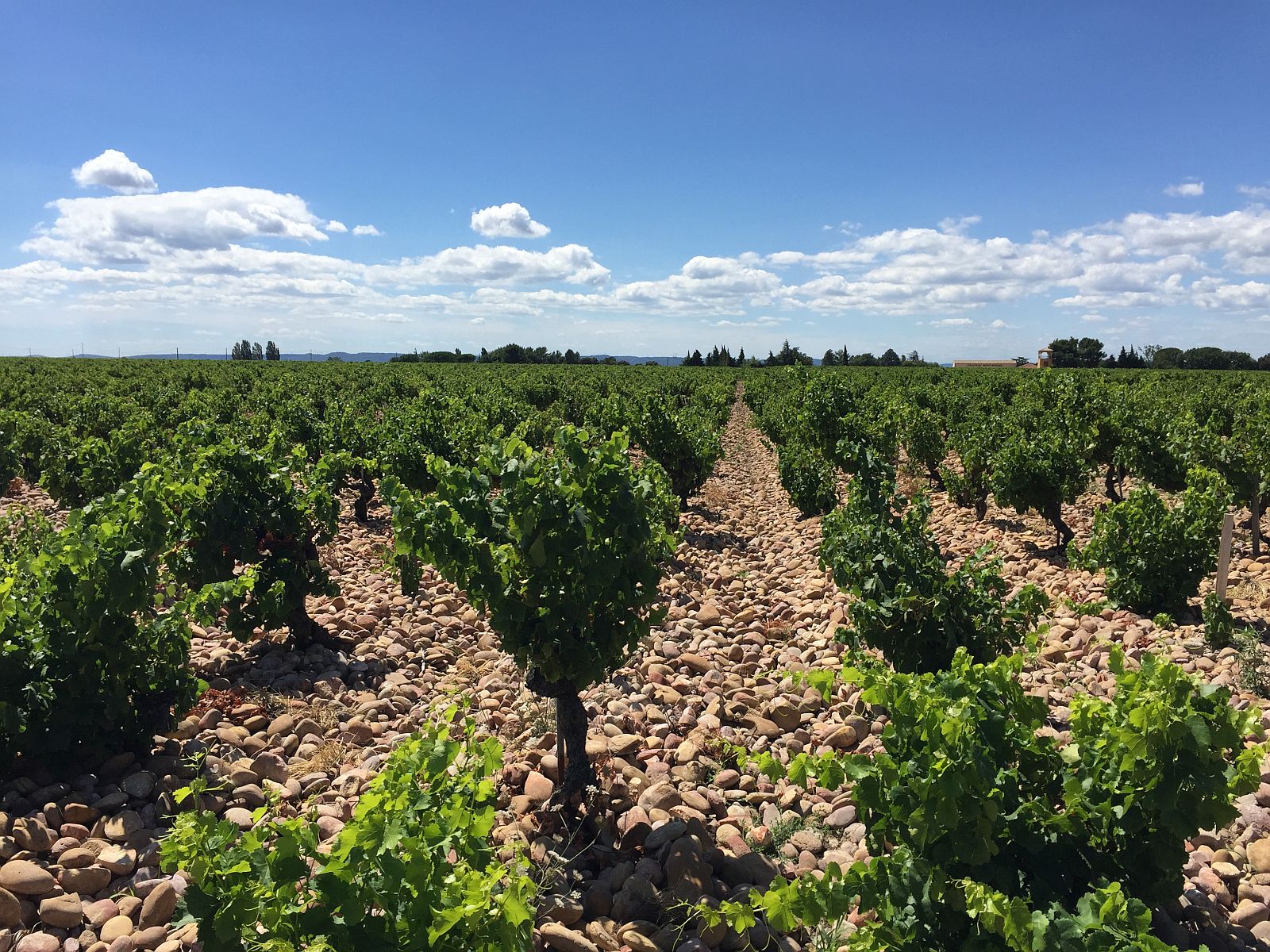
Châteauneuf-du-Pape is famous as home to the medieval castle built as a summer home by Pope John XXII and of course for its wineries. Our bus pulled up to the grounds of the Domaine Bosquet des Papes vineyards, and the unique terrain quickly became apparent. Since this area is essentially an ancient river valley, the short, stubby vines were growing out of a sea of galets roulés, or round rocks, that had once been at the bottom of the river and were now covering the thick clay soil where the roots dig deep in search of water. The rocks are famous for regulating the temperature of the ground — blocking the sun during the day, then slowly releasing it over the night hours — which causes the mostly Grenache, Syrah and Mourvèdre grapes to ripen quicker than normal.
This was followed by a wine tasting and much-needed instruction at the winery Maison Bouachon, where I will forever be remembered as the person at the table who helped ensure his neighbors’ glasses were fully emptied before each new tasting through his own heroic consumption. I think we then saw what appeared to be some sort of medieval festival taking place back in town — I remember people in chain mail wielding swords and lots of cured meat being sold on the street — but this part of the afternoon starts to become fuzzy in my memory (see: wine tasting with groups of age 70+ women).
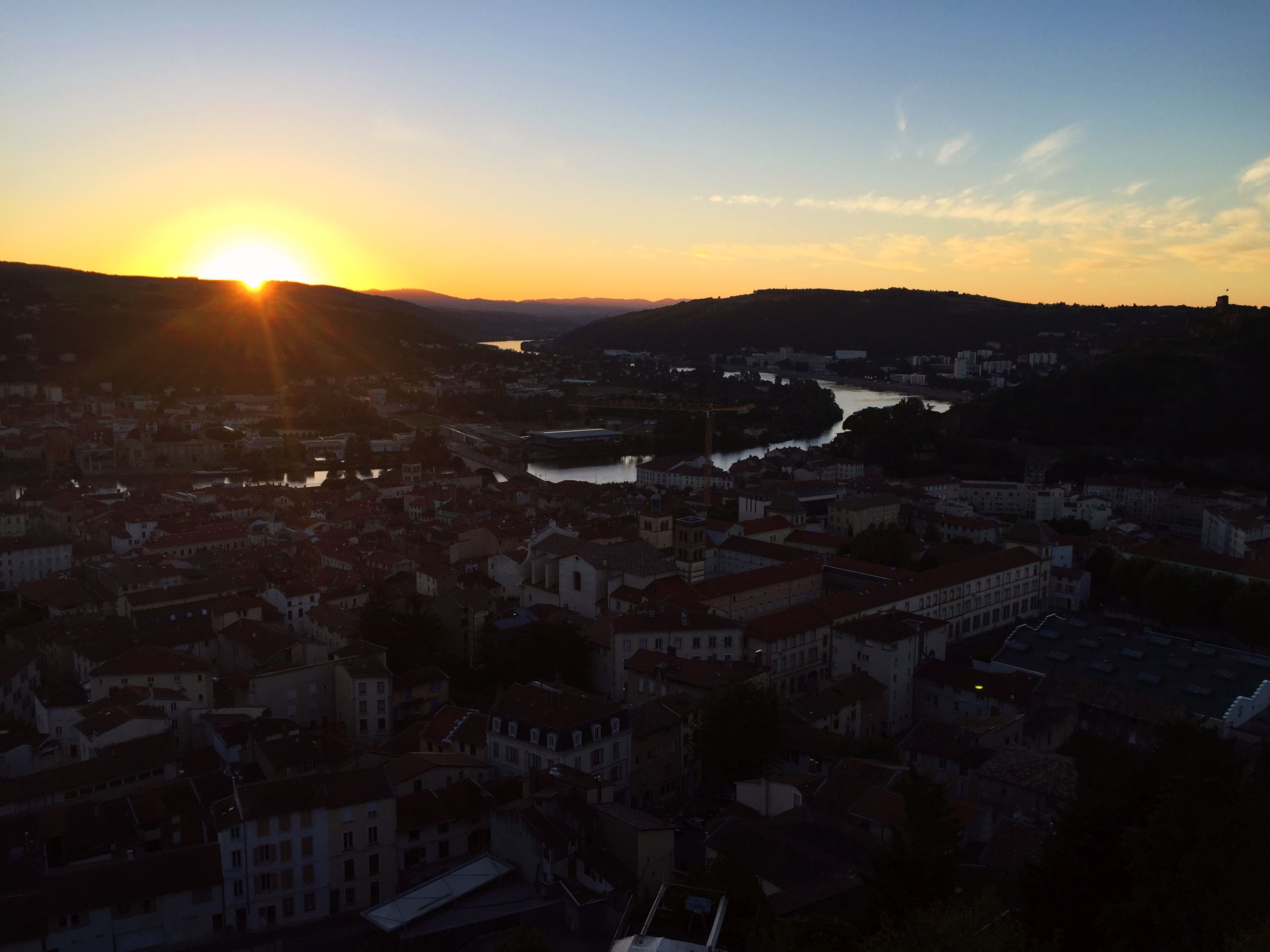
Not to stress this too much, but tours are not exactly my thing. However, the quality of the guides partnered with Viking at each stop were easily the highlight of the trip. Oh to come back to life as a summer tour guide in the South of France — they’re really giving the black bulls a run for their money on my list of humans and/or people I want to come back as in my next life.
Yes, I felt a little goofy carrying around the wireless headsets the guides has us use — this coming from a traveler that perhaps too proudly avoids all variations of guided tours — but the number of facts, enthusiasm in which to share those facts, and the patience to repeat said facts to each person who suddenly was having trouble operating the headset (this seemed to happen to a member of the group about every 10 minutes) was an indelible addition to the trip.
This perhaps was best exemplified by our guide at Vienne. Once a major Roman colony founded by Julius Caesar in 47 B.C., this small city about 20 miles south of Lyon is home to some of the best preserved relics and sights left over from the Roman period. Our first stop was to the Musée gallo-romain de Saint-Romain-en-Gal, a modern structure situated on the western slope of the Rhône, home to an impressive collection of Roman artifacts, including frescoes that adorned the foyers of large mansions, to kitchenware and furniture that had been buried for over 2,000 years.
Outside the museum is a preserved excavation site that features the foundations of the many mansions that called this river plain home. From our elevated vantage point at the museum, our guide dryly pointed out that a school was supposed to have been built there, but the inconvenience of finding an invaluable archaeological site forced city planners to relocate the new school’s location further up the road.
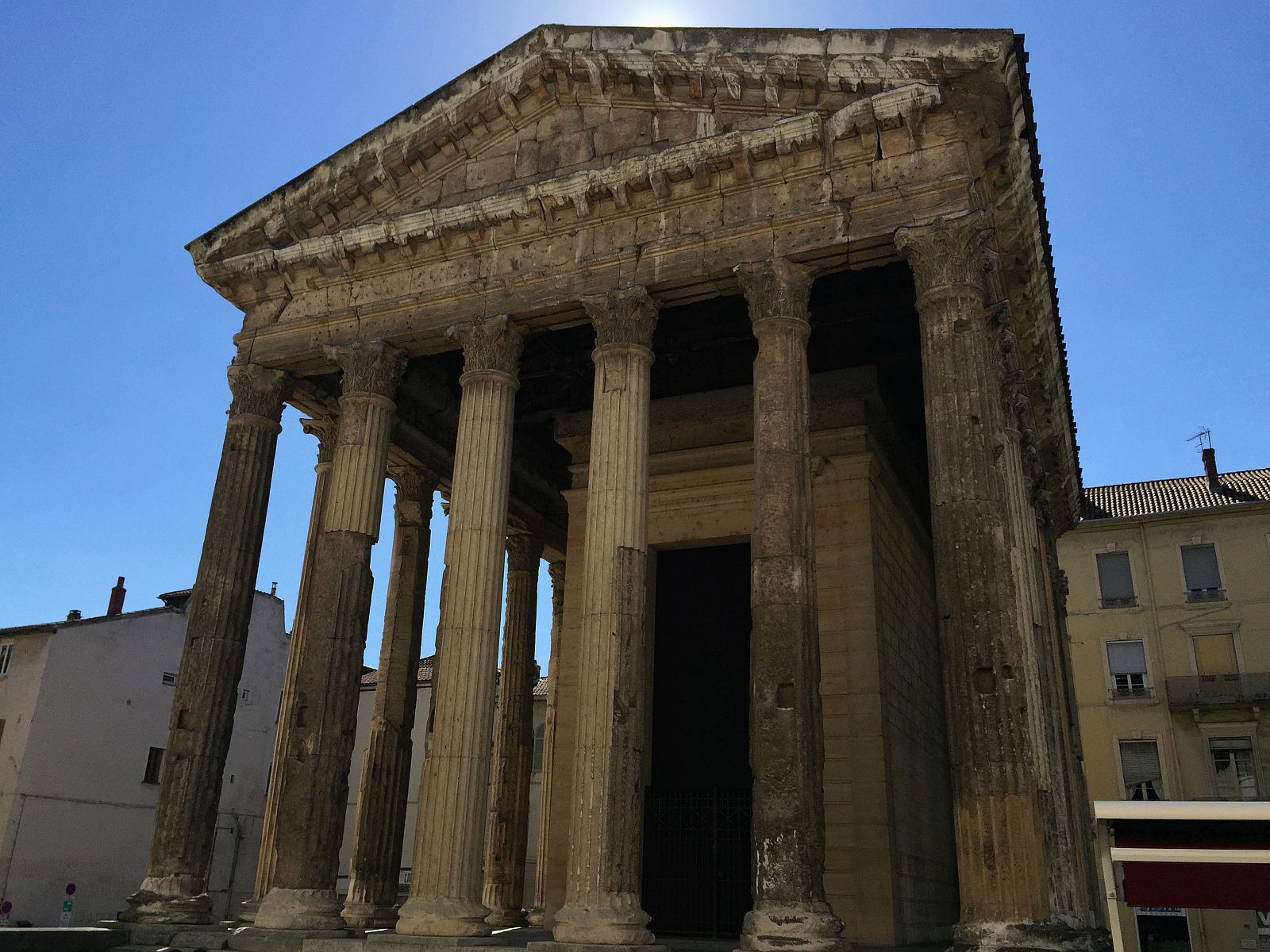
We then traveled into town where the highlight of Vienne is revealed suddenly as you emerge from one of the many narrow streets leading to its center. Here, surrounded by mid-century apartment buildings and a number of cafes dotted across the open plaza, is the Temple of Augustus & Livia. Closely related to its more famous cousin, the Maison Carrée in Nîmes, the Temple is a beautifully preserved temple that dates back to 1st Century and is considered one of the best preserved Roman Temples in the world.
Our guide pointed to many small details about the facade of the temple, including signs it was temporarily converted to a Christian church, thus sparing it from destruction over the years (later, during the French Revolution, it was used for secular purposes, once again thankfully helping it to avoid destruction).
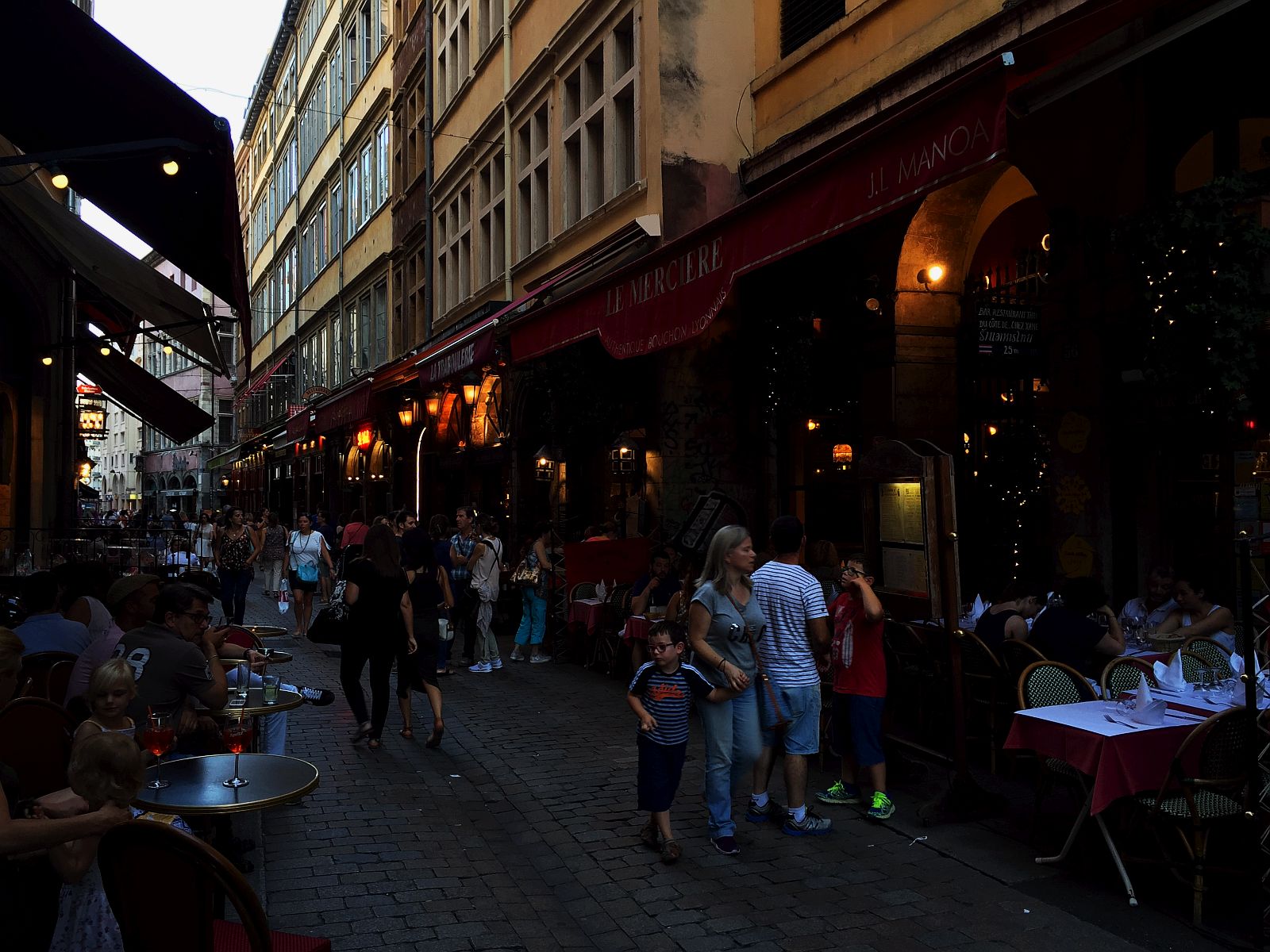
Our last port of call on the trip was Lyon, France’s third-largest city, and the country’s unofficial gastronomical capital (Lyon is the birthplace of famed chef Paul Bocuse). Lyon is also where the Rhône meets the Saône after emerging from high up in the Alpine mountains to the east, then effectively doubling in size and turning south toward the Mediterranean in the center of the city.
We docked next to the University of Lyon, a central spot just south of the ornate Pont de l’Université, which you can cross to get to the 1st and 2nd Arrondissements, then over the Saône and into Vieux Lyon, the district that can date its history back to the Renaissance Era.
Walking along the narrow cobblestone Rue Saint-Jean today, you will mostly see small cafes, English-style pubs, restaurants and few dozen or so ice cream shops catering to the masses of visitors that descend upon the city during the summer months and the city’s large University population. But, if you look hard enough, and you are with the right guides, you can try a few doors along the street and enter into public courtyards surrounded by homes that date back to the 16th Century. You can still see the small fountains where water would be gathered, and you can gaze up at the balconies overlooking the courtyards.
Lyon was also known during the German occupation as the “Capital of the Resistance,” and the many narrow passageways, secret entrance ways and above-ground walkways in the Vieux Lyon were perfect for Resistance fighters to escape capture from their occupiers.
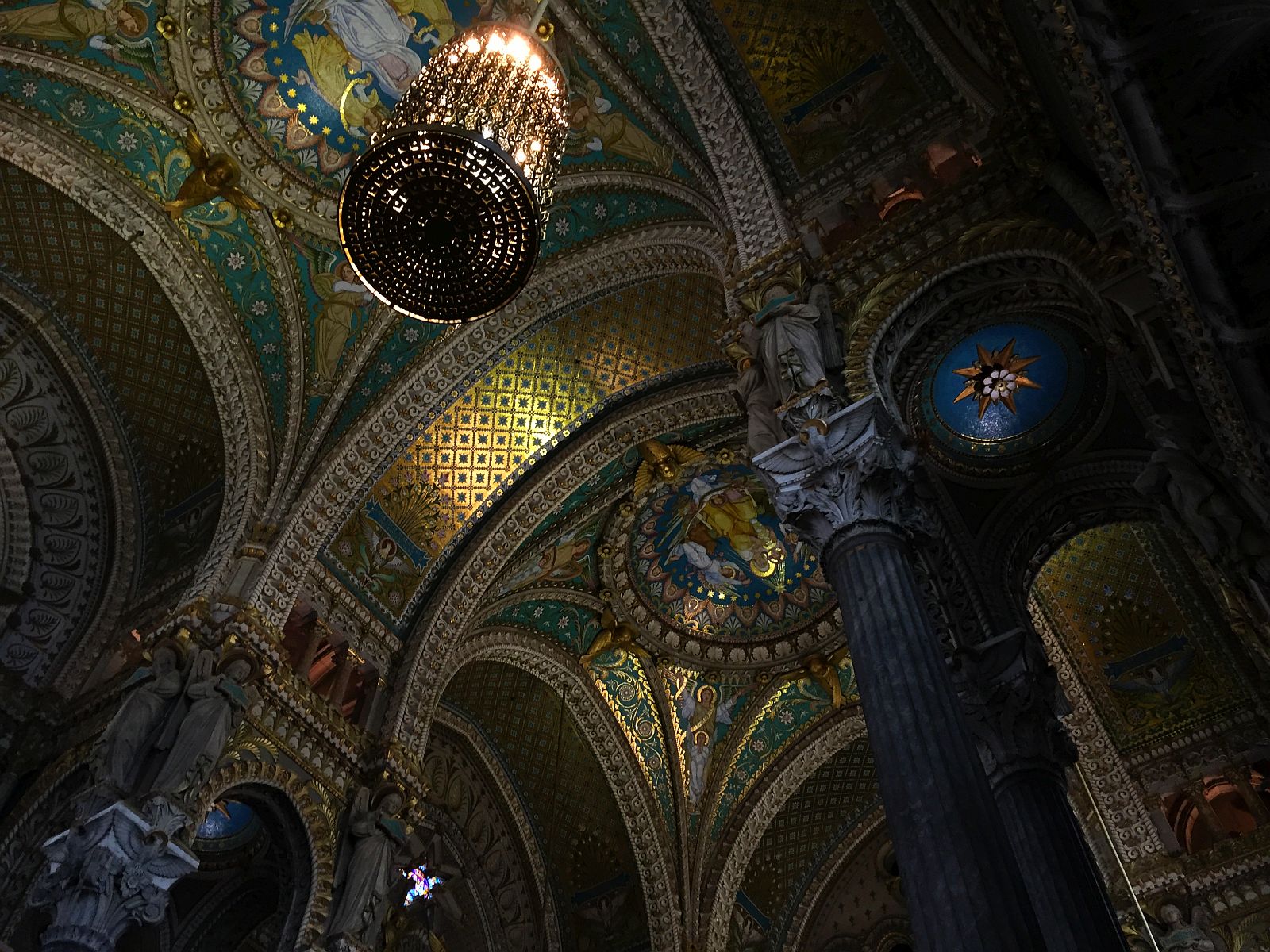
Towering above the district is Fourvière hill, where the city’s most famous basilica, La Basilique Notre Dame de Fourvière, sits above the city and provides the best panoramic views of Lyon.
After a morning of exploring, we set out for the nearby village of Perouges, affectionately known as one of the most beautiful villages in Europe. Located a short 45-minute drive from Lyon, Perouges is a preserved hilltop Medieval village that can date its origin back to the 12th Century.
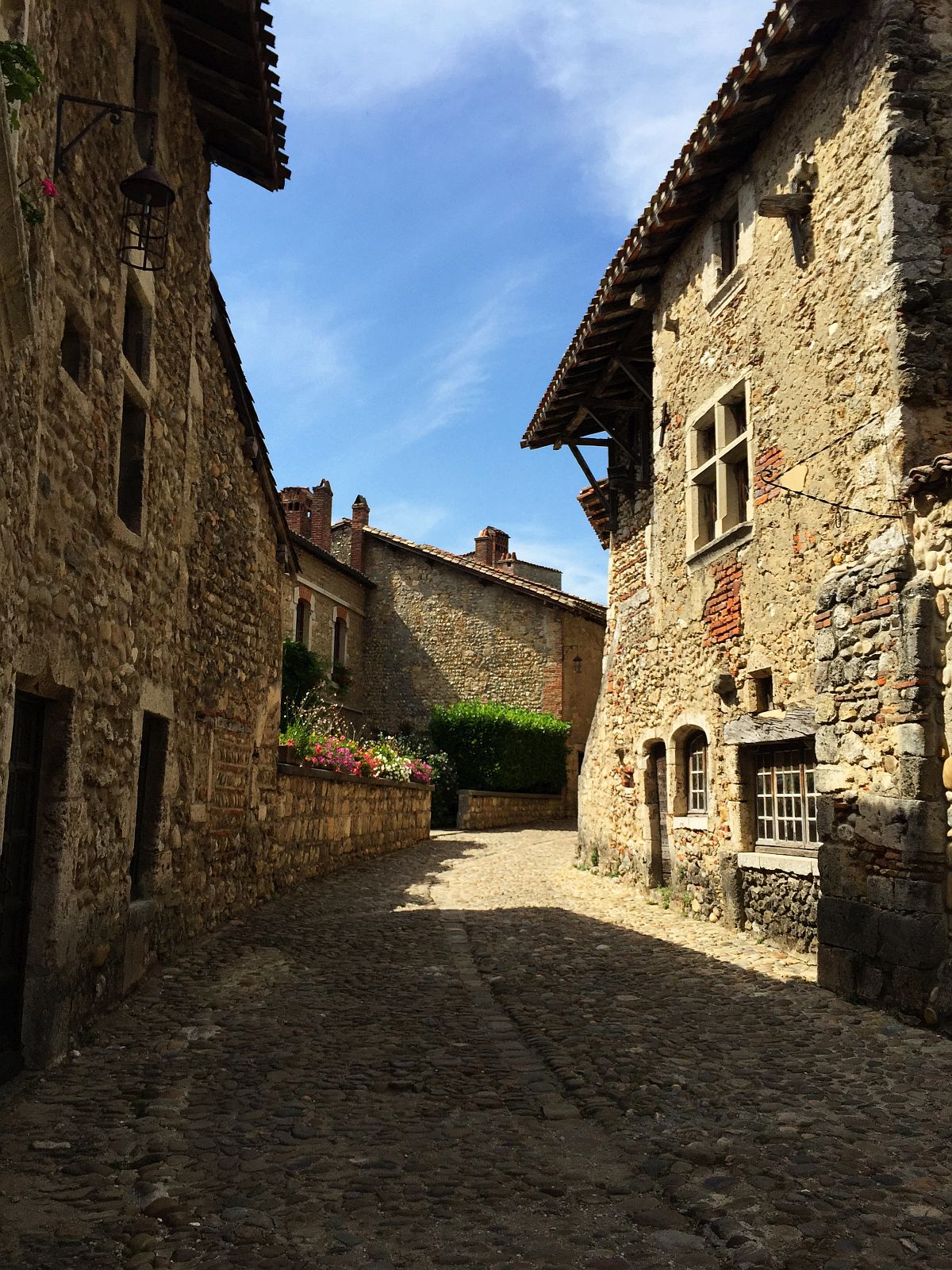
As soon as you walk past the stone walls that had protected the village for centuries, you are transported back into time. The village’s thousand or so inhabitants are required to maintain the stone facades of their homes and shops, and you are free to wander along the circular cobblestones streets, stopping into the many craft shops and restaurants that welcome visitors throughout the year. The image of small Peugots that come slowly rumbling down the street is a jarring contrast to your surroundings, but is a nice reminder of how France has worked hard to balance its history with the needs of contemporary life.

On our final day of the cruise, our last excursion was north to the famed Beaujolais and Burgundy wine regions. As our bus climbed north of the city and along the Saône, we were greeted by miles and miles of Gamay vineyards, a purple-colored grape that produces a light-bodied, fruity wine, and which were destined to make it to some of the world’s most coveted bottles.
The region is filled with countless small village dedicated to the centuries-old history of wine-making, and a drive through the area can easily conjure up images of dropping everything and starting your own winery, a tradition that has been the root of draining more retirement accounts throughout the years than probably any other activity.
Of course, when there’s wine there’s great food, and our final visits of the day were to a local truffle and goat farm. First we pulled up to Le Cos-Piguet, where a spirited and well-trained canine truffle hunter, Chinook, and his owner, Olivier Devevre, greeted us then led us up a gentle hill to a fenced-off orchard where the magic happens.

Here a grove of Oak Trees are hosts to truffles that grow in and around the fertile tree’s roots, and are best discovered by the sensitive nose of man’s best friend. Olivier demonstrated us Chinook’s sniffing capabilities by letting him wander around the grounds until he would stop suddenly and began furtively digging for his prize. We were then led inside to their farmhouse to try their homemade truffle-infused butter that we liberally spread on slices of bread.
Finally we traveled to nearby Chevrerie La Trufiere, a goat farm founded by Sylvain Chopin, and which is home to a herd of 150 or so very friendly Alpine goats, a breed known for their ability to produce milk and to make mischief by climbing as high as they can in whatever surroundings they are in at that time (I saw about 5 goats precariously perched on a window sill above the rest of the herd with little indication as to how they made it that high).
After a long visit petting and feeding our new furry friends a mixture of hay and alfalfa, we we were led inside for a tour of their dehumidified refrigeration units where the cheese is aged, and given a taste of the various varieties they create. All of course accompanied by even more wine.
I couldn’t think of a more fitting way to have spent the day. Good food, artisanal cheese, lots and lots of wine, an exploration of traditions that date back generations. Oh to come back one day in a future life as someone who spends their summer days traversing a river through the South of France. Life couldn’t get much better.

/
 Matt Stabile is based in New York City, and is the founder and Editor-in-Chief of The Expeditioner which was founded in 2008. You can read his writings, watch his travel videos or contact him via email at any time at TheExpeditioner.com.
Matt Stabile is based in New York City, and is the founder and Editor-in-Chief of The Expeditioner which was founded in 2008. You can read his writings, watch his travel videos or contact him via email at any time at TheExpeditioner.com.
The post I Took A River Cruise Through The South Of France. Yes, Really. appeared first on The Expeditioner Travel Site.
]]>The post The Top 50 Travel Blogs (4th Quarter: 2016) appeared first on The Expeditioner Travel Site.
]]>
Below is a list of the top 50 travel blogs for the 4th quarter (October — December) of 2016 ranked by visitor traffic.
There are a few other sites that have put together their own lists of the “top” travel blogs. However, each has their own subjective means of ranking sites, using everything from Alexa scores, Twitter followers, Facebook likes, estimated traffic, inbound Google links and even subjective design criteria.
My intention was to create the most objective and accurate list of the most popular travel blogs. Therefore, this list is based solely on the number of visitors a travel blog receives. To read more about how this list was put together, please read below.
I reached out to a large sampling of travel bloggers and asked that they provide me with a screenshot of their Google Analytics page reflecting their site’s visitor statistics over the most recent quarter. The reasoning behind this method was that I wanted to obtain a rolling average to compensate for monthly spikes that may have occurred. Further, utilizing Google Analytics as the uniform measure of traffic helped to ensure uniformity of data across all sampling.
Of course, due to this method of collecting data, only those site owners that submitted their statistics were included for consideration in the rankings. Those that did not submit were not considered. Further, in an effort to maximize the number of participants and to protect specific traffic numbers that some site owners regard as sensitive and private, I agreed to keep all specific data confidential and not include those numbers in the rankings.
Why This Metric?
Simple, it’s the most accurate, best picture of a site’s traffic. As everyone knows, Alexa is not very accurate and can be easily manipulated. Inbound links are a great sign of SEO, but just because a site does well with Google doesn’t mean it has a lot of visitors. Twitter followers are great, but that doesn’t necessarily translate into site readers.
Quite simply, unique visitors is the one metric that most accurately reflects a site’s readership.
Who Cares?
I understand that just because a site gets a high number of unique visitors doesn’t mean it’s the highest quality site. There are plenty of excellently written, well-designed, engaging sites that may not have high traffic numbers.
My intention was not to create a list of the best, or the most useful, or the most professional travel blogs. I simply wanted to create the most accurate list of the most visited blogs. Just as the movie weekend box office results are reported every week, I simply wanted to create an unbiased, objective list of the most visited travel blogs for research purposes.
Finally, I hope this list will serve as a useful guide and a good starting point for travelers and readers around the world looking to explore the vibrant and eclectic travel blogging community, and expose them to some great travel blogs that they otherwise may not be reading.
*
Click Here to Read the Complete Past Lists of The Top 50 Travel Blogs

/
 Matt Stabile is the Founder and Editor-in-Chief of The Expeditioner. The Expeditioner began in 2008 and is headquartered in New York City. You can read his writings, watch his travel videos or contact him at any time at TheExpeditioner.com.
Matt Stabile is the Founder and Editor-in-Chief of The Expeditioner. The Expeditioner began in 2008 and is headquartered in New York City. You can read his writings, watch his travel videos or contact him at any time at TheExpeditioner.com.
The post The Top 50 Travel Blogs (4th Quarter: 2016) appeared first on The Expeditioner Travel Site.
]]>The post How Many Americans Have A Passport? appeared first on The Expeditioner Travel Site.
]]>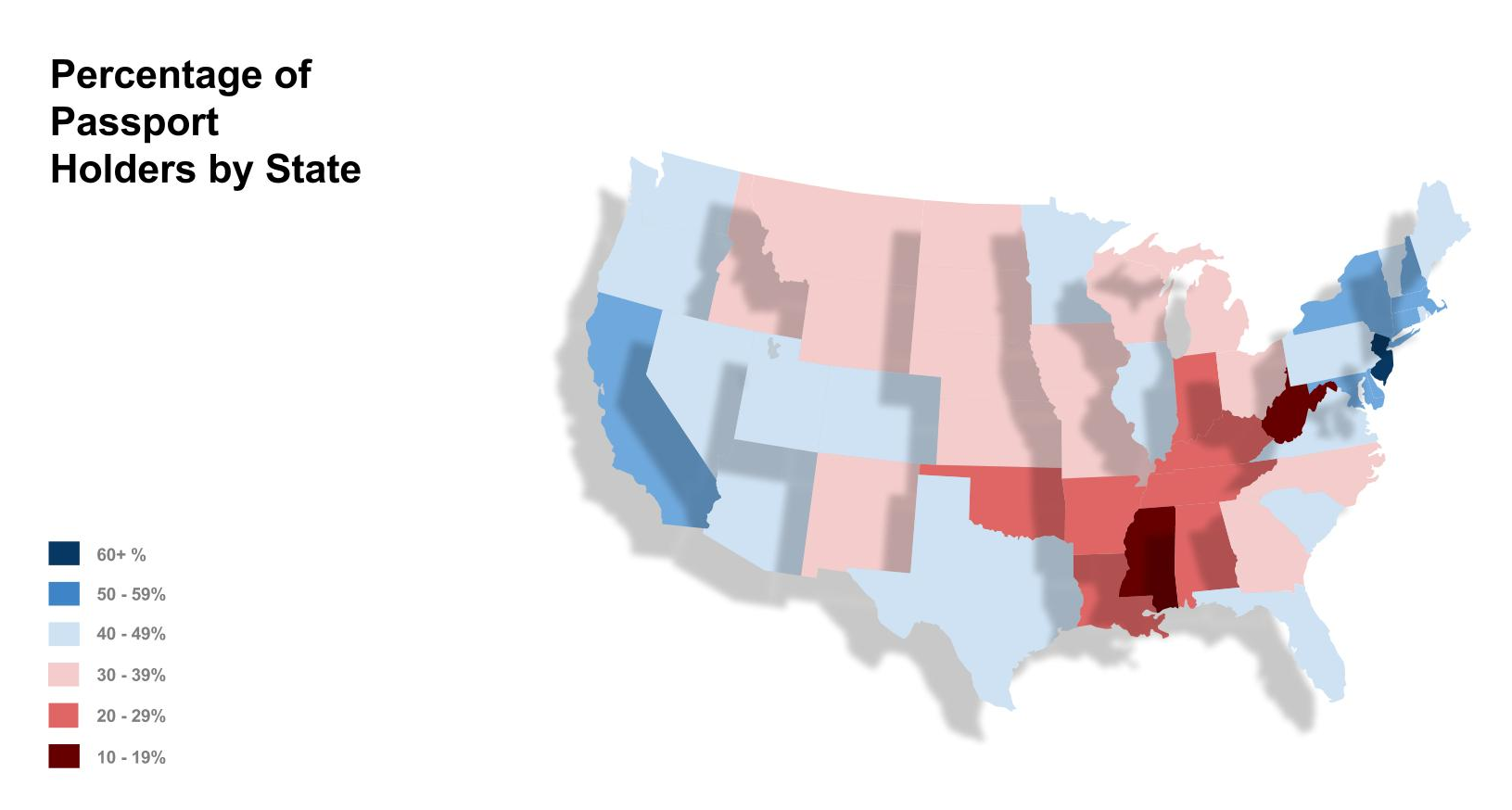
How many Americans have a passport? This was a question a British friend had asked me a few years ago, probably based upon the assumption that much of the world has about Americans, which is that the majority of Americans do not have passports. I had no idea what the answer was, so I decided to do a little research, and the answer is somewhat surprising.
The quick answer is that yes, the majority of Americans do not have a passport. The percentage of Americans who have a valid passport, according to the most recent statistics as tabulated by the State Department, is about 46%. This number excludes passport cards, which are identification cards that only allow sea and overland entry to the U.S. from Canada, Mexico and certain parts of the Caribbean, but not the rest of the world.
To get this number I took the number of outstanding valid passports in circulation as estimated by the State Department — the number is 138,675,021 — and divided that by the total U.S. population according to the Census Bureau, which as of December, 2016, was 325,103,000 (minus the approximately 11.1 million people who are undocumented residents and 13.3 million legal permanent residents that live in the U.S. but cannot obtain passports or have valid passports issued from other countries).
For those keeping score, the fact that 46% of Americans have a passport means that a little less than half the population can’t fly to Canada, let alone travel to any other country in the world.

Has This Number Been Going Up or Down Year-Over-Year?
As reflected in the graphic above courtesy of the U.S. Department of State, 2016 showed a pretty healthy increase in the number of passports issued from 2015, and an overall trend upwards since the 10-year low of 2011. However, given the increase in population year-over-year, the percentage hasn’t actually gone up from 46% over the past few years.
Which States Have the Highest Percentage of Passports?
Here comes the fun part. I decided to take this data and see which U.S. states have the highest and lowest percentage of their population with valid passports. As can be viewed in the top graphic, those states with the lowest percentages are clustered in the South, Midwest, Upper Midwest, and the Great Plains States. Perhaps not surprisingly, those states with the highest percentages tended to be on the border of Canada and Mexico, along both coasts, and those states with higher urban populations.
Mississippi was the lowest, with just 17%, followed by West Virginia (19%), Alabama (22%), Arkansas (22%) and Kentucky (23%). The state with the highest percentage was New Jersey with 62%, followed by New York (59%), Massachusetts (58%), and Alaska, Connecticut and Delaware (all were at 55%).

I decided to then compare my state-by-state calculations with the results of the recent 2016 presidential elections. As can be seen above, there is a striking correlation between the states that voted for Trump in 2016 and those states with the lowest number of passport holders. Those states that voted for Clinton had the highest percentage of passport holders (Alaska is a notable exception — a state which is historically conservative, but not surprisingly has a high percentage of passport ownership given its remote location).
In fact, the top 19 states with the highest percentage of passport holders (states where at least 44% of the population has passports) were all states that voted for Clinton (Alaska was the sole exception). Alternatively, the bottom 11 states in terms of passport ownership all went for Trump.
Of the bottom half of states with the lowest percentage of passport holders, only 1 of those states went for Clinton (New Mexico). Of the top 25 states, only 6 voted for Trump (24%).
Below is a sortable list of all 50 states and the percentage of each state’s population that has a valid passport.
| STATE | PERCENT |
|---|---|
| ALABAMA | 22% |
| ALASKA | 55% |
| ARIZONA | 40% |
| ARKANSAS | 22% |
| CALIFORNIA | 52% |
| COLORADO | 48% |
| CONNECTICUT | 55% |
| DELAWARE | 55% |
| FLORIDA | 45% |
| GEORGIA | 34% |
| HAWAII | 47% |
| IDAHO | 35% |
| ILLINOIS | 47% |
| INDIANA | 29% |
| IOWA | 34% |
| KANSAS | 34% |
| KENTUCKY | 23% |
| LOUISIANA | 25% |
| MAINE | 44% |
| MARYLAND | 50% |
| MASSACHUSETTS | 58% |
| MICHIGAN | 36% |
| MINNESOTA | 48% |
| MISSISSIPPI | 17% |
| MISSOURI | 31% |
| MONTANA | 39% |
| NEBRASKA | 34% |
| NEVADA | 40% |
| NEW HAMPSHIRE | 52% |
| NEW JERSEY | 62% |
| NEW MEXICO | 32% |
| NEW YORK | 59% |
| NORTH CAROLINA | 30% |
| NORTH DAKOTA | 39% |
| OHIO | 32% |
| OKLAHOMA | 28% |
| OREGON | 41% |
| PENNSYLVANIA | 40% |
| RHODE ISLAND | 49% |
| SOUTH CAROLINA | 40% |
| SOUTH DAKOTA | 32% |
| TENNESSEE | 26% |
| TEXAS | 40% |
| UTAH | 42% |
| VERMONT | 49% |
| VIRGINIA | 44% |
| WASHINGTON | 49% |
| WEST VIRGINIA | 19% |
| WISCONSIN | 38% |
| WYOMING | 36% |
Why?
I’m probably the last person in the world to defend anyone who doesn’t have a passport, which by this very fact, completely precludes them from even the opportunity to travel outside the United States. However, rather than attempting to list out the reasons I think this is obviously not a good thing, I thought I’d propose a few reasons why this may be the case.
Money
One factor discouraging foreign travel is quite simply that it’s cost-prohibitive for the average American, many of whom are still reeling from the Great Recession. When factoring in the costs of traveling abroad from the U.S. (which tends to be much higher than other parts of the world given its location), even the cheapest international trip is simply beyond the means for the average American, especially given the lingering effects of the Great Recession and years of wage stagflation for the majority of the country.
Culture
No doubt Americans just don’t have the history and drive that, say, the British have for international travel. In the 2009 edition of The Best American Travel Writing, noted travel writer Simon Winchester had this to say on the subject:
There was essentially no empire (the Philippines, Puerto Rico, and a scattering of Pacific islands excepted), and hence little by way of imperial legacy. The country is formidably isolated by thousands of miles of ocean from almost anywhere truly foreign, and getting abroad is very much more costly. Americans seldom went to seek their fortunes overseas, as British so often did . . . [and there] is little tradition of American exploration (aside from exploration-as-entertainment put on for the benefit of a number of some rather dubious but fashionable clubs and societies).
Further, there is a lack of tradition of Americans traveling abroad given America’s size and therefore lack of need to travel to other countries to experience relatively different geographic and cultural differences.
Then factor in America’s relatively low number of paid vacation days granted by their employers, and you can quickly begin to see the many reasons many Americans simply don’t see the need to obtain a passport.
Maybe It’s Not That Bad
It’s also worth pointing out that although this number isn’t great (and certainly is far below the percentage found in countries in other parts of the world such as in Europe), at least Americans aren’t as bad in this respect compared to, say, the Chinese, where only about 5% of the population has a passport.
Finally, Americans that do have valid passports actually travel a lot. The United States ranks third in terms of the number of departures to countries other than their own (behind Hong Kong and Germany) with 68.3 million trips abroad. A good number, unless you compare that to the numbers from countries with far less populations that rank above or near the U.S. in this statistic (Germany, the U.K., Poland, Canada, Italy and France are right behind the U.S.).
How to Get a Passport
To find out how to get the process going if you don’t have a passport, all you need to do to start is to visit the official U.S. Passports and International Travel web site for the U.S. Department of State by clicking here.

/
 Matt Stabile is the Founder and Editor-in-Chief of The Expeditioner. The Expeditioner began in 2008 and is headquartered in New York City. You can read his writings, watch his travel videos or contact him at any time at TheExpeditioner.com.
Matt Stabile is the Founder and Editor-in-Chief of The Expeditioner. The Expeditioner began in 2008 and is headquartered in New York City. You can read his writings, watch his travel videos or contact him at any time at TheExpeditioner.com.
The post How Many Americans Have A Passport? appeared first on The Expeditioner Travel Site.
]]>
